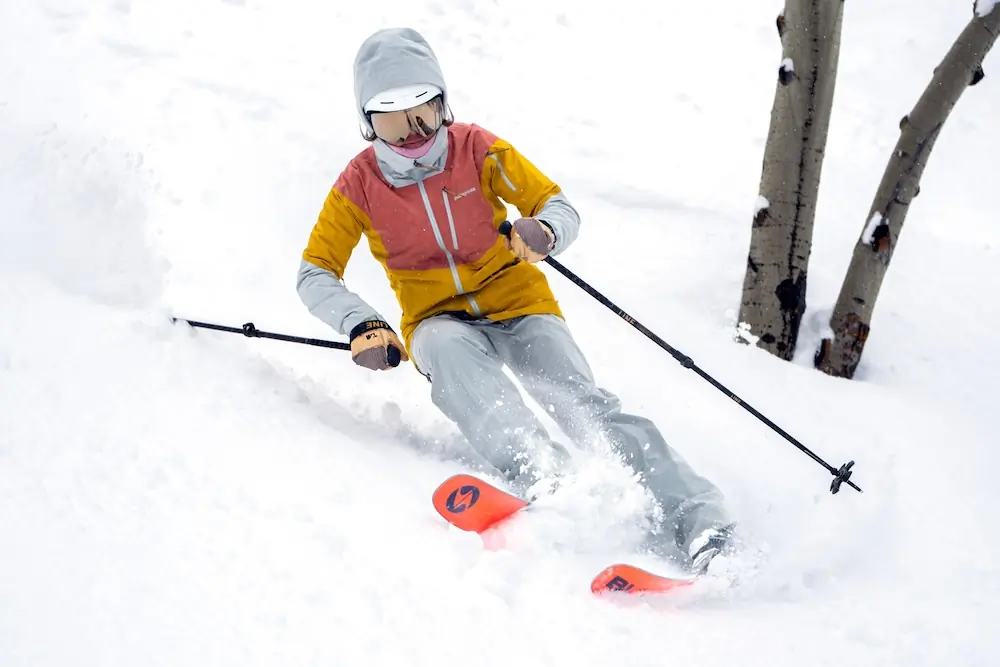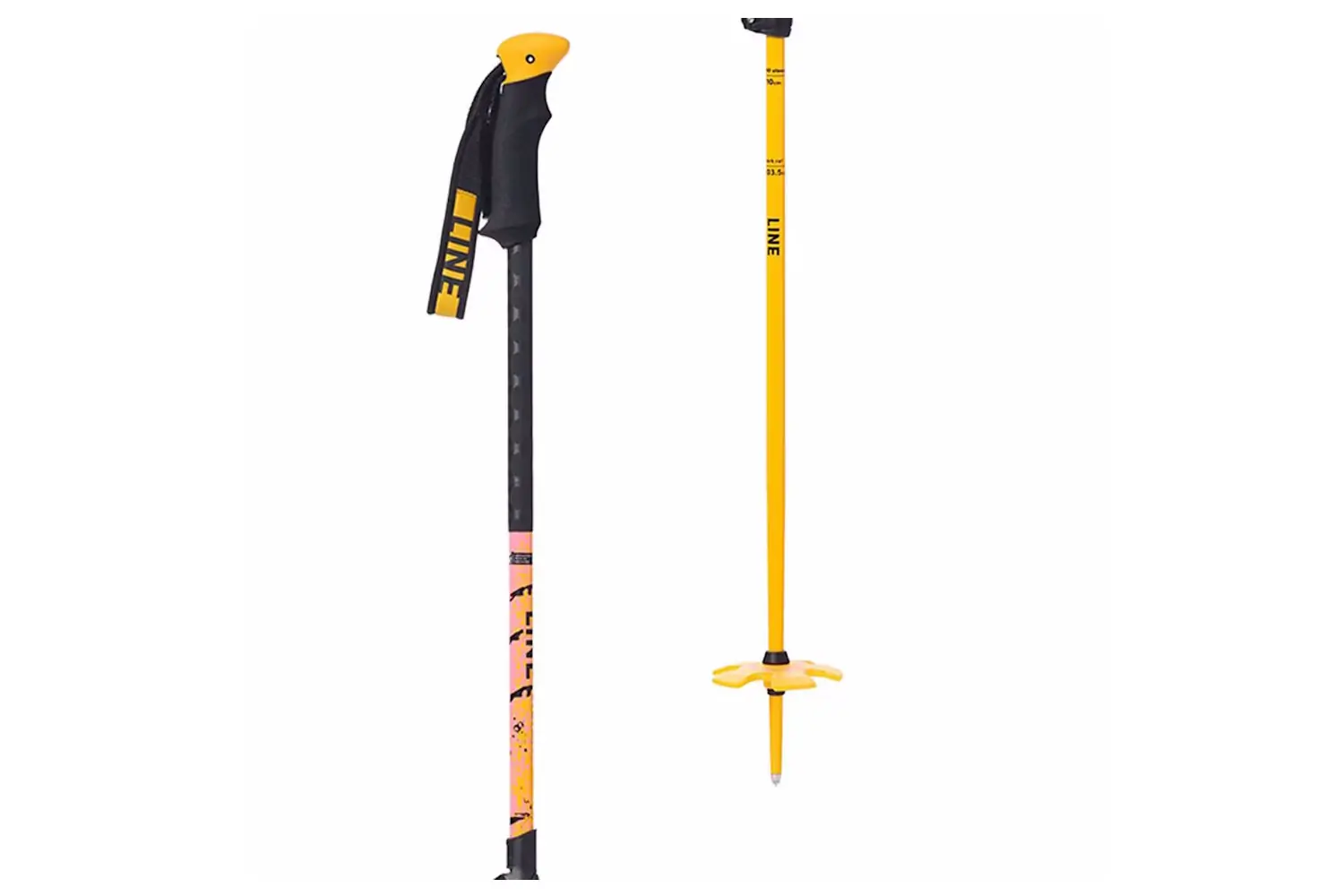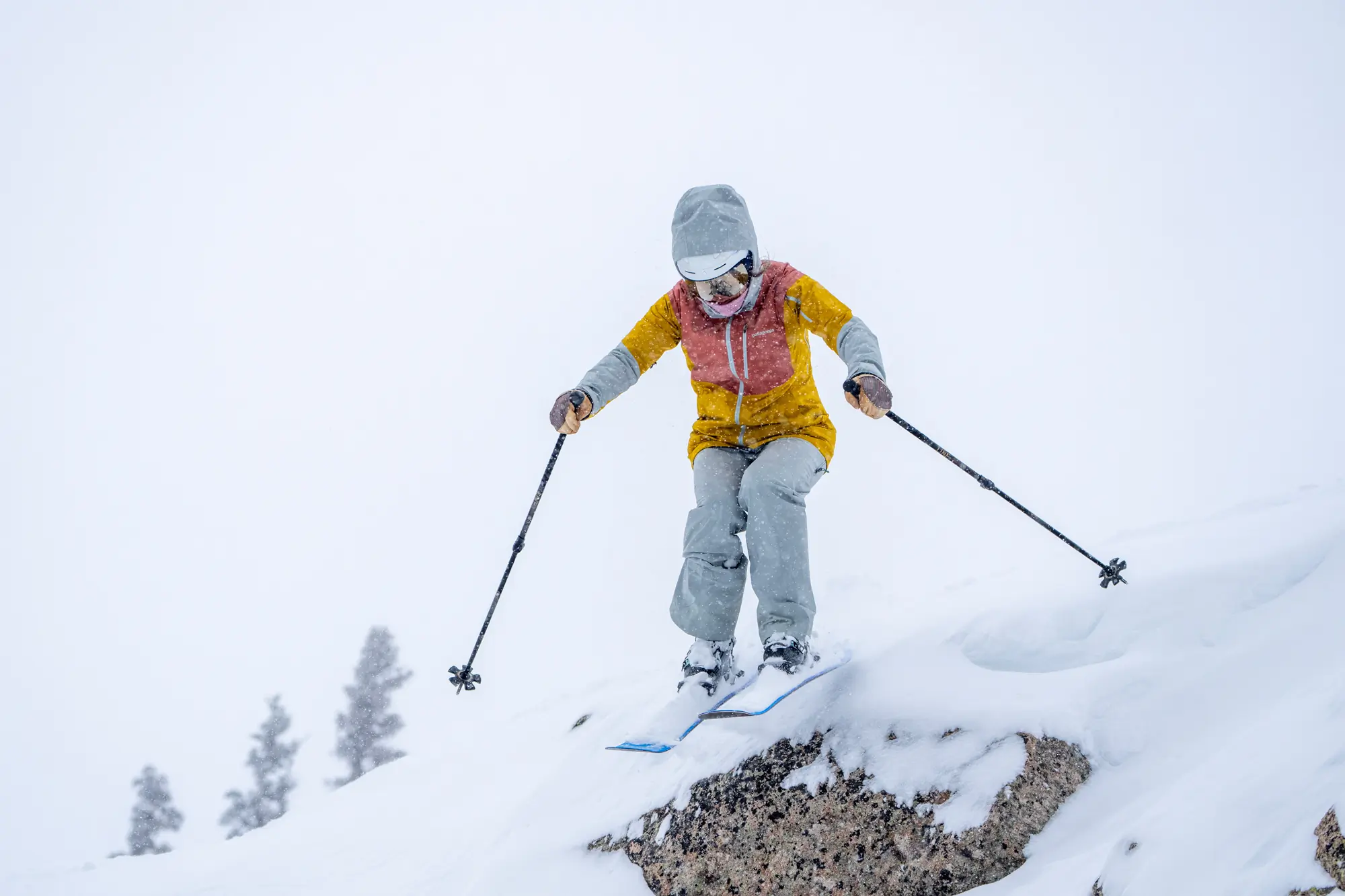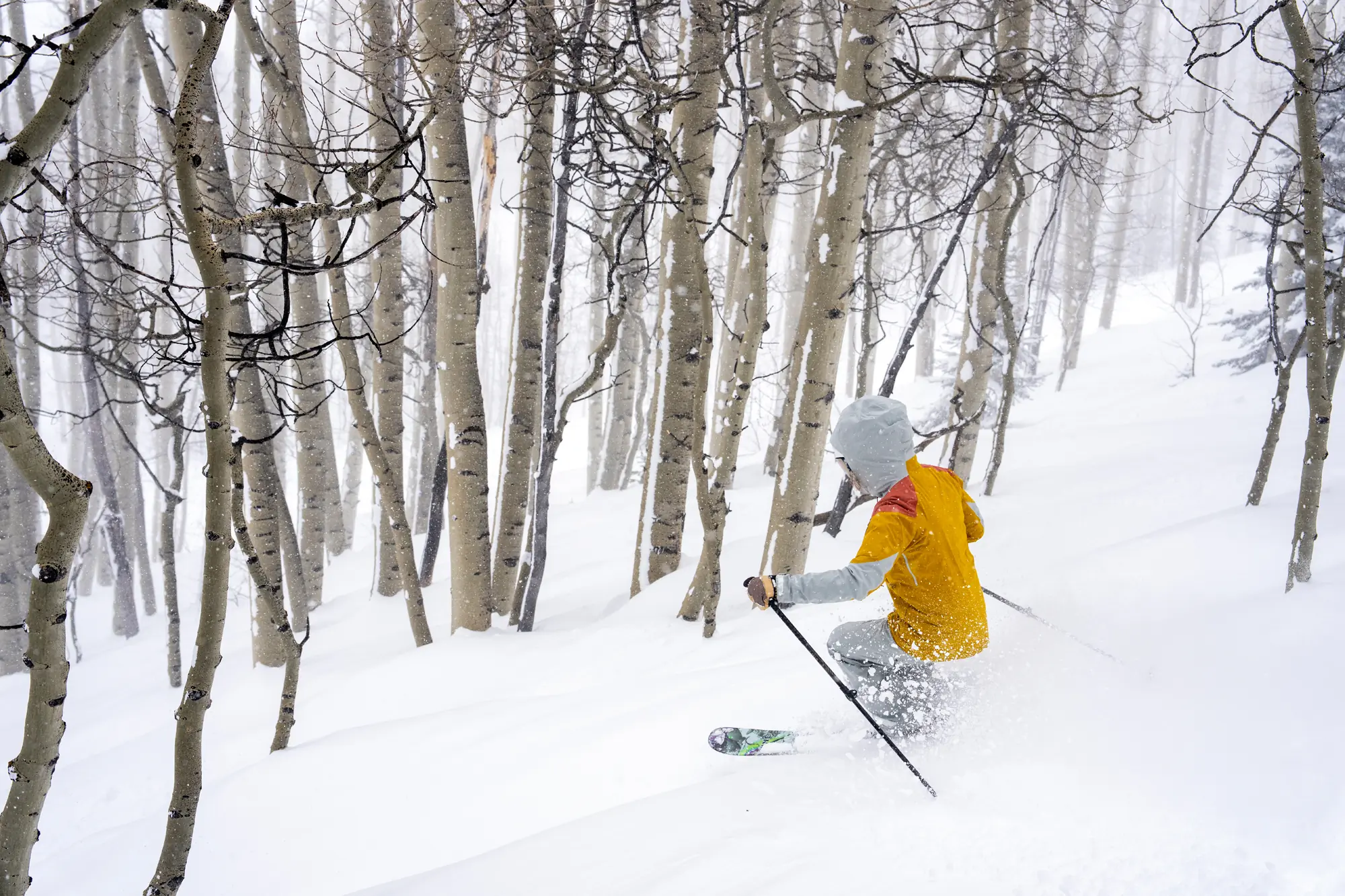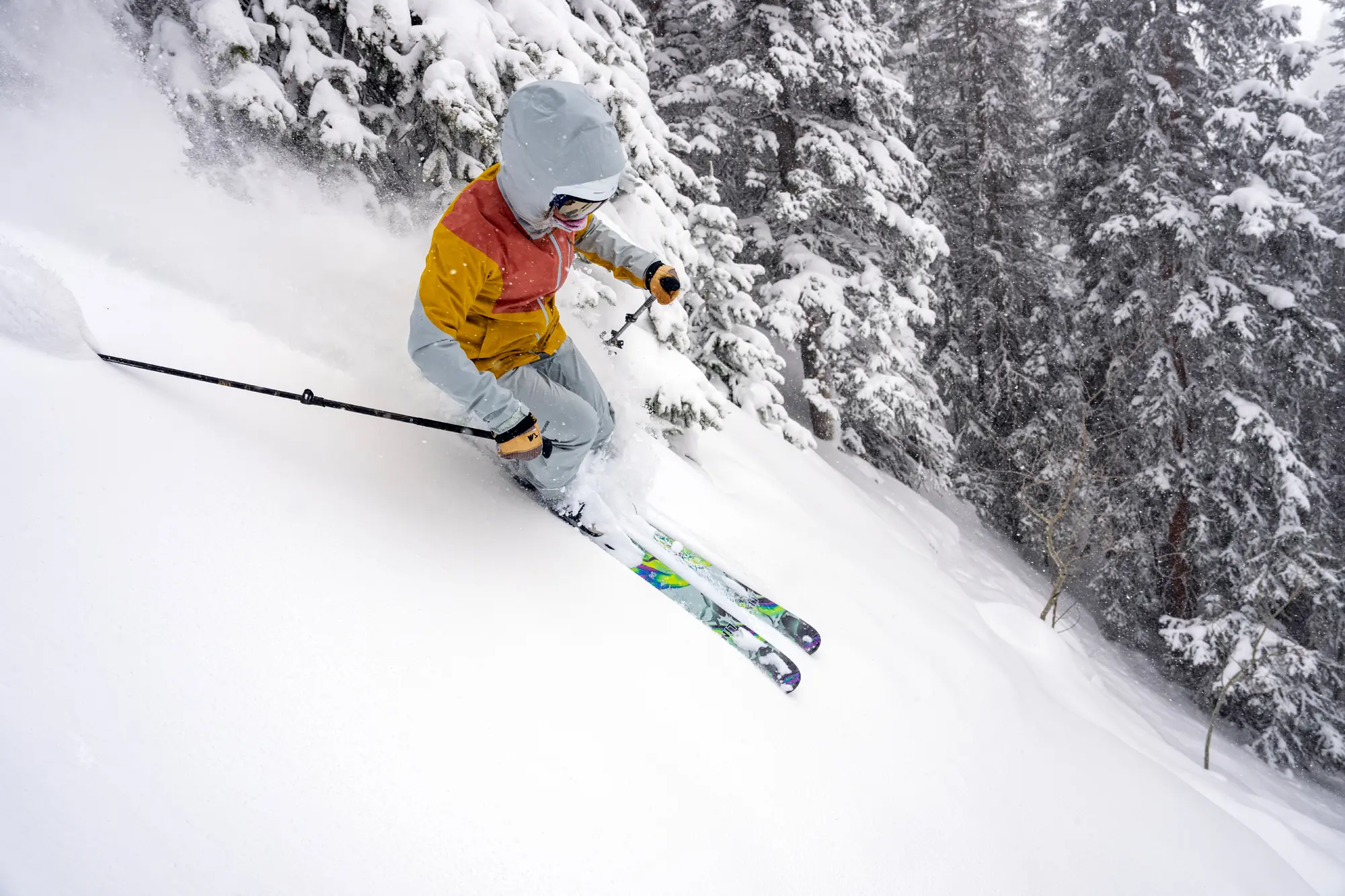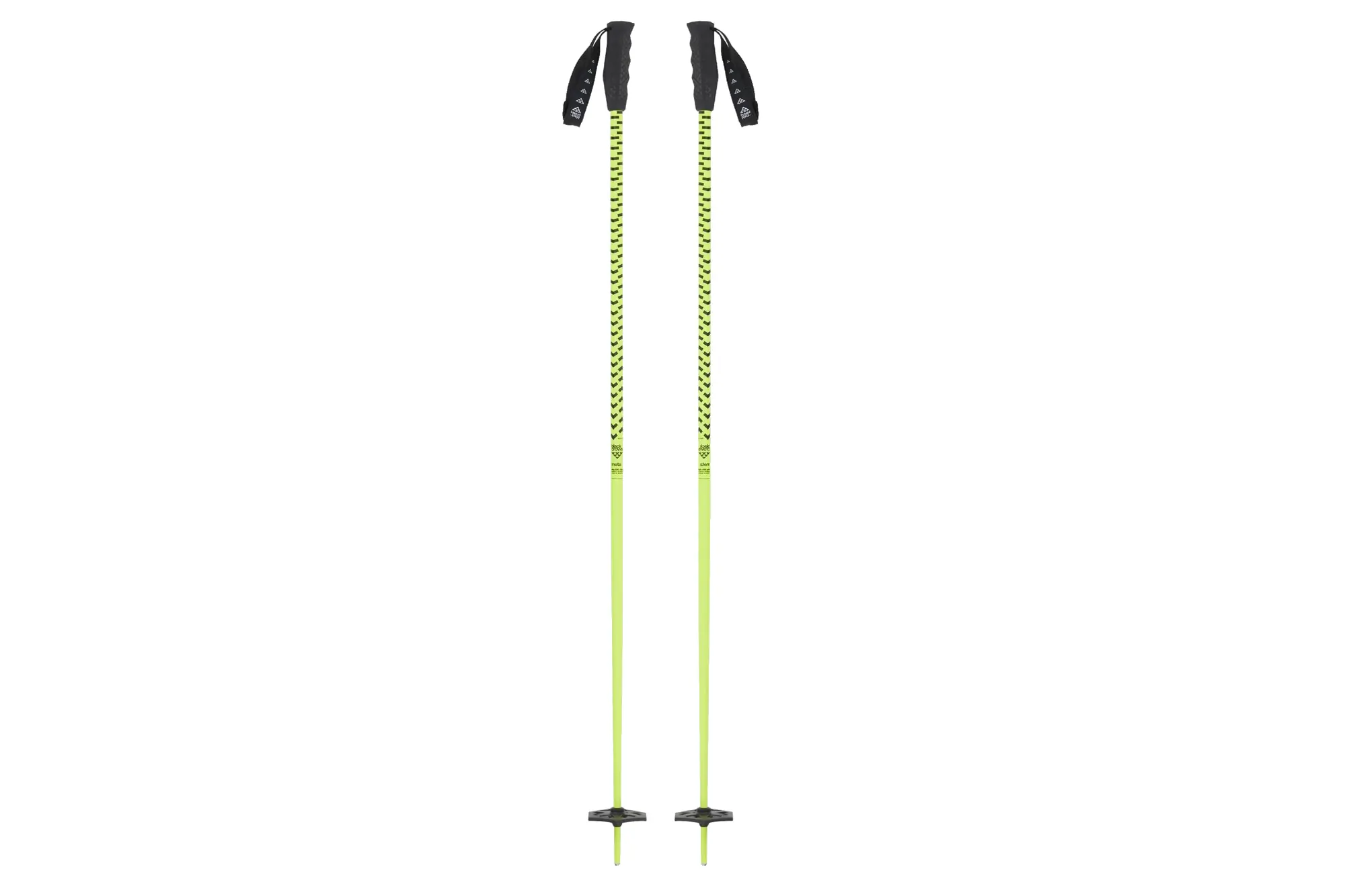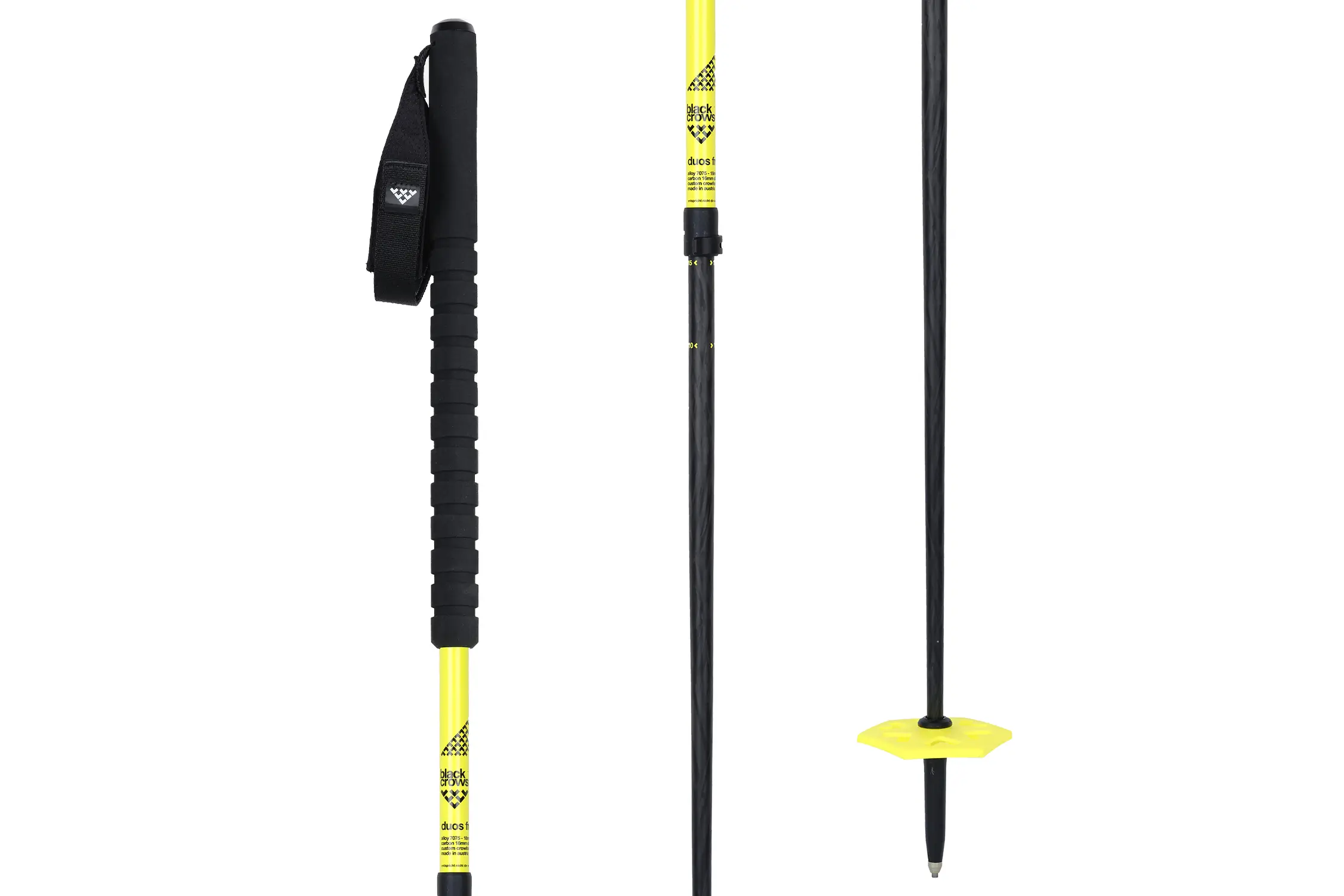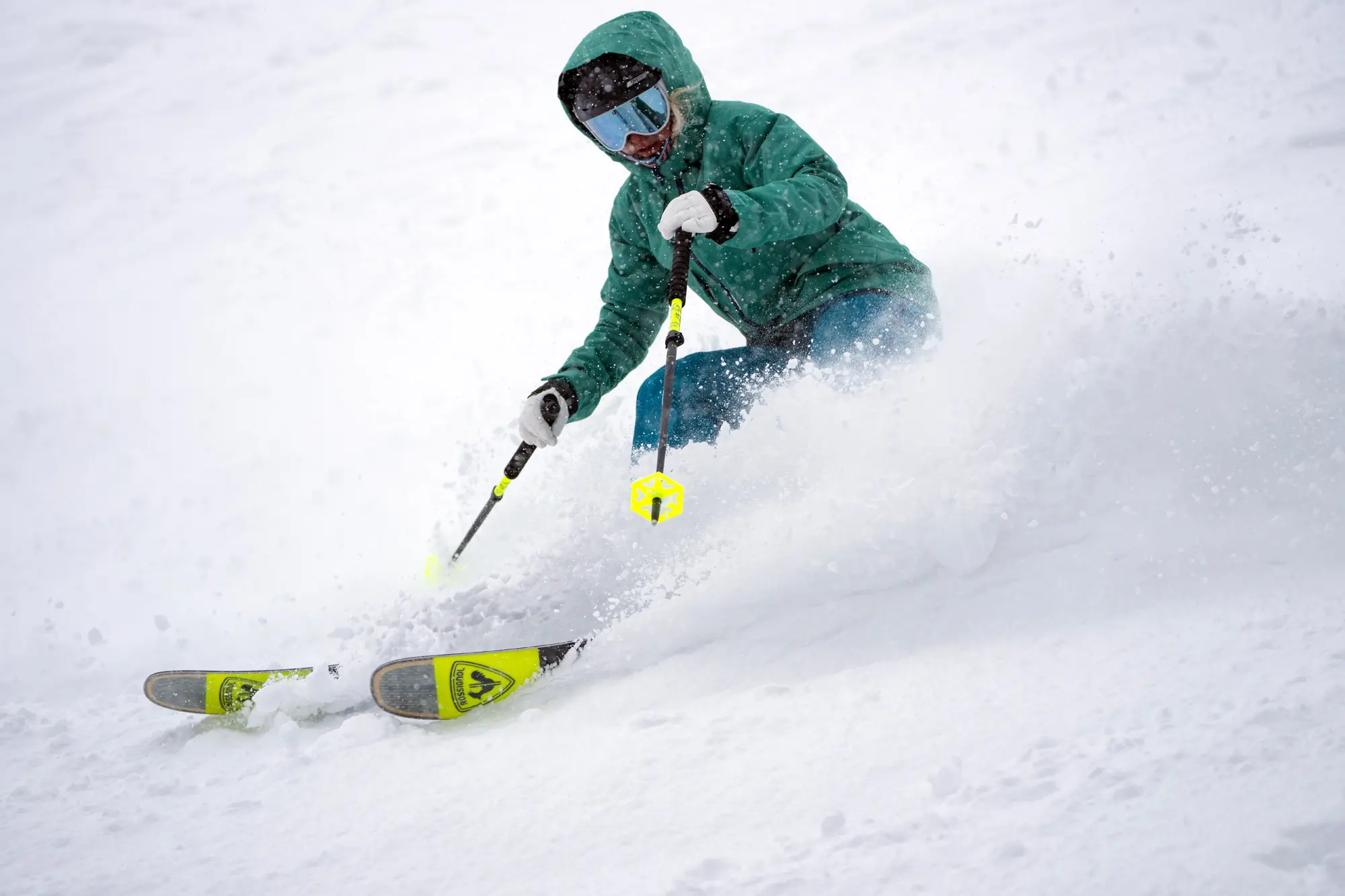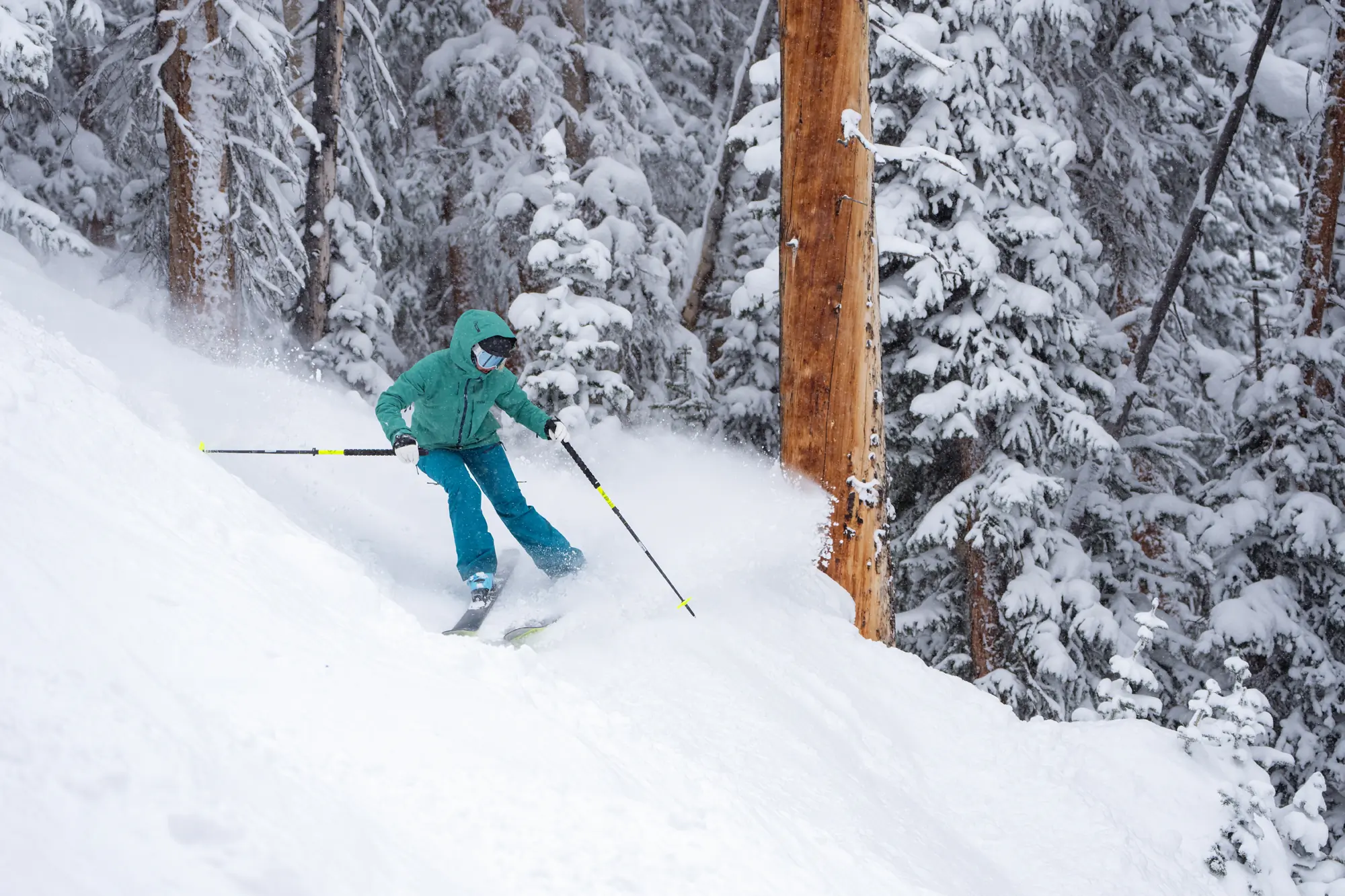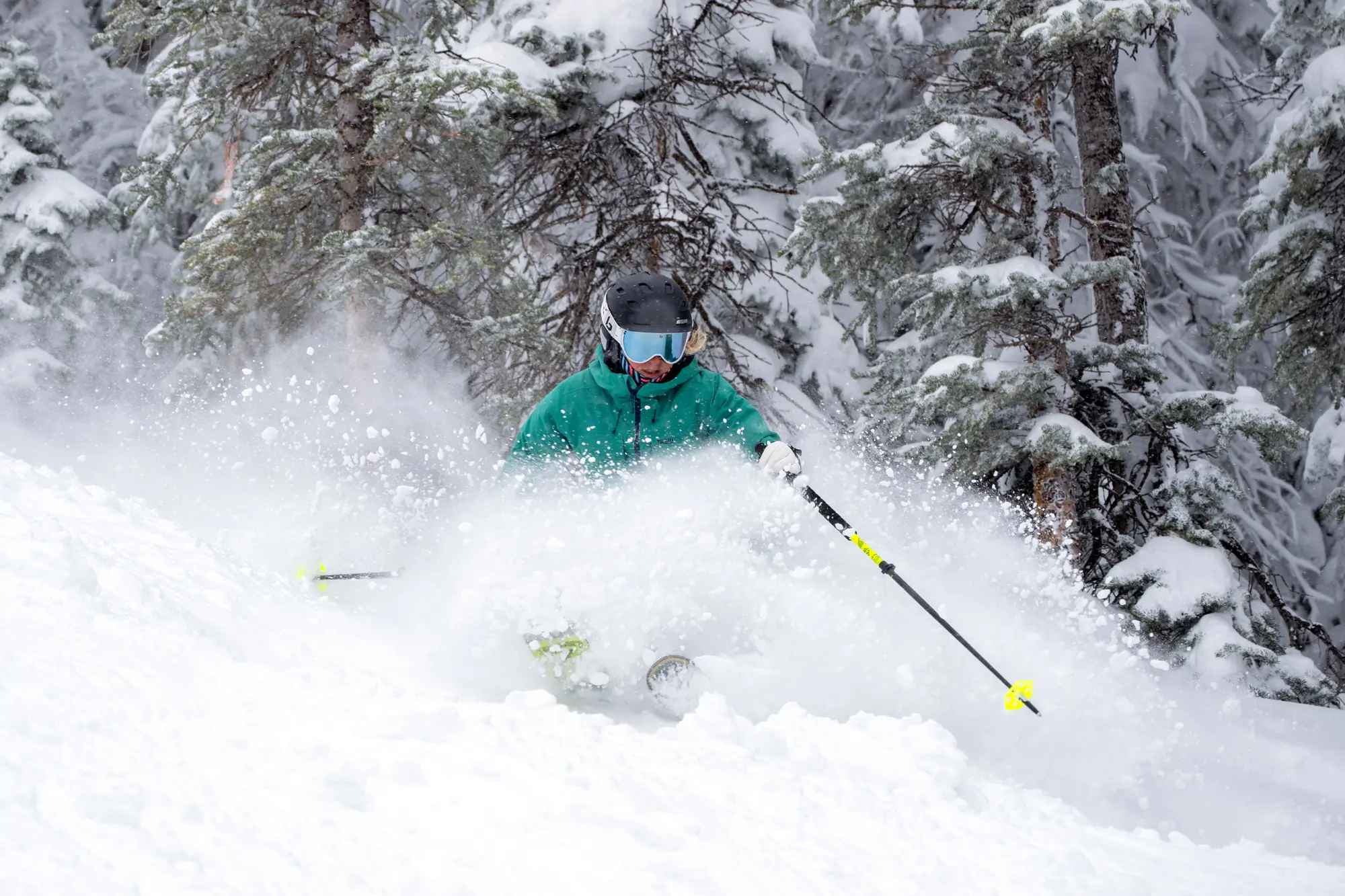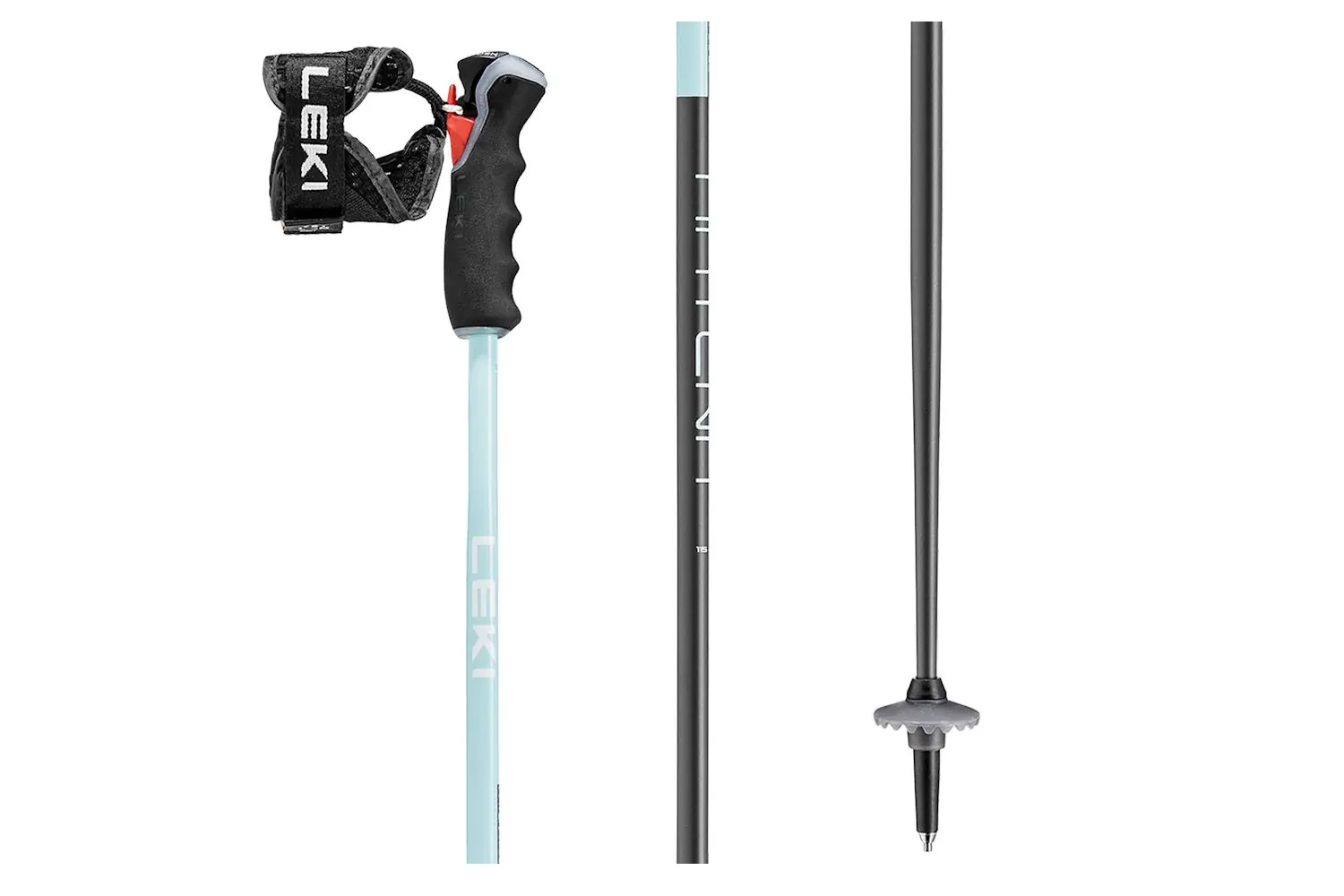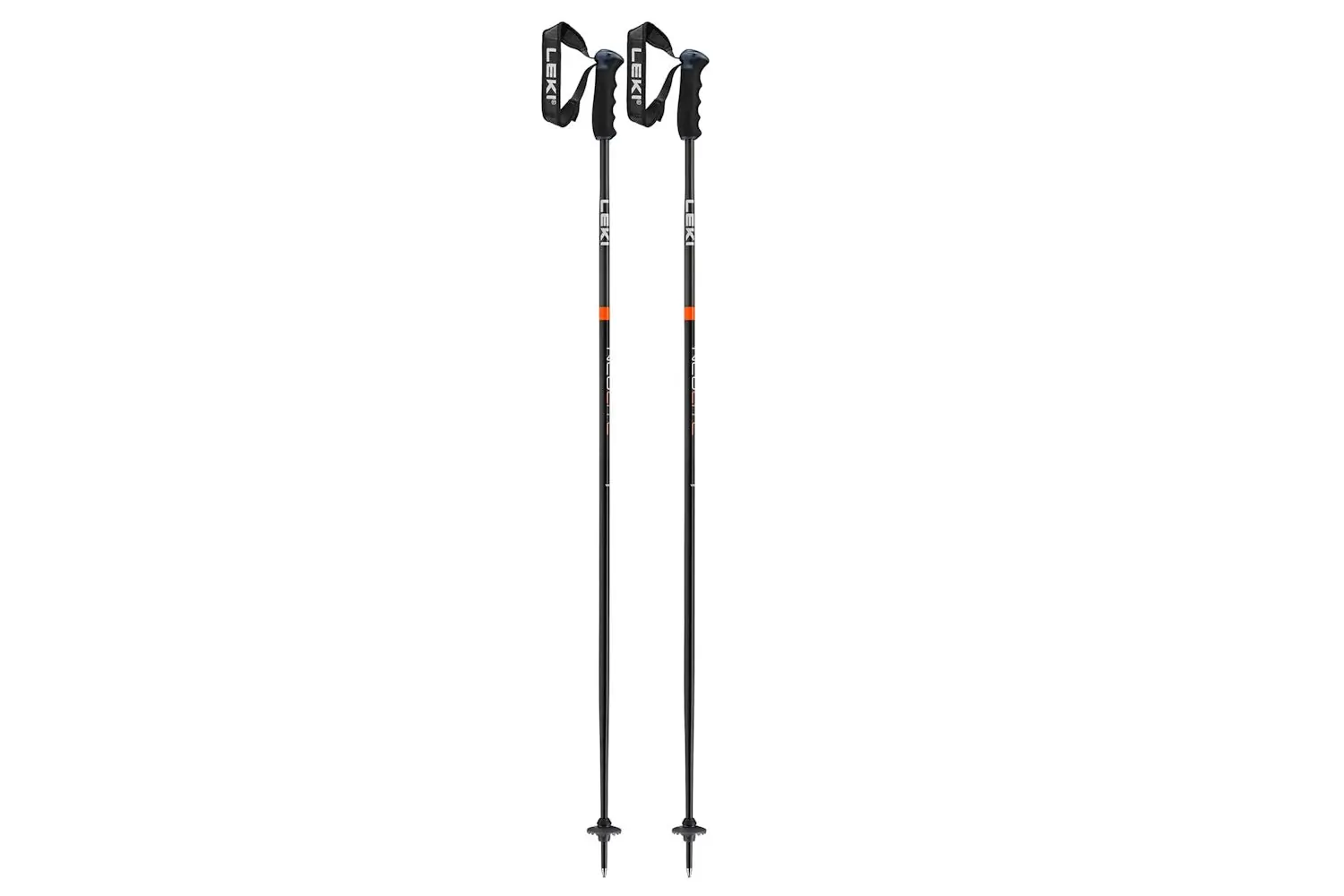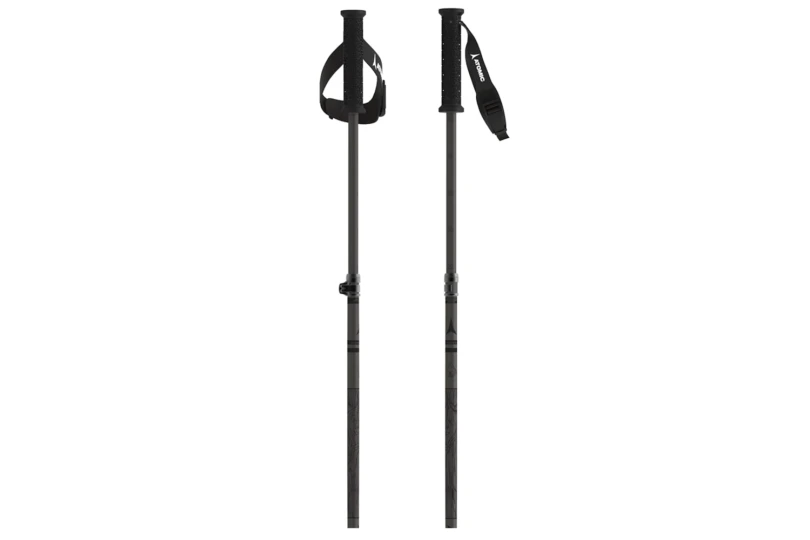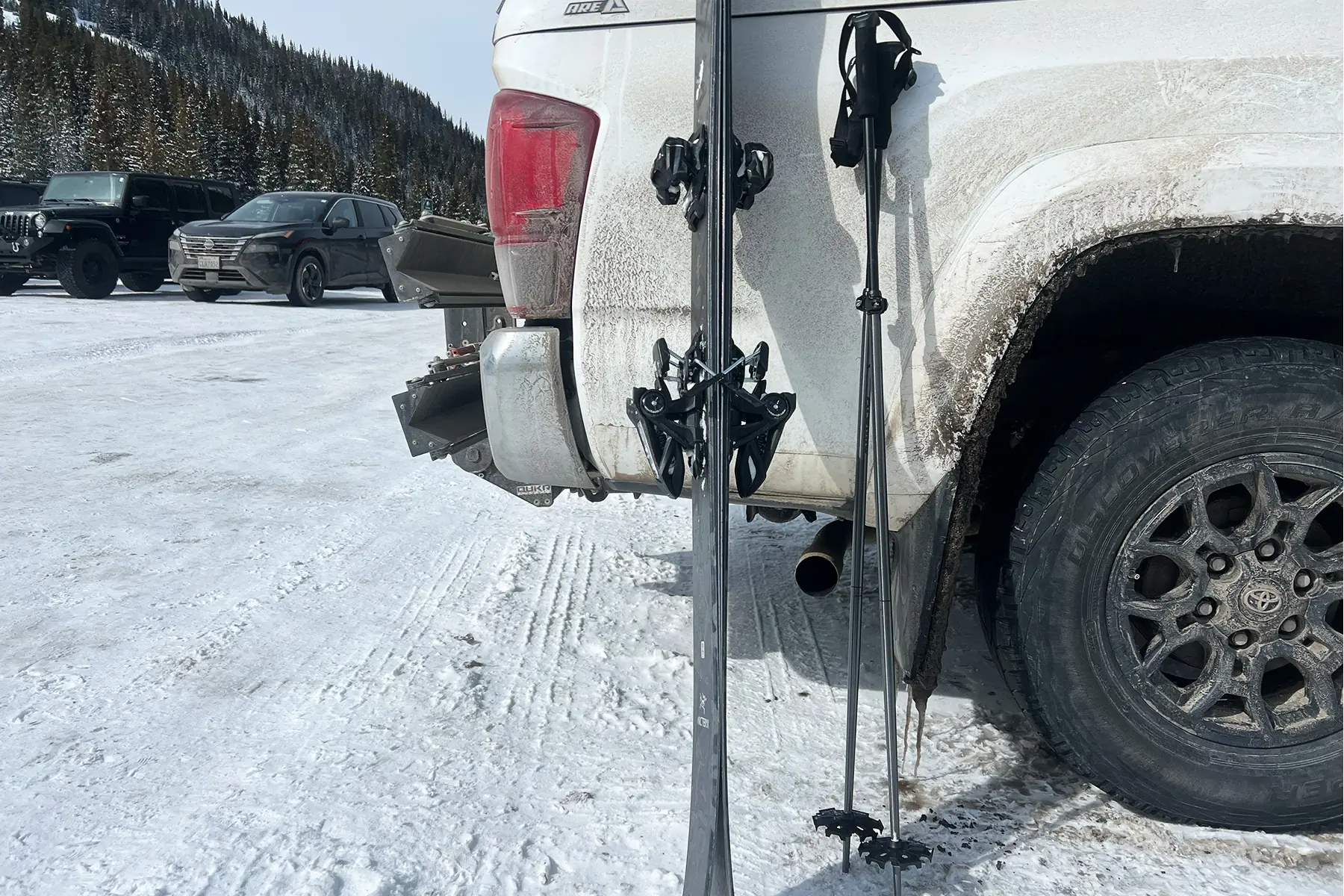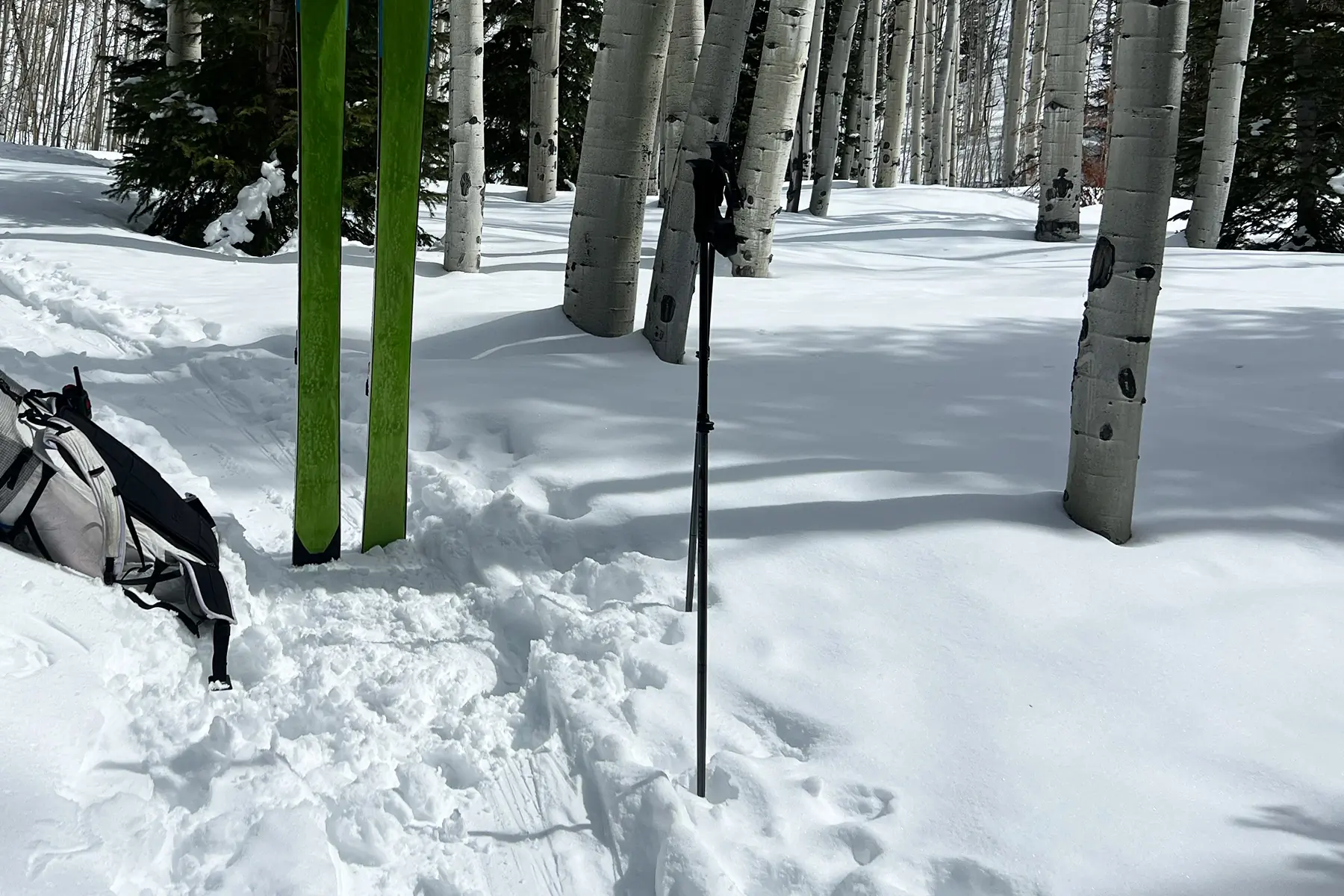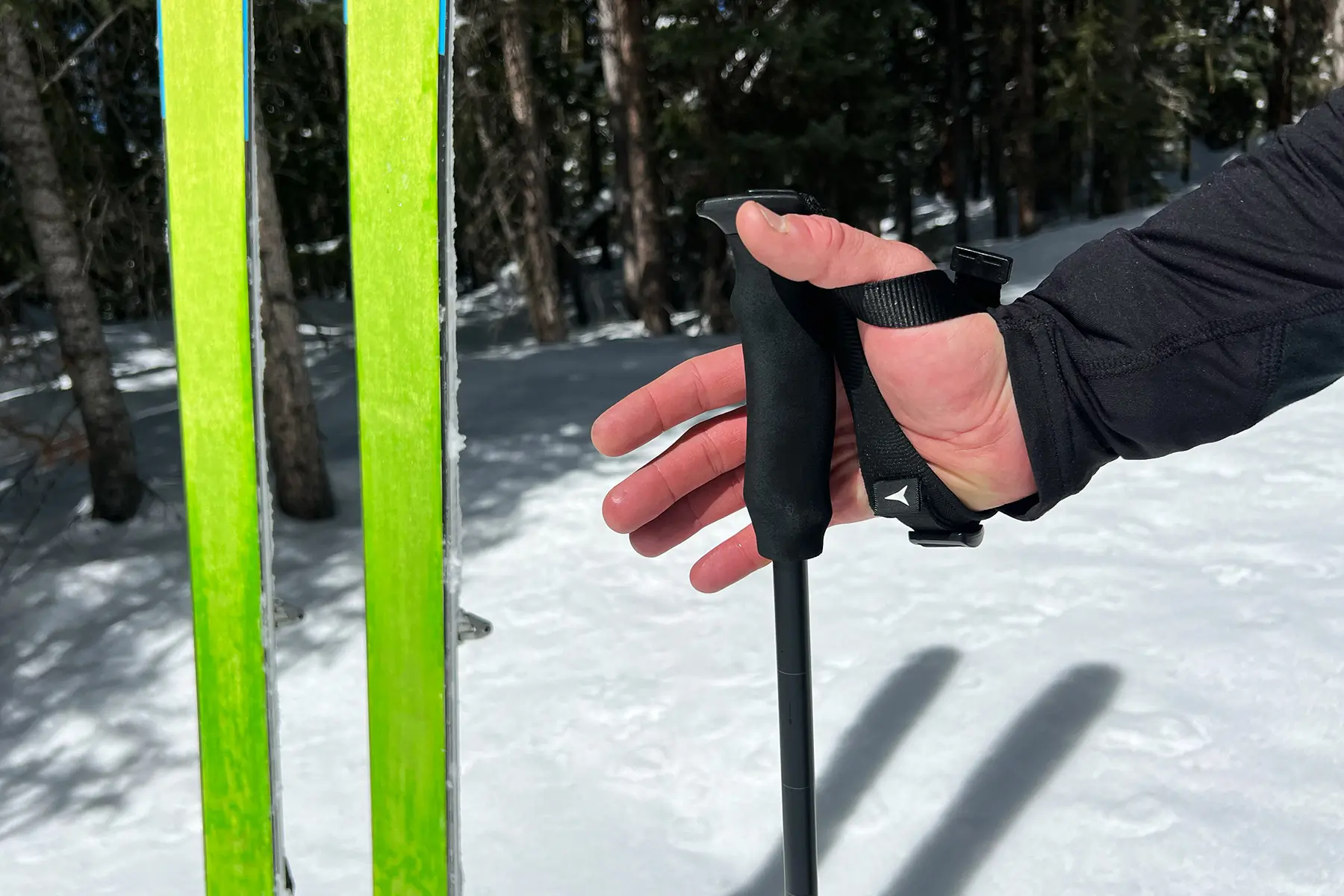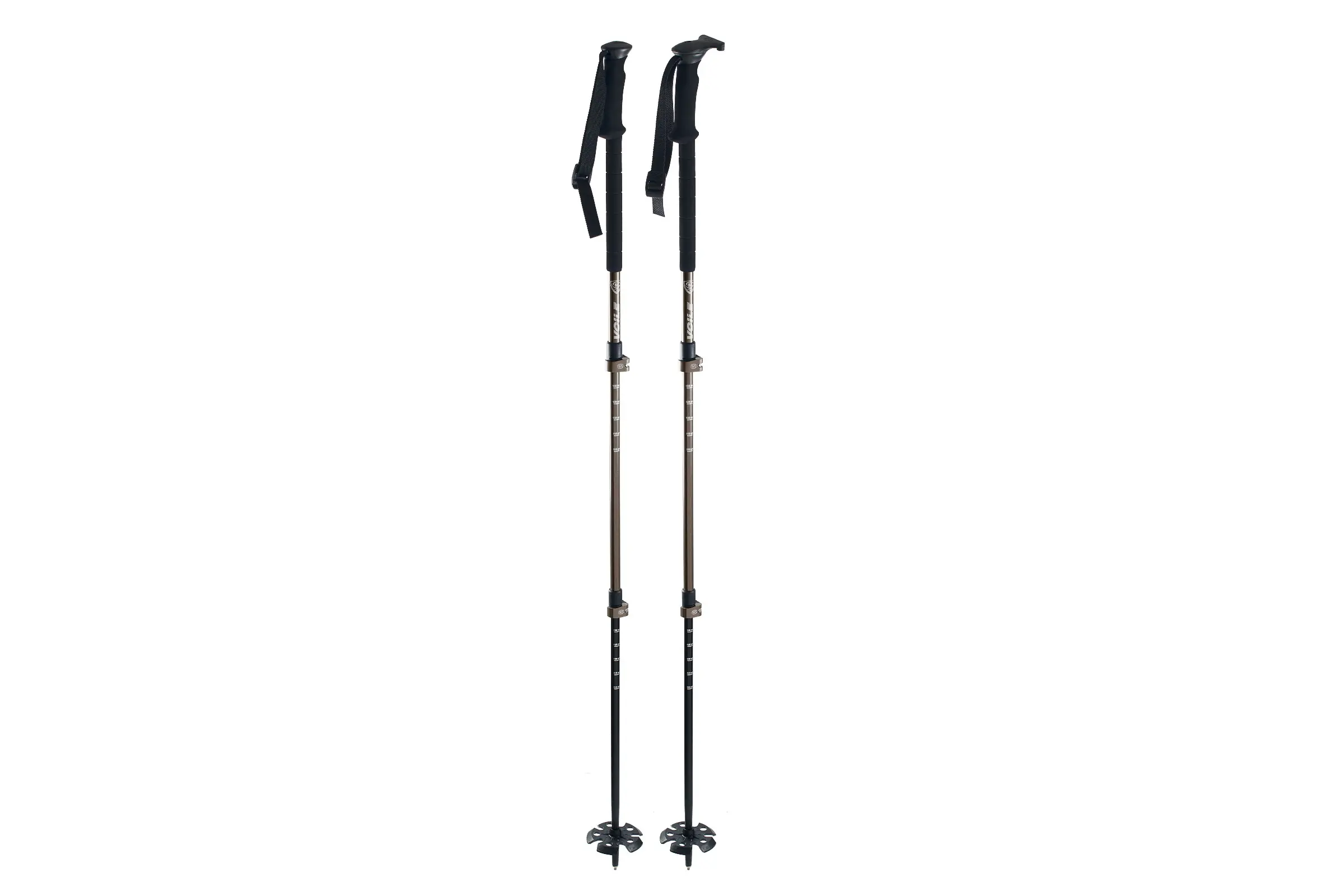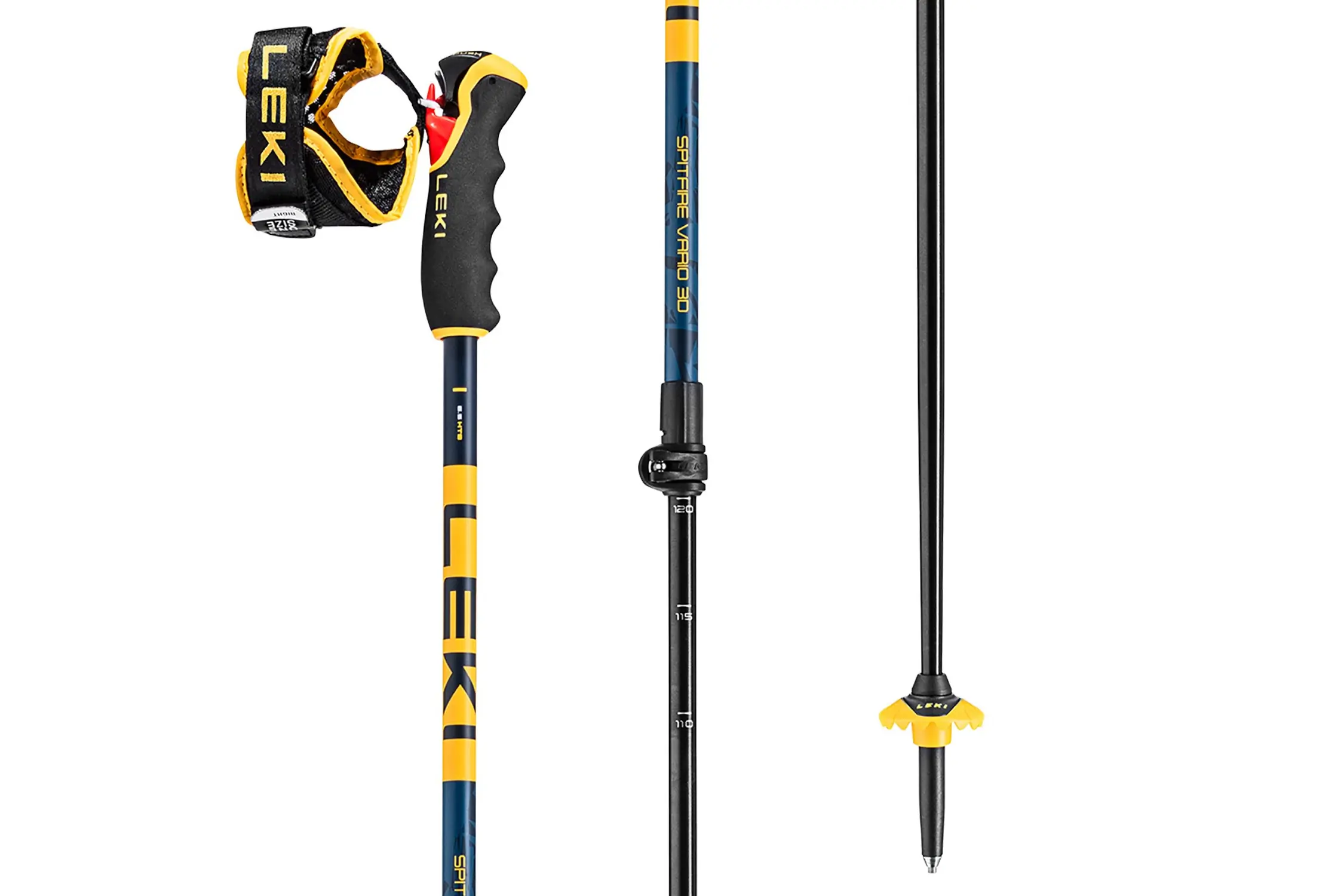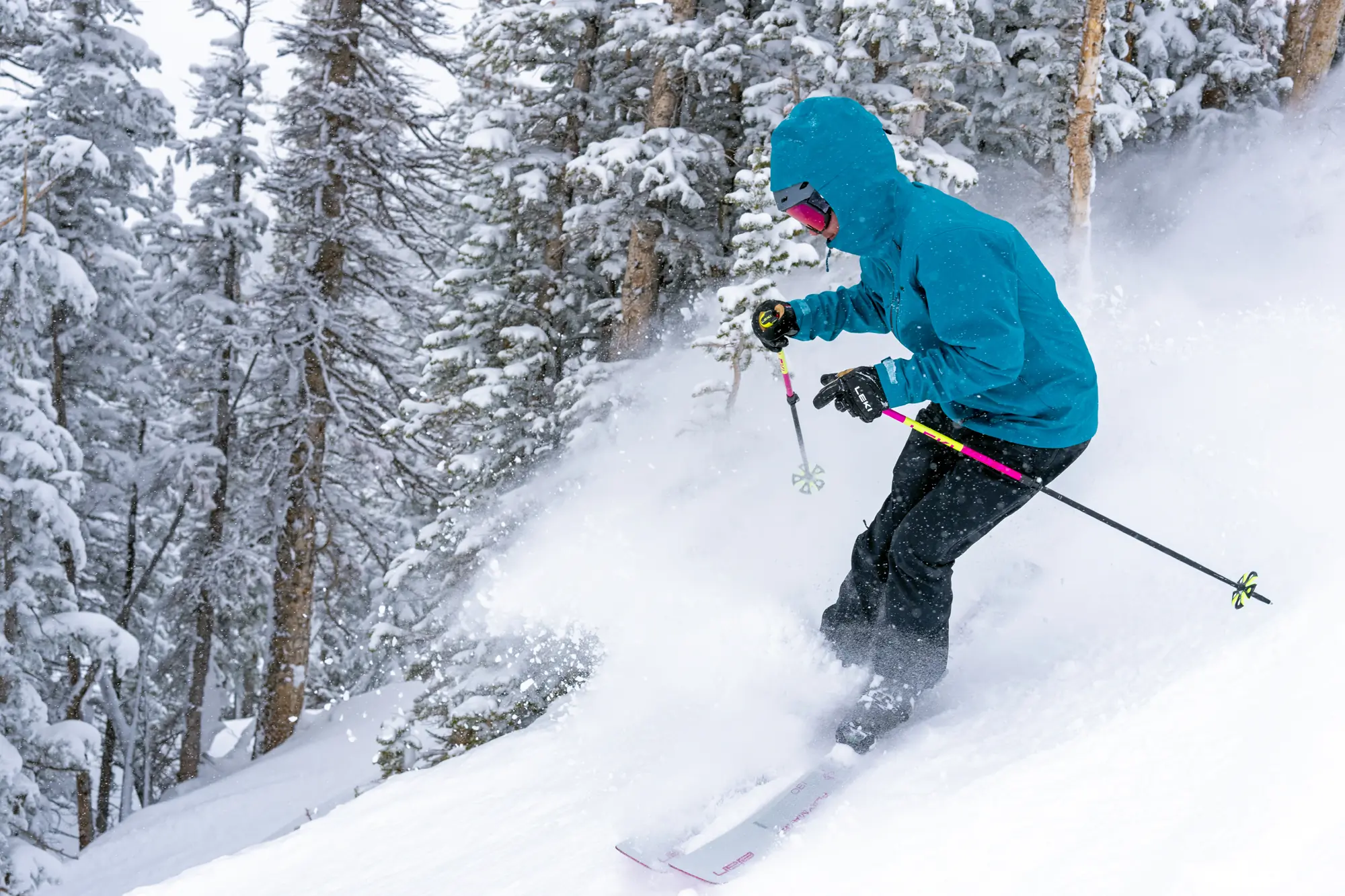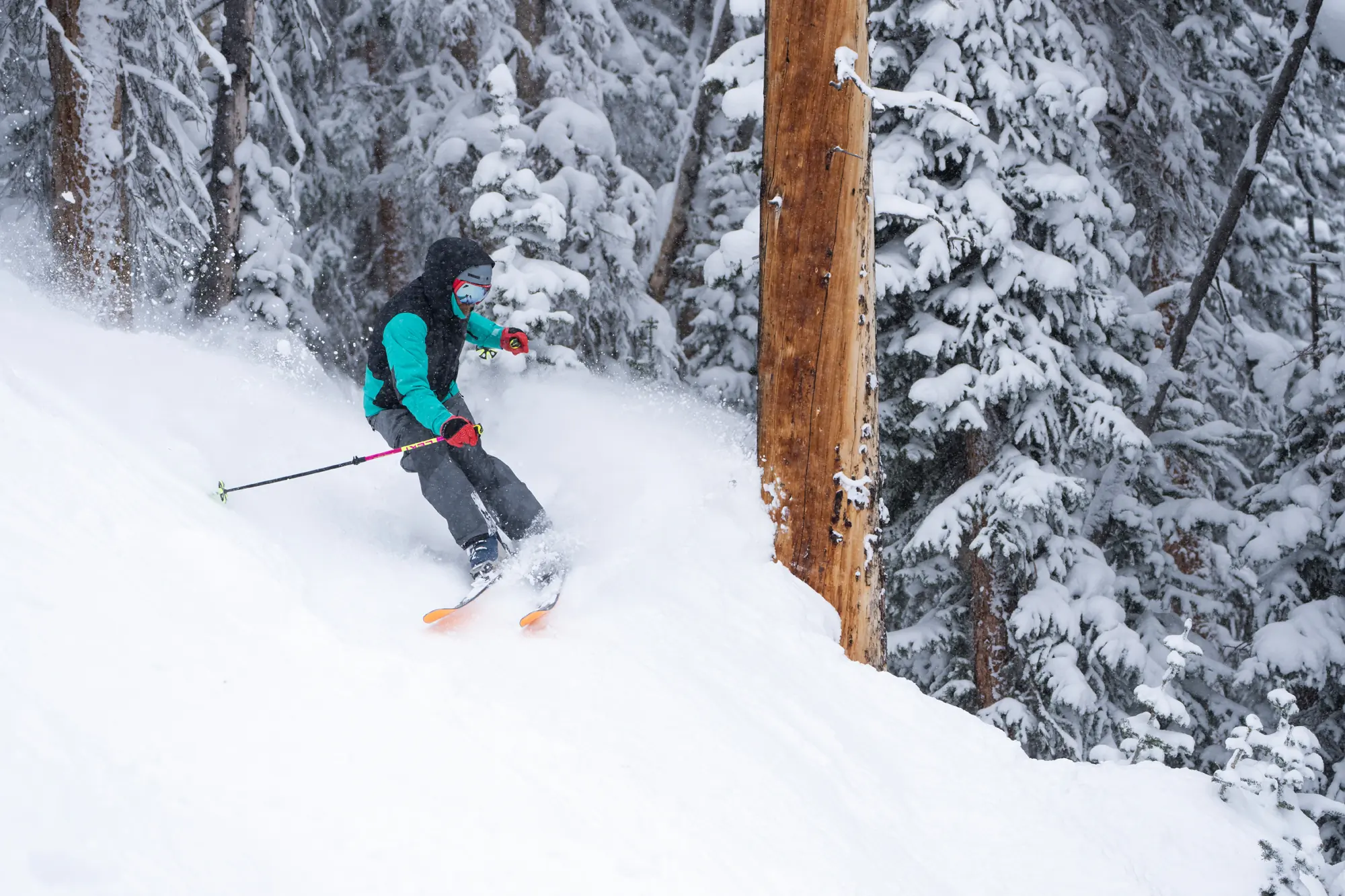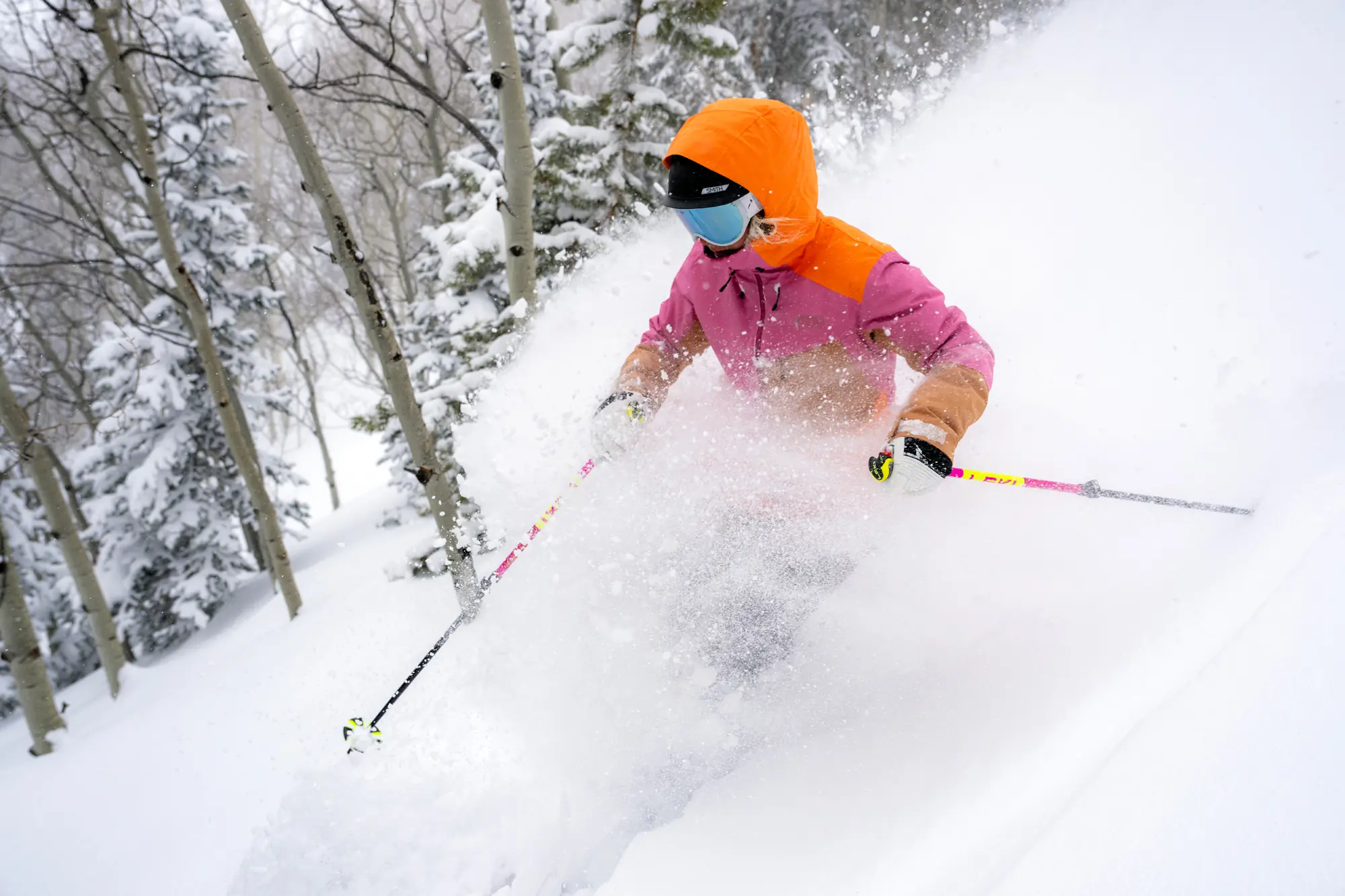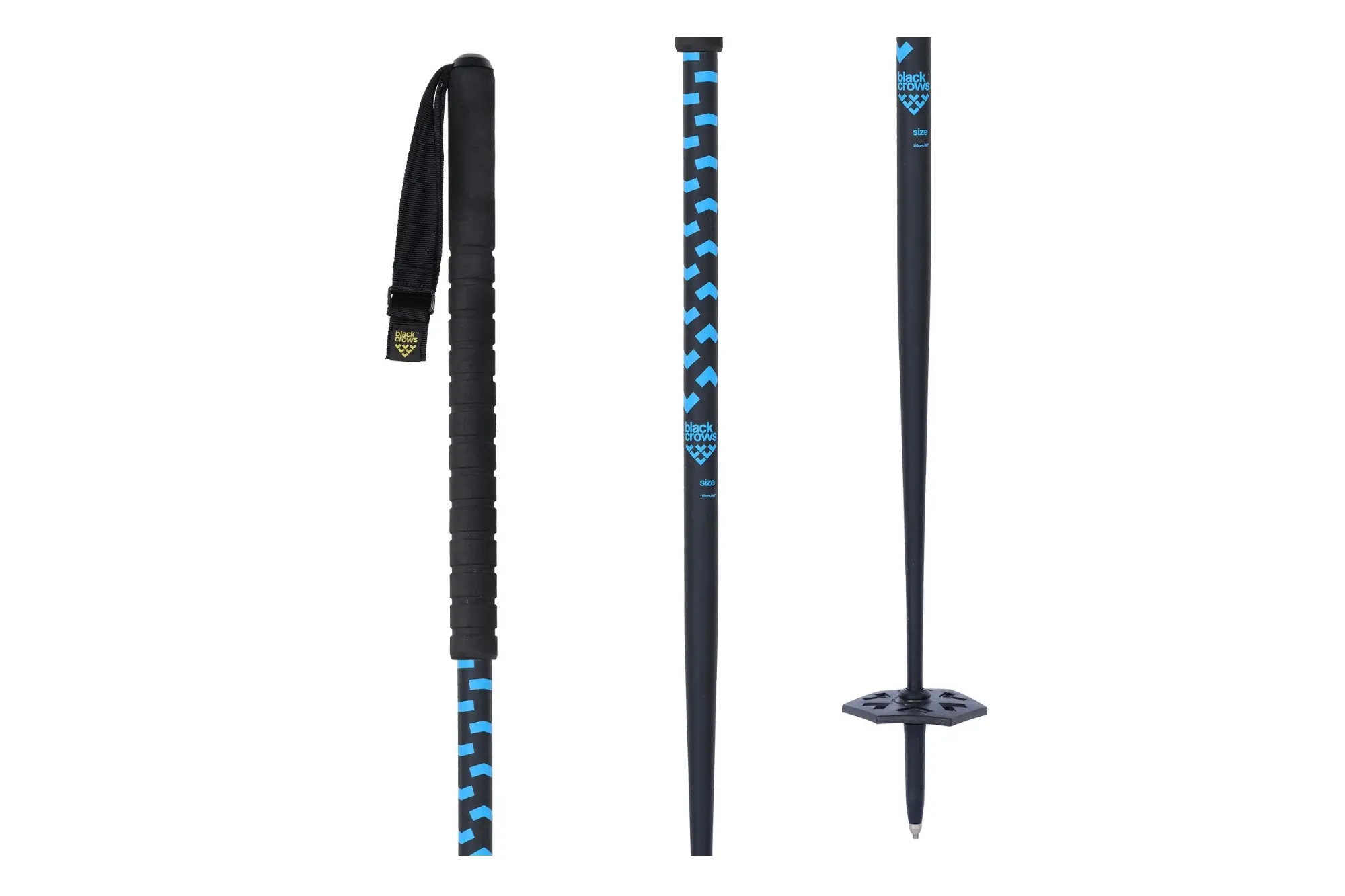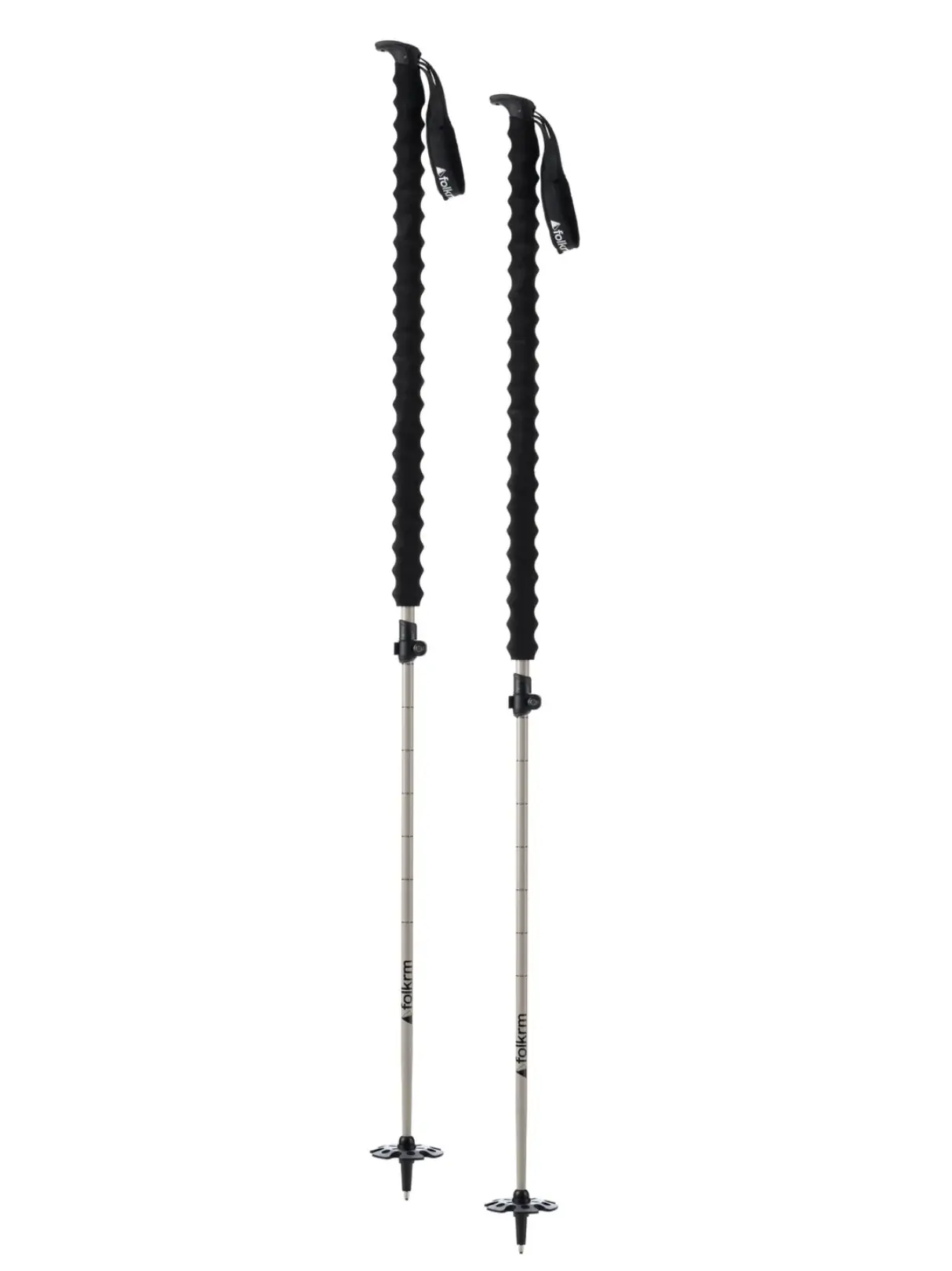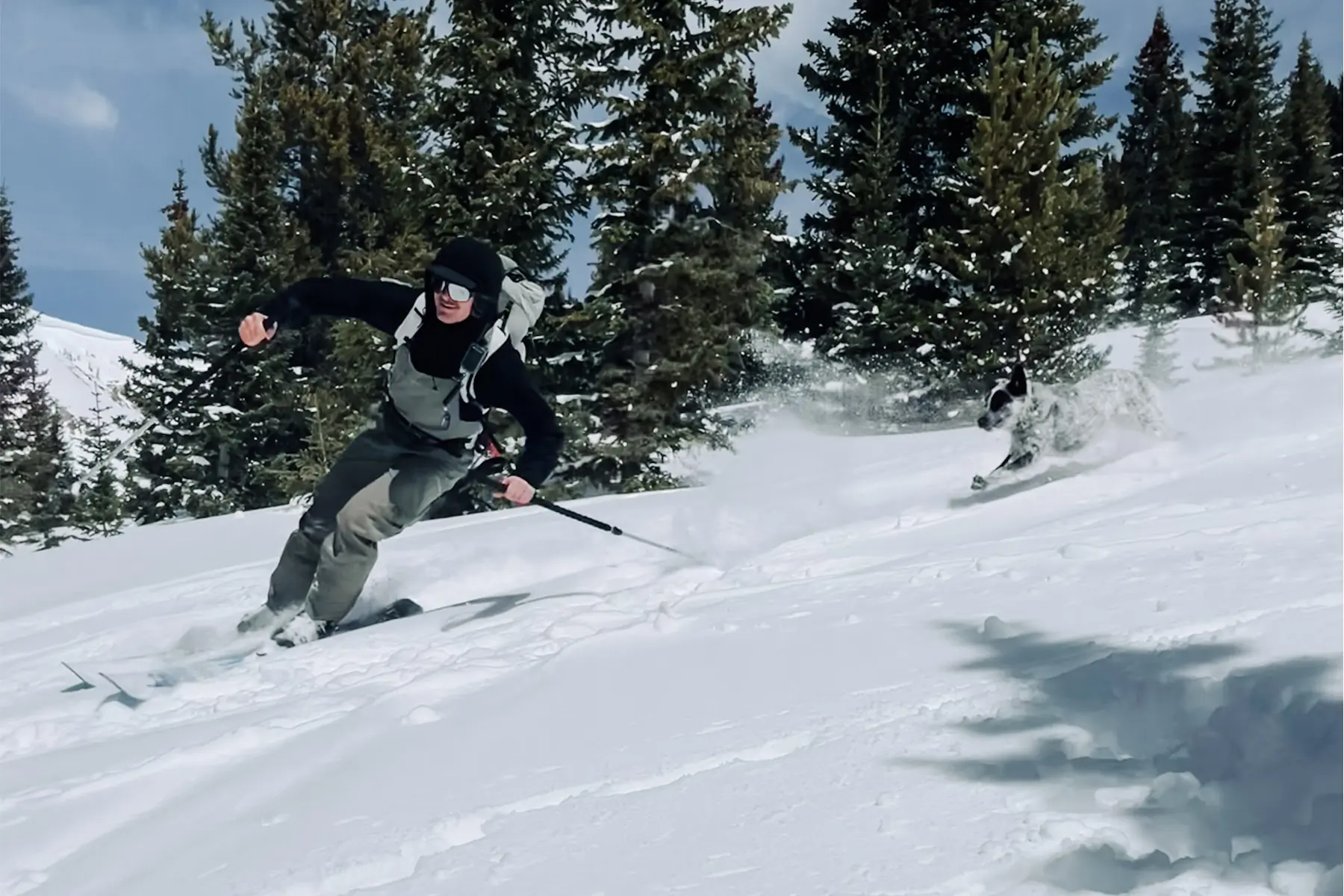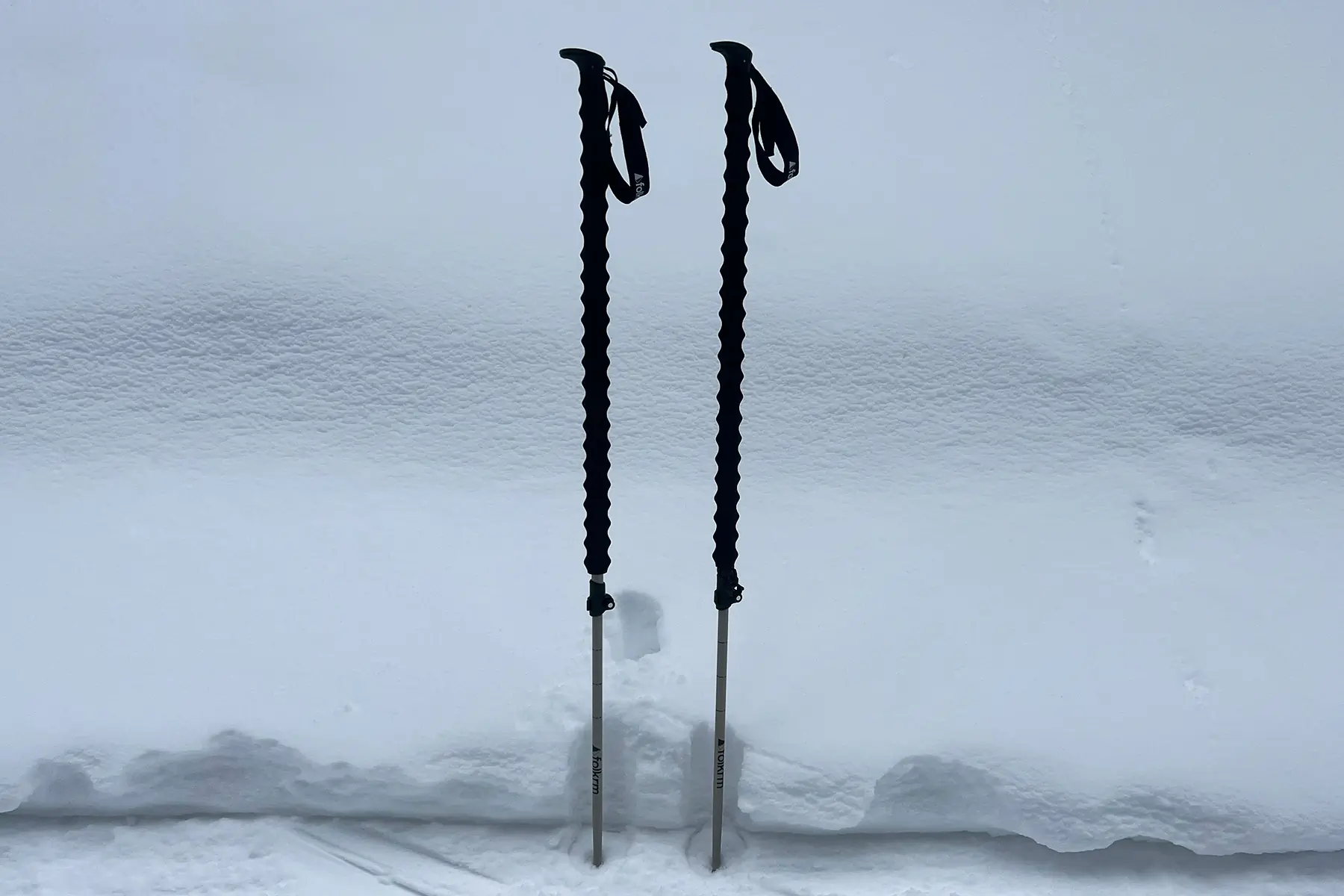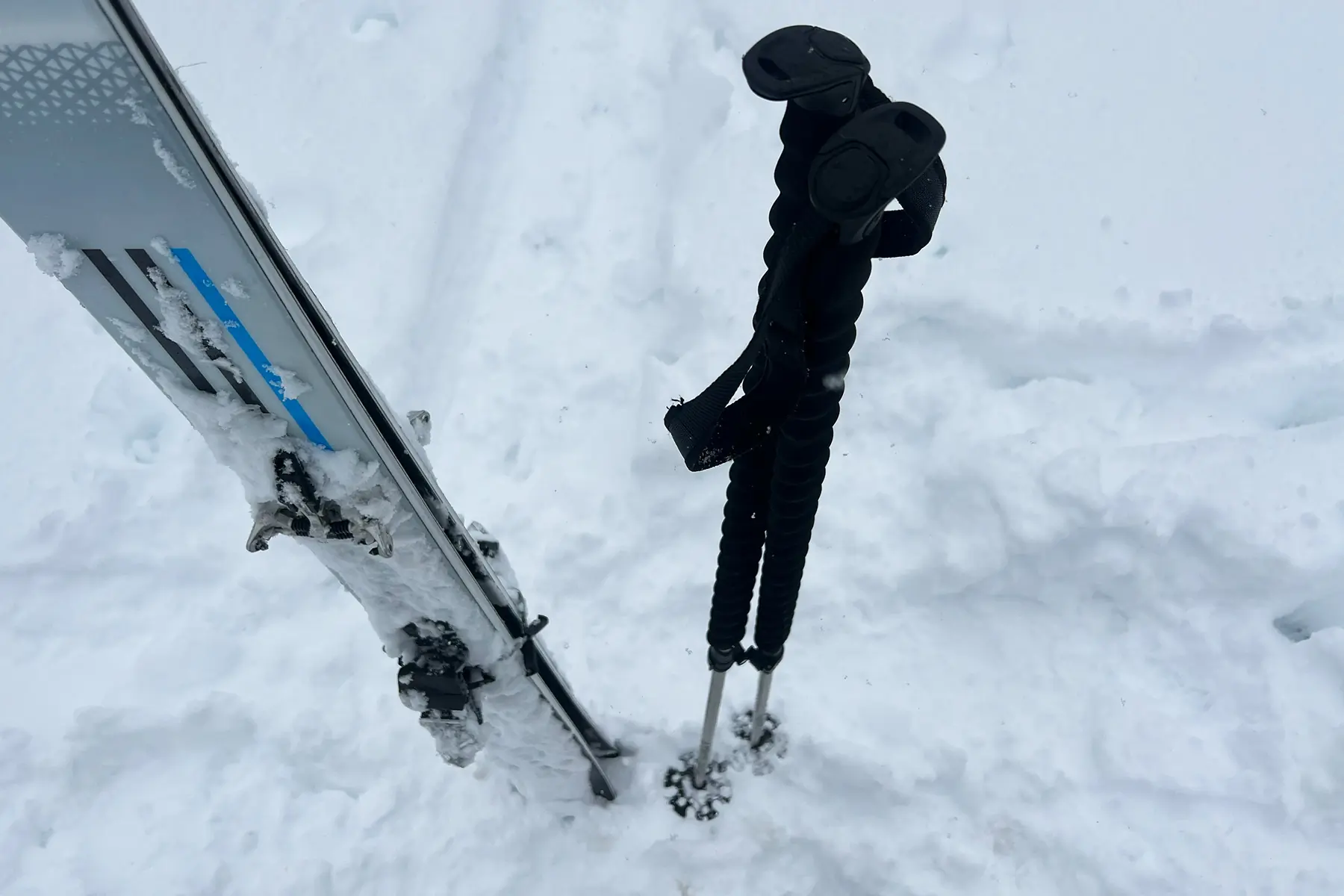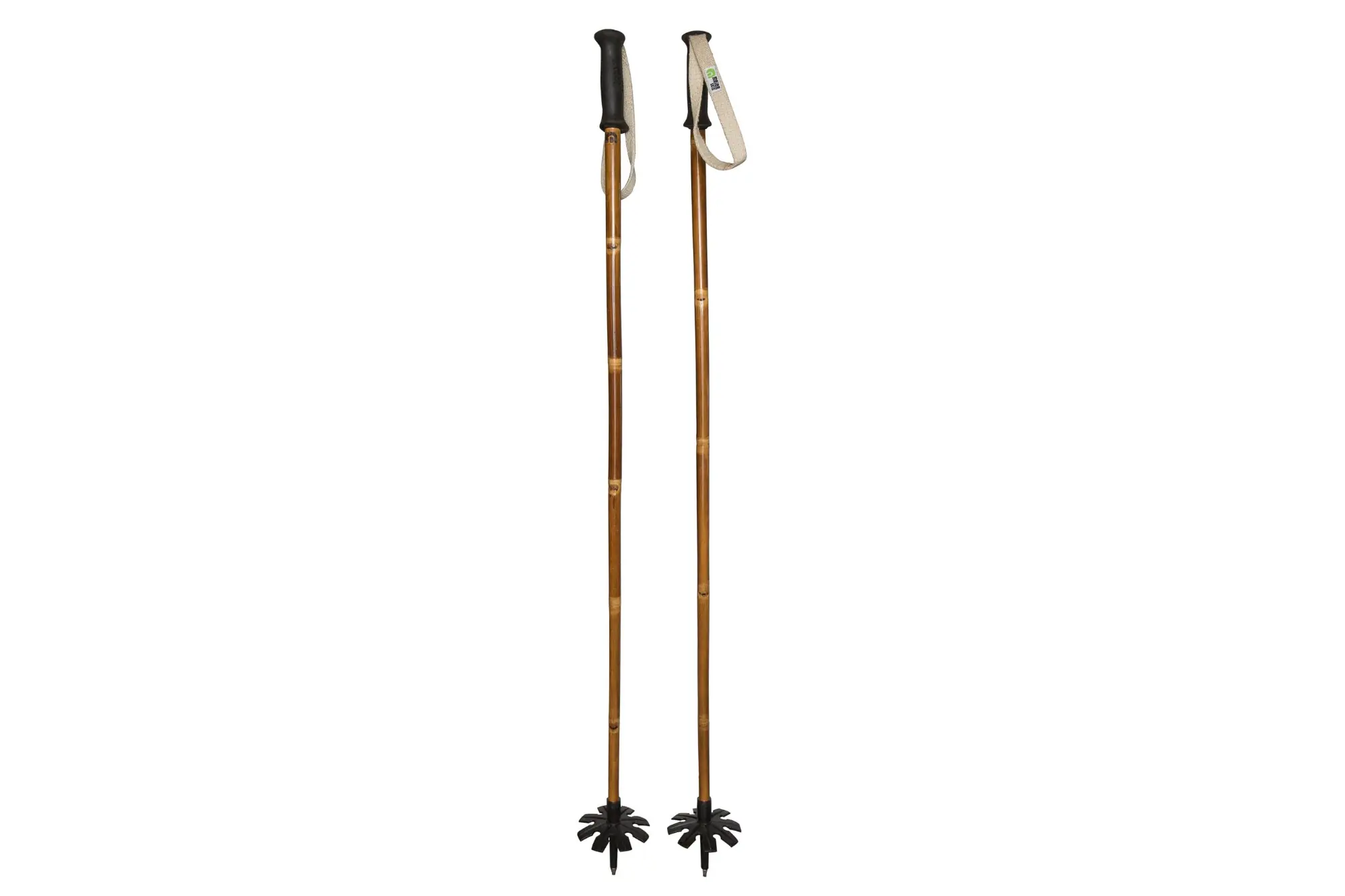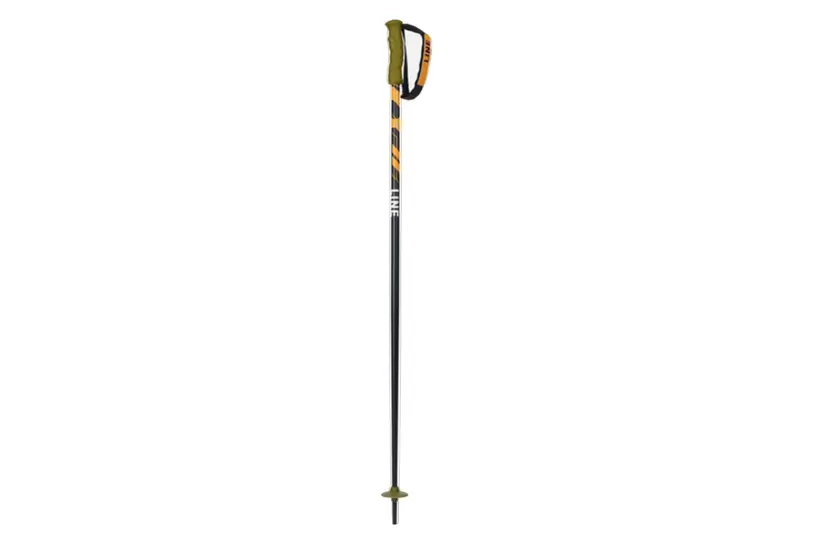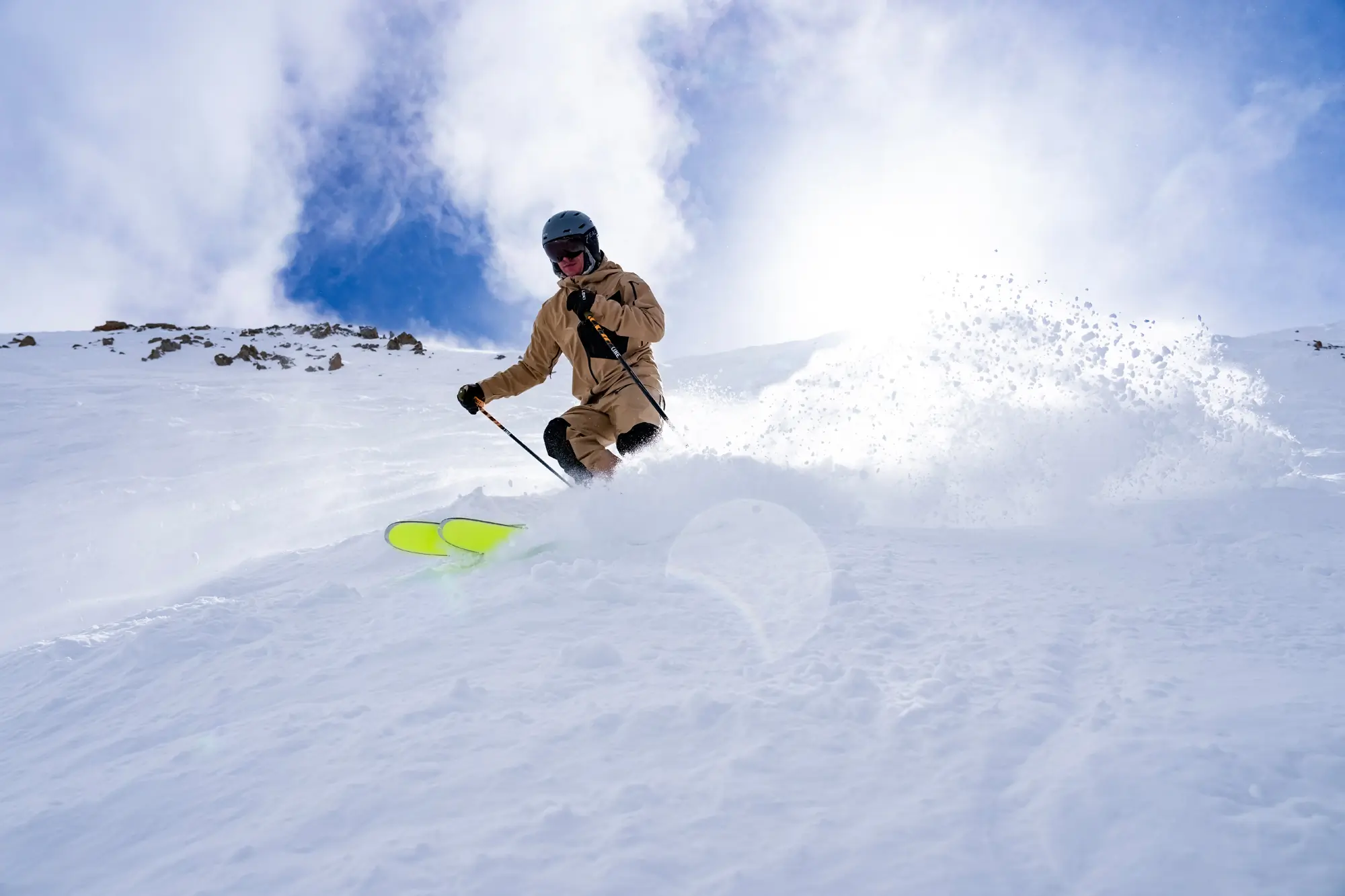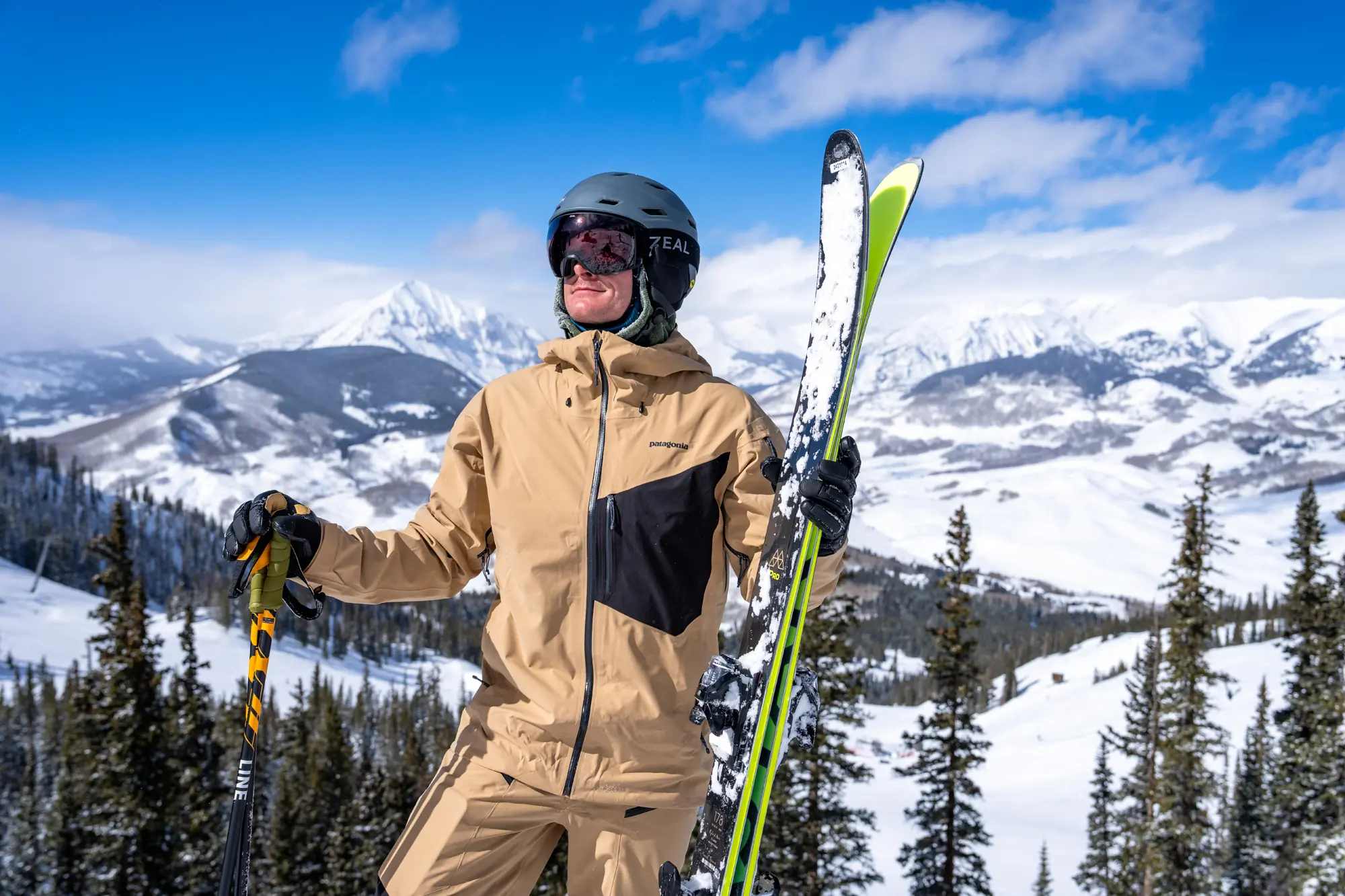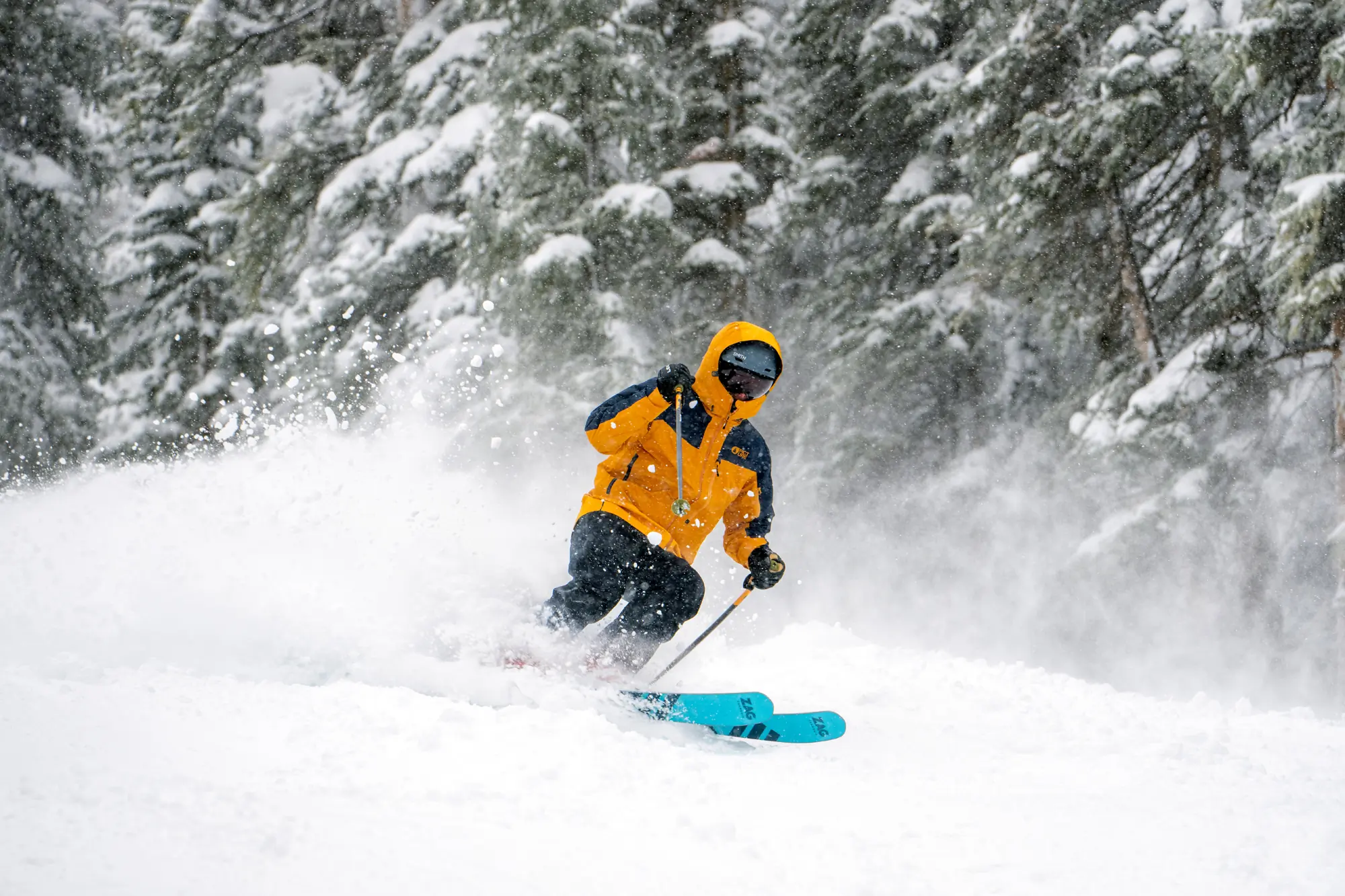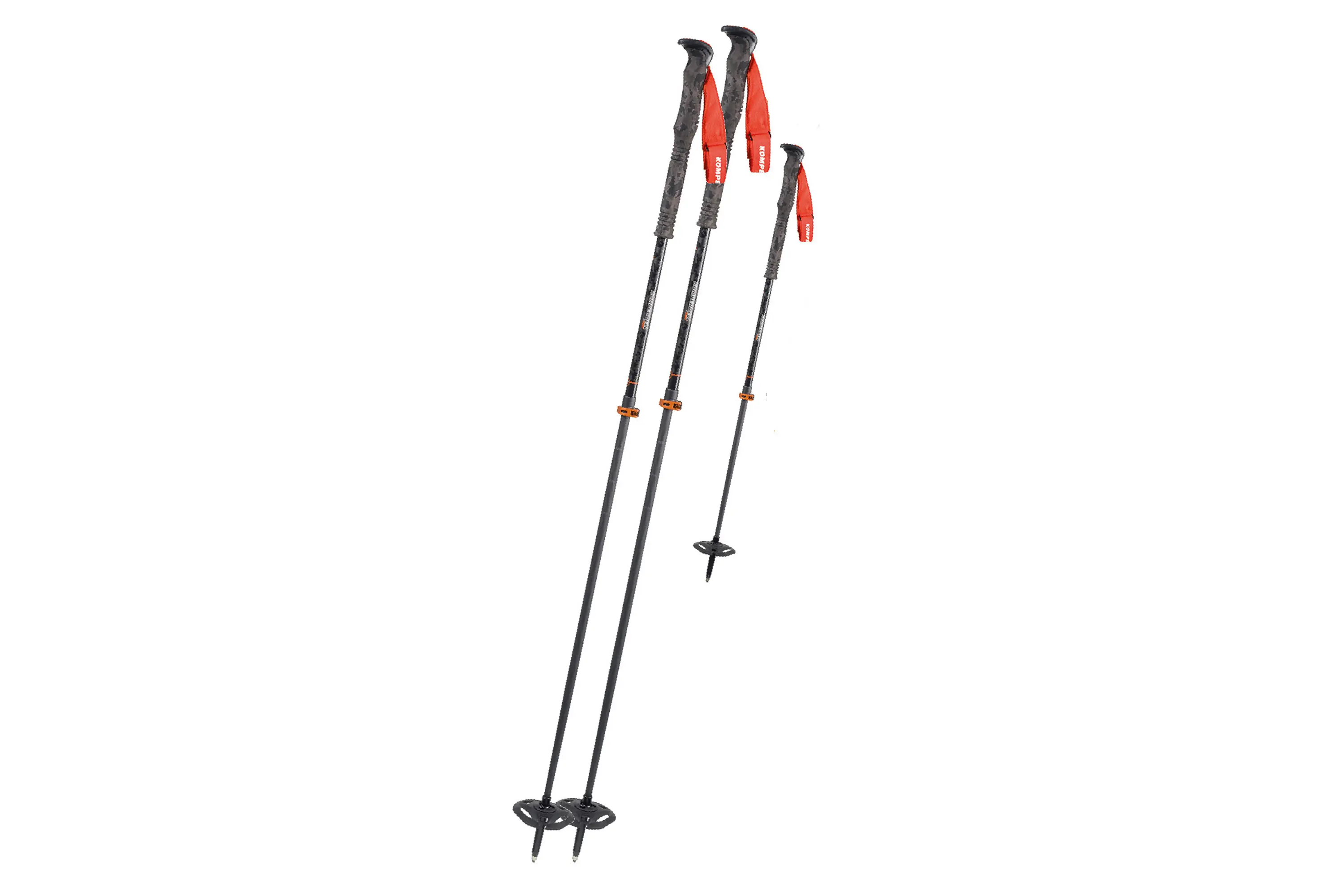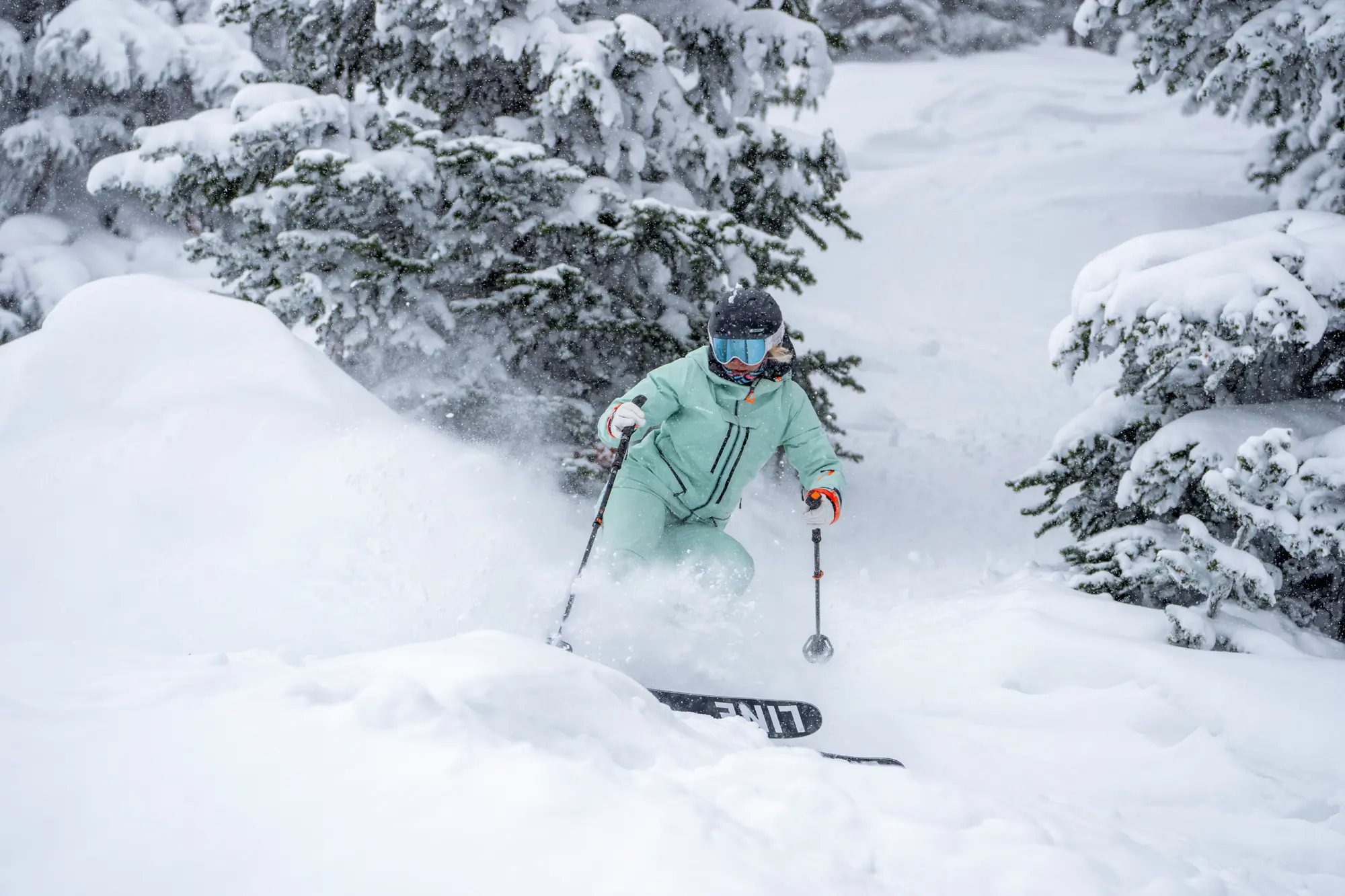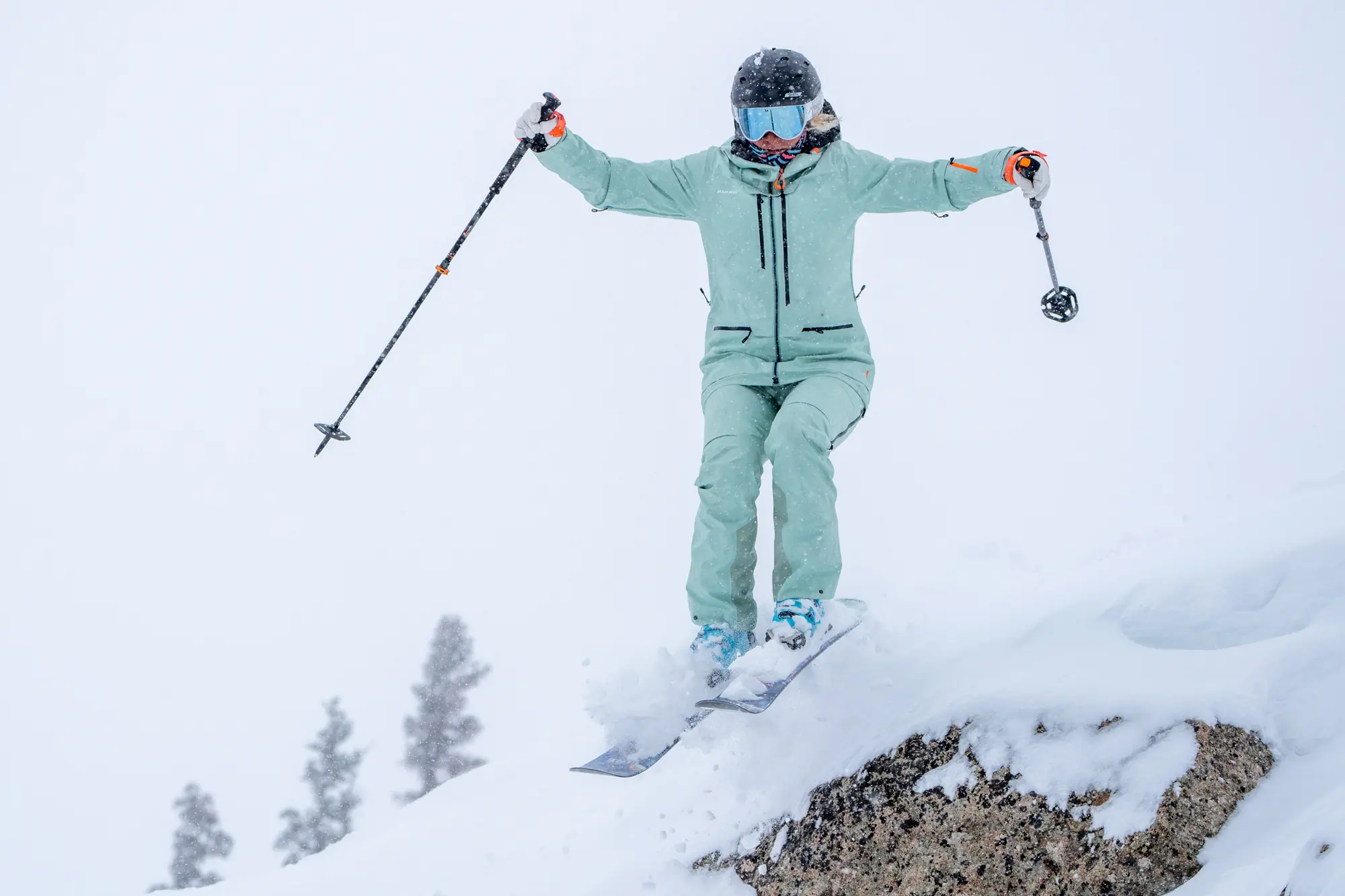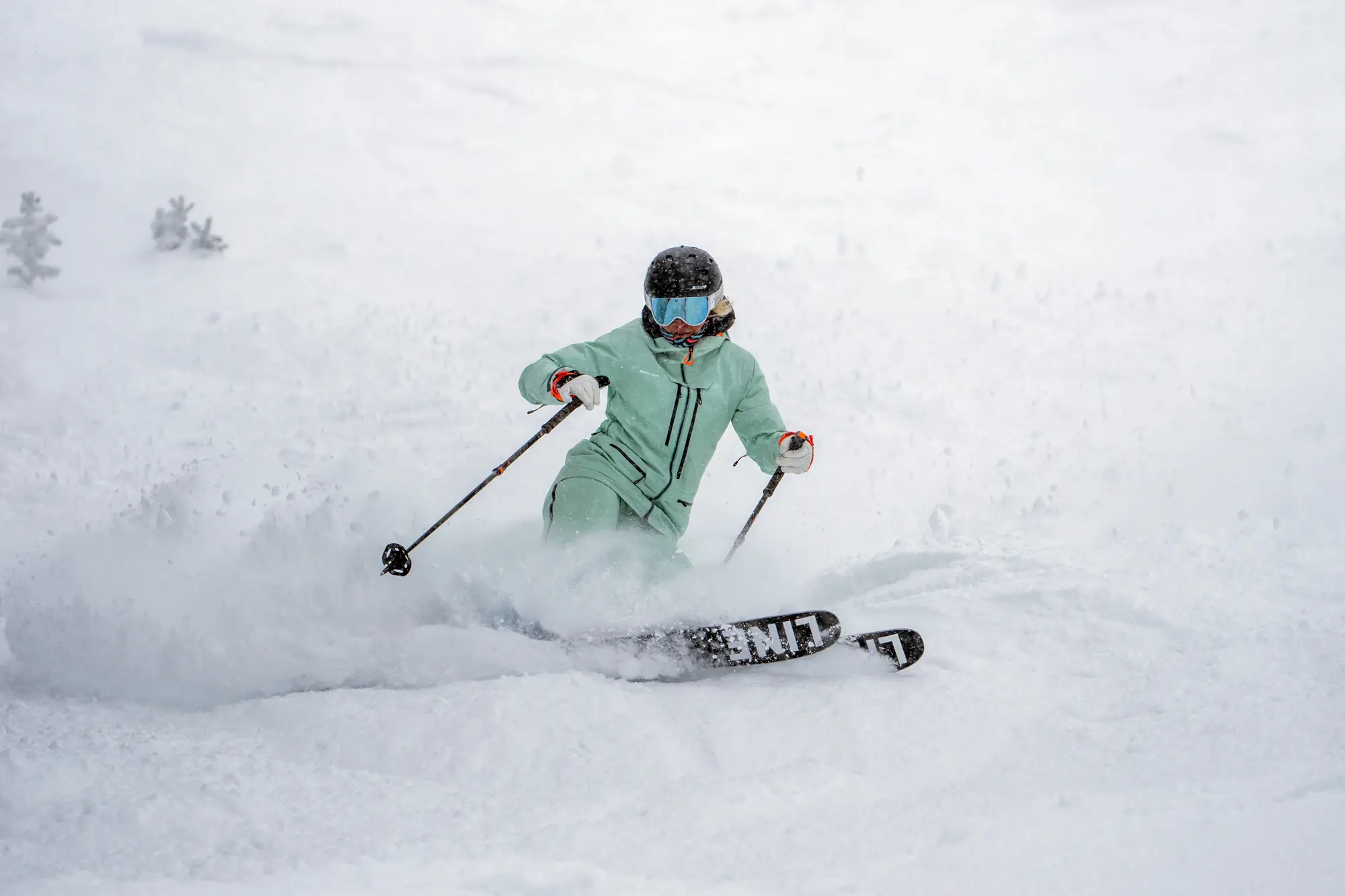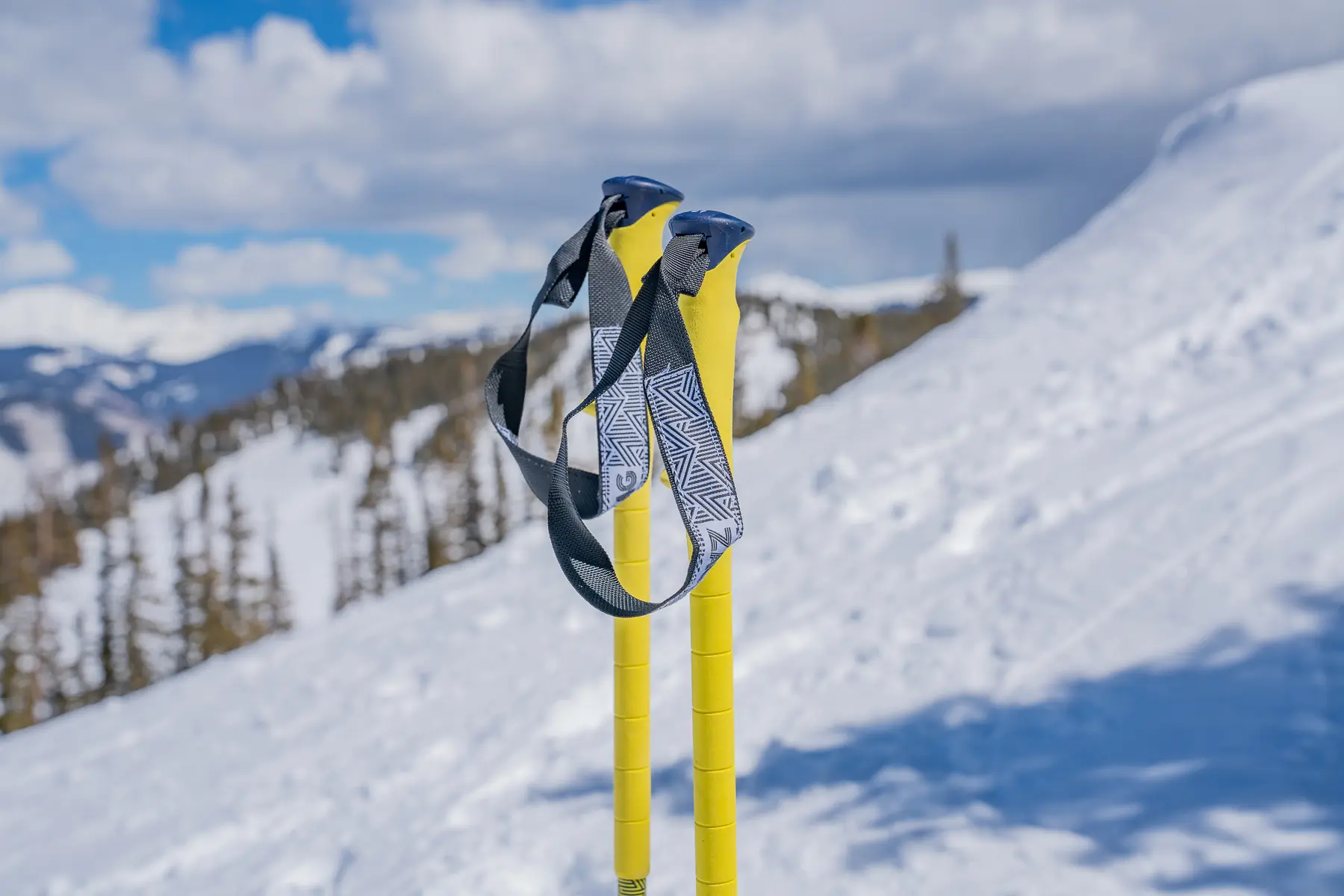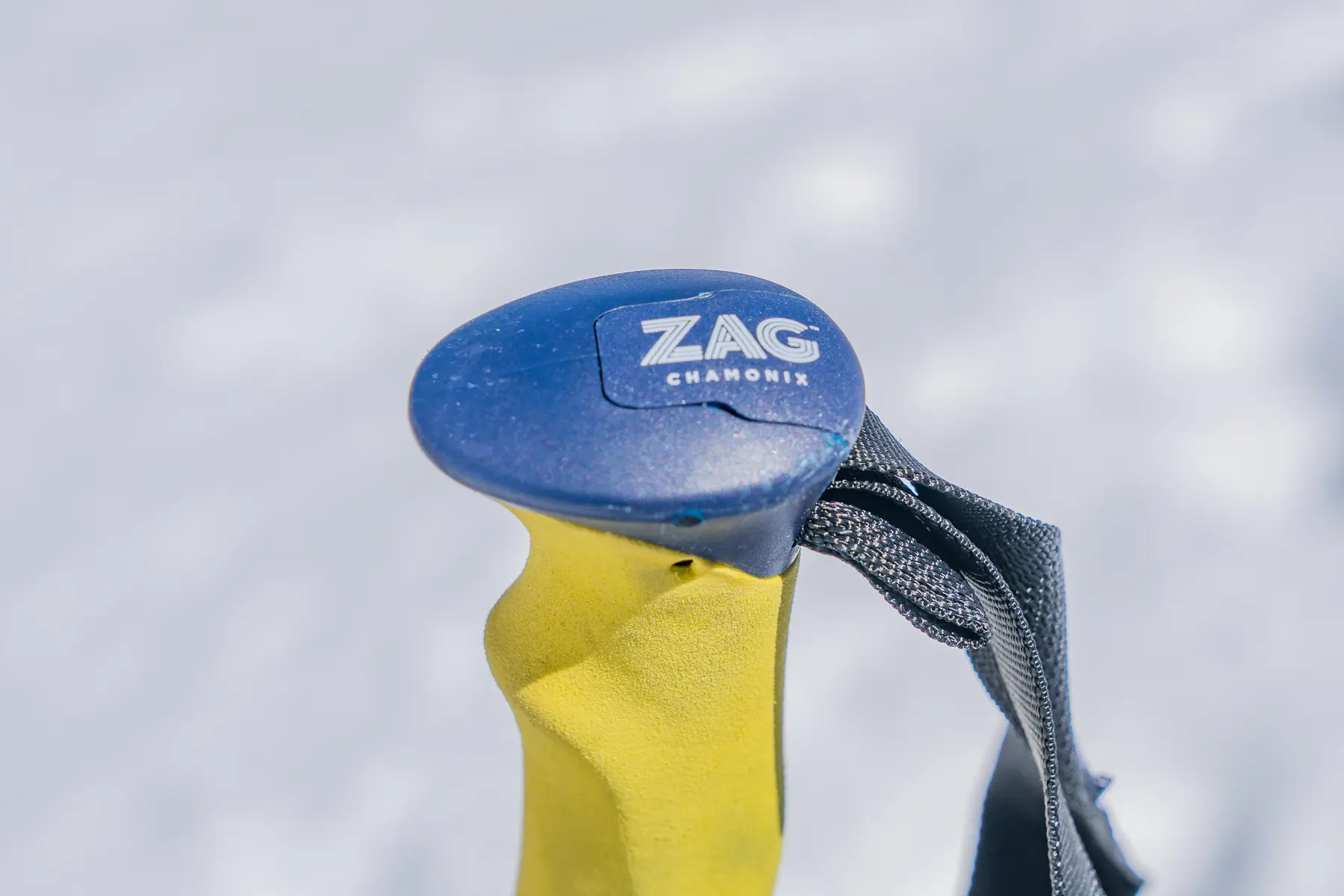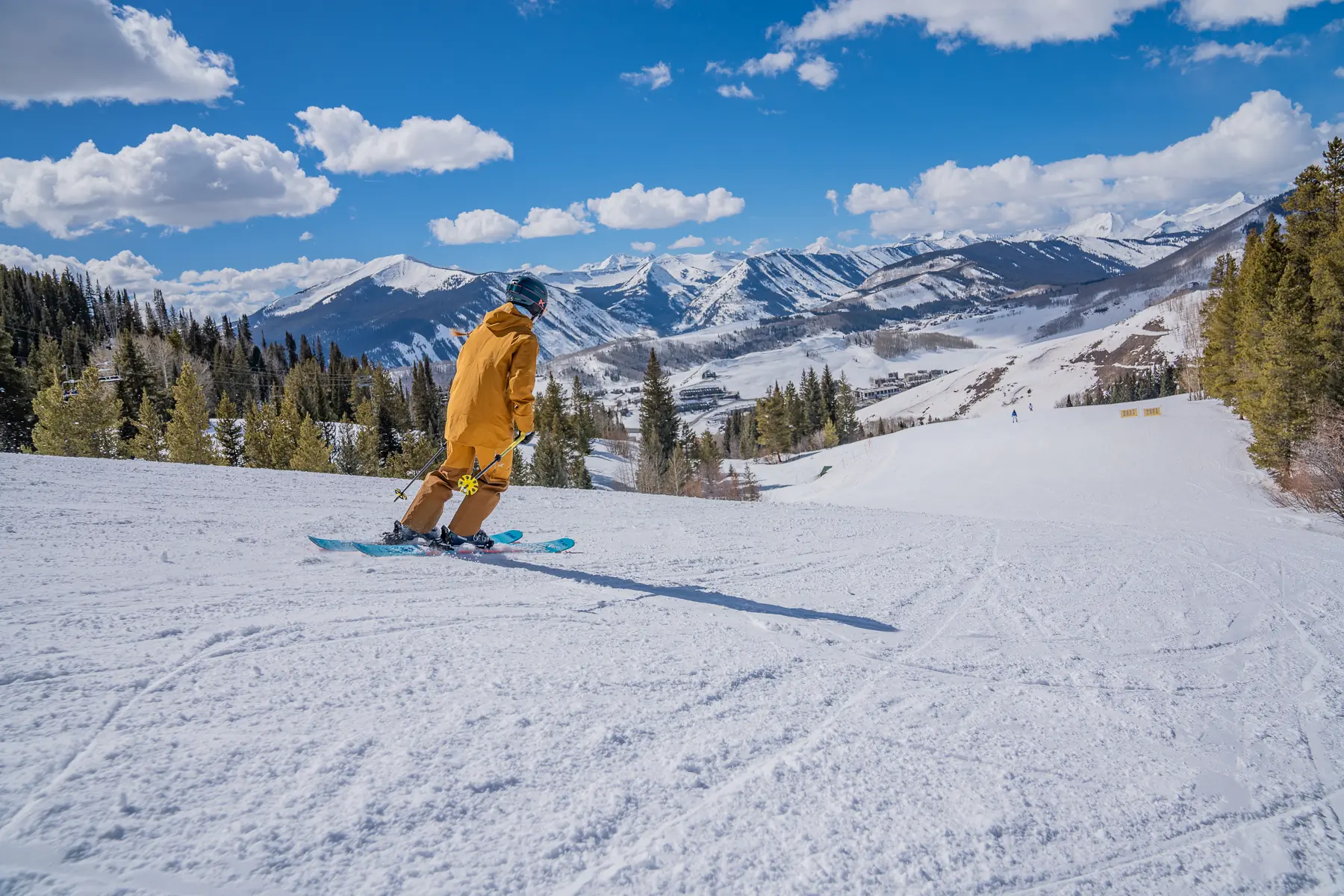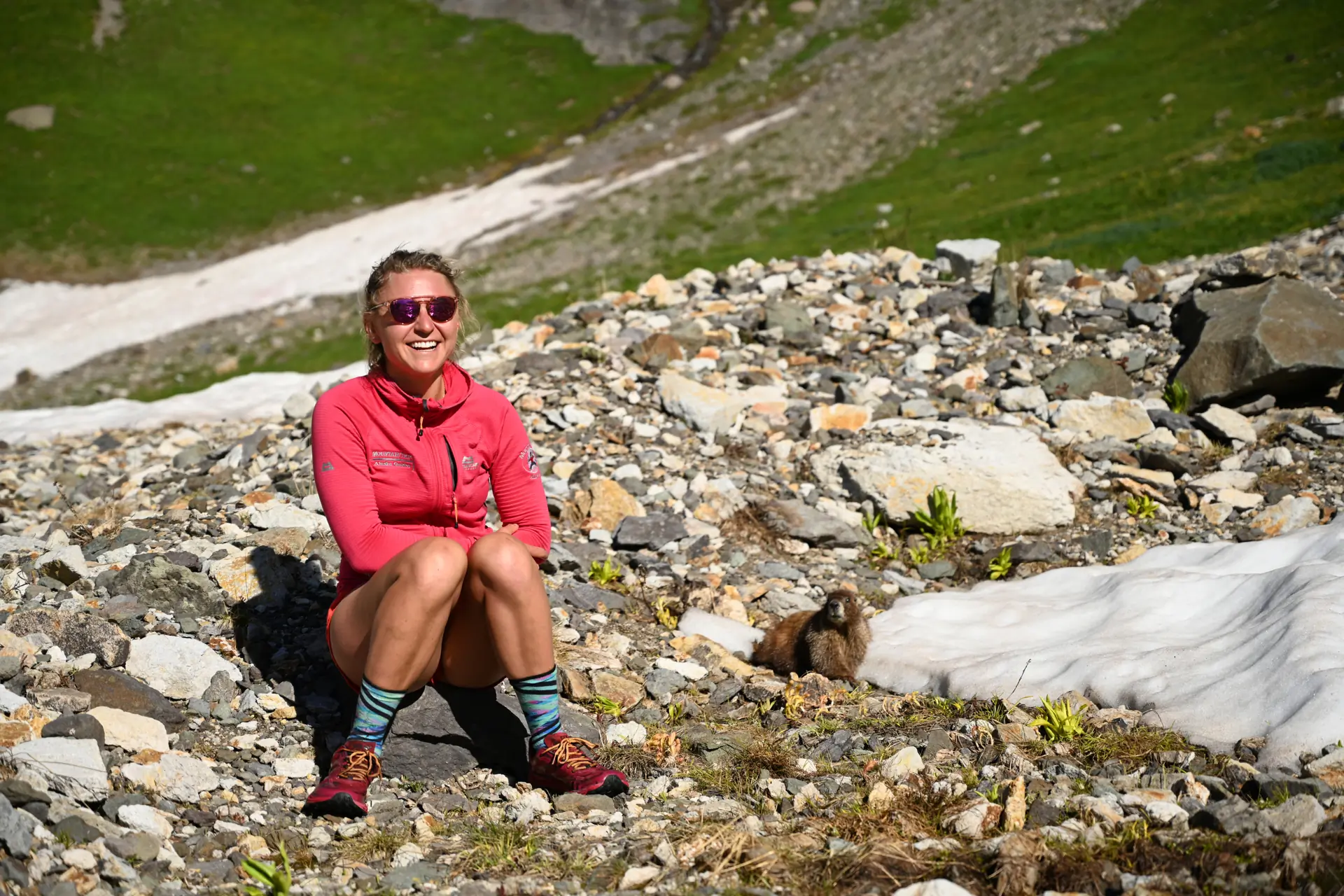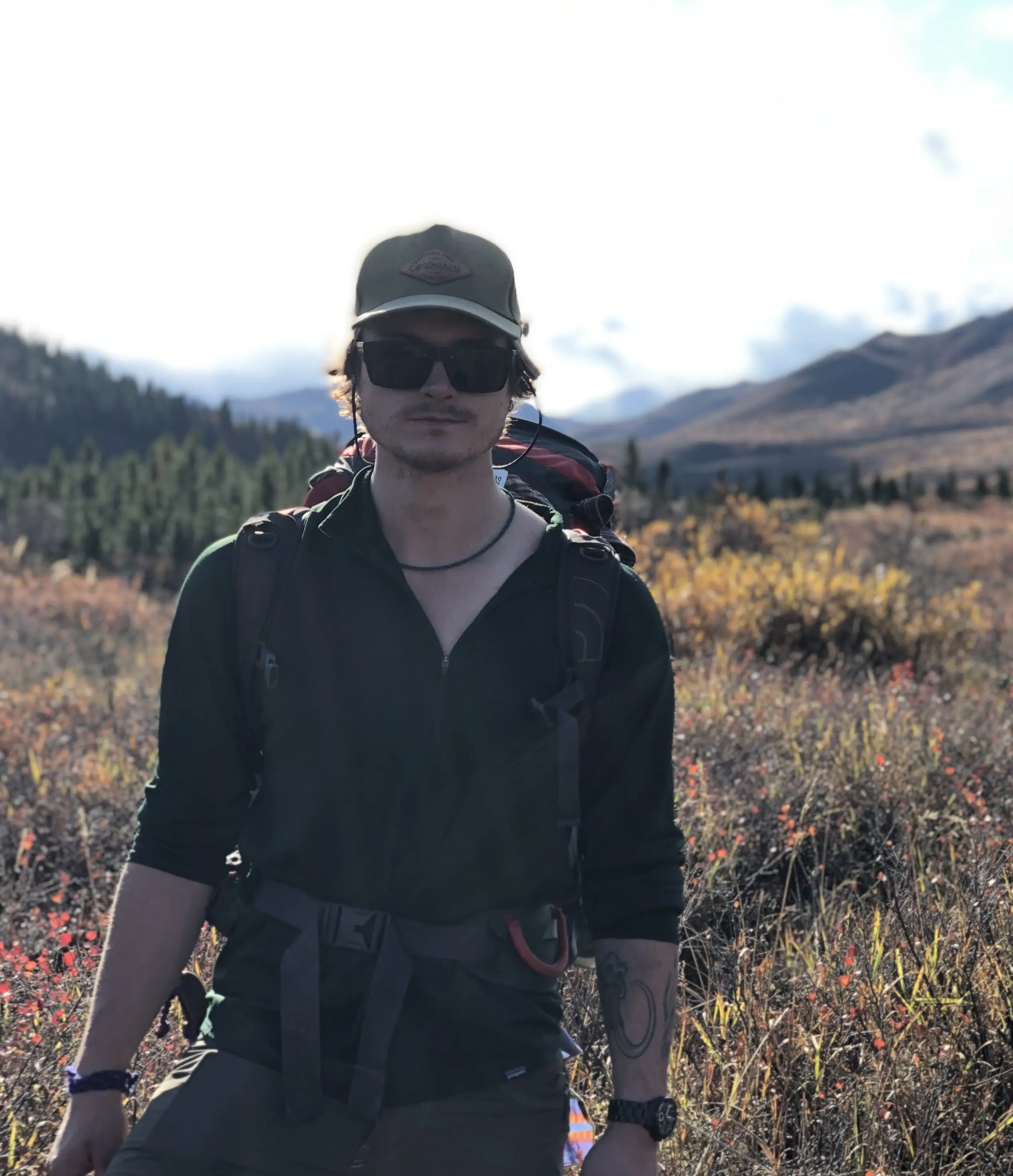High-quality, innovative design has improved today’s best ski poles, but the basic concept remains the same. A pair of ski poles is helpful for balance, rhythmic turning, and propulsion on flat terrain.
Skiers plant their poles dozens, if not hundreds, of times throughout the day. The staff helps us make swooping turns down a groomer, in tight moguls, through deep powder, and assists across the flats. Poles are an essential tool for uphill travel, and as backcountry skiers and splitboarders, we wouldn’t be able to go anywhere efficiently without poles.
There are loads of different ski poles for certain goals. If you’re looking for classic ski poles for resort days check out the Line Vision Poles, which are sturdy, lightweight, and durable. For extra-long grips, don’t overlook the Black Crows Duos Freebird. If you need a three-piece design for easy pack attachment or transport, the G3 Pivot Aluminum Ski Poles is one of our favorite choices.
Editor’s Note: We updated our Ski Poles guide on October 23, 2025, with the field-tested Atomic Backland Poles ski poles. We added an extended rating system that includes Grip and Strap, Basket Size and Shape, Adjustability, and Material and Weight. Take a microscope to the details in our Ski Poles Rating System section below.
The Best Ski Poles of 2025-2026
Line Vision Poles
-
Grip and Strap
8.9
-
Basket Size and Shape
9.0
-
Adjustability
8.5
-
Material and Weight
9.0
- Weight per pole: 8.4 oz.
- Shaft material: Aluminum and Carbon
- Baskets: Powder
- Sizes (cm): One size, adjustable from 90 to 130 cm
- Tip material: Hardened steel with chrome plating
Pros
- Ergonomic grip
- Fun visual design details
Cons
- Straps are a bit small for larger hands and thick for backcountry travel
- Mid-pole adjustment closure tended to slip
Black Crows Meta
-
Grip and Strap
7.5
-
Basket Size and Shape
8.0
-
Adjustability
1.0
-
Material and Weight
9.0
- Weight per pole: 8.1 oz.
- Shaft material: Aluminum
- Baskets: Powder
- Sizes (cm): 105, 110, 115, 120, 125, 130, 135
- Tip: Steel
Pros
- Very affordable
- Durable
- Cool and unique aesthetics
Cons
- Actual color isn’t as bright as advertised
Black Crows Duos Freebird
-
Grip and Strap
9.0
-
Basket Size and Shape
8.0
-
Adjustability
7.5
-
Material and Weight
7.0
- Weight per pole: 8.4 oz.
- Shaft material: Aluminum
- Baskets: Powder
- Sizes (cm): One size, adjustable from 110 to 140 cm
- Tip material: Tungsten carbide
Pros
- Very lightweight, especially for aluminum poles
- Brightly colored and cool look
- Extra long grip
Cons
- The long, less ergonomic grip can be challenging at first
- Relatively expensive
- Not collapsible enough for splitboarders
LEKI Artena Airfoil 3D
-
Grip and Strap
9.0
-
Basket Size and Shape
6.5
-
Adjustability
2.0
-
Material and Weight
7.0
- Weight per pole: 8.5 oz.
- Shaft material: Aluminum
- Baskets: Performance
- Sizes (cm): 105, 110, 115, 120, 125
- Tip material: Carbide
Pros
- Ergonomic strap
- Durable
Cons
- Not ideal for deep snow
LEKI Neolite Airfoil
-
Grip and Strap
7.0
-
Basket Size and Shape
7.0
-
Adjustability
2.0
-
Material and Weight
9.0
- Weight per pole: 7.4 oz.
- Shaft material: Aluminum
- Baskets: Performance alpine, the universal and standard size
- Sizes (cm): 115, 120
- Tip material: Carbide
Pros
- Durable
- Lightweight
- Innovative
Cons
- Limited range of sizes
Atomic Backland Poles
-
Grip and Strap
9.5
-
Basket Size and Shape
8.5
-
Adjustability
9.0
-
Material and Weight
9.0
- Weight per pole: 10.2 oz.
- Shaft material: Aluminum
- Baskets: Powder
- Sizes (cm): Adjustable, 110cm to 130cm
- Tip material: Carbide
Pros
- Poles double as both flathead and Phillips screwdriver
- Lightweight
- SQS safety release system
Cons
- Grips leave black residue on bare hands
Voile Camlock 3 Touring Poles
-
Grip and Strap
9.0
-
Basket Size and Shape
9.0
-
Adjustability
9.0
-
Material and Weight
9.0
- Weight per pole: 11 oz.
- Shaft material: Aluminum
- Baskets: Powder
- Sizes (cm): Adjust from 65 to 135
- Tip material: Unknown
Pros
- Scraper is conveniently located on the top of a hand grip
- Durable
Cons
- Not the most ergonomic hand grips
- Heavier than most other backcountry poles tested – by about 4 oz.
Other Ski Poles We Love Slicing Turns With
-
Grip and Strap
9.0
-
Basket Size and Shape
6.5
-
Adjustability
8.5
-
Material and Weight
7.0
- Weight per pole: 10 oz
- Shaft material: Aluminum
- Baskets: Powder
- Sizes (cm): One size, adjustable from 110 to 140 cm (available in fixed length as well)
- Tip material: Flex tip
Pros
- Nice balance and feel
- Bright pink color
- The integrated glove-strap system works very well
Cons
- Need the LEKI gloves to be used to full potential
-
Grip and Strap
9.0
-
Basket Size and Shape
8.0
-
Adjustability
1.0
-
Material and Weight
9.5
- Weight per pole: 8.8 oz.
- Shaft material: Carbon
- Baskets: Powder
- Sizes (cm): 110, 115, 120, 125, 130, 135
- Tip material: Tungsten carbide
Pros
- Lightweight
- Durable for carbon poles
Cons
- Expensive
-
Grip and Strap
9.0
-
Basket Size and Shape
9.0
-
Adjustability
9.0
-
Material and Weight
8.5
- Weight per pole: 10.5 oz.
- Shaft material: Aluminum
- Baskets: All Mountain Baskets (sold separately, $11)
- Sizes (cm): 105-125 or 115-135
- Tip material: Unknown
Pros
- Comfortable ergonomic hand grips
- Useful utility tabs on handles
Cons
- Does not include an integrated scraper on the grip
- Magnets are not functional
-
Grip and Strap
8.9
-
Basket Size and Shape
8.0
-
Adjustability
9.0
-
Material and Weight
8.0
- Weight per pole: 10.5 oz.
- Shaft material: Aluminum and carbon fiber
- Baskets: Powder
- Sizes (cm): 125, 140
- Tip material: Unknown
Pros
- Easy to adjust
- Lightweight
Cons
- Fairly fragile
-
Grip and Strap
9.3
-
Basket Size and Shape
9.0
-
Adjustability
9.0
-
Material and Weight
9.0
- Weight: 8.1 oz.
- Shaft material: Aircraft-grade 7075 aluminum alloy
- Baskets: Powder
- Sizes (cm): One size, adjustable from 105 to 135 cm
- Tip material: Tungsten carbide
Pros
- Ultralight
- Long grip allows for people allow for quick on-slope adjustments
- Locking mechanism is easy to adjust
- Comfortable grip
Cons
- Strap requires tools to remove
-
Grip and Strap
6.5
-
Basket Size and Shape
7.5
-
Adjustability
2.0
-
Material and Weight
7.0
- Weight per pole: Unknown
- Shaft material: Bamboo
- Baskets: Standard (4″) (and interchangeable)
- Sizes (cm): 90, 95, 100, 105, 110, 115, 120, 125, 130
- Tip material: Unknown
Pros
- Customizable
- Well-made
- Durable
Cons
- Not the most durable straps
-
Grip and Strap
8.0
-
Basket Size and Shape
8.0
-
Adjustability
2.0
-
Material and Weight
8.0
- Weight per pole: 7 oz.
- Shaft material: Aluminum
- Baskets: Powder, Standard
- Sizes (cm): 110, 115, 120, 125, 130, 135
- Tip material: Unknown
Pros
- Lightweight
- Extra grippy and ergonomic handle
- Fun graphics and design
Cons
- Quickly show signs of wear
- Color scheme doesn’t match with all outfits
-
Grip and Strap
9.0
-
Basket Size and Shape
8.0
-
Adjustability
9.0
-
Material and Weight
9.0
- Weight per pole: 7.4 oz.
- Shaft material: Aluminum upper, carbon lower
- Baskets: Powder
- Sizes (cm): One size, adjustable from 110 to 140 cm
- Tip material: Unknown
Pros
- Incredibly lightweight
- Adjustable and fully removable straps
Cons
- Relatively expensive
- Carbon lower shaft makes them less durable
- Weight per pole: 8.6 oz.
- Shaft material: Aluminum
- Baskets: Large, soft
- Sizes (cm): 110-140
- Tip material: Tungsten (long, durable)
Pros
- Lightweight
- Comfortable, pronounced shelf for the palm and forefinger
- Extended, long-reaching grip
- Pull-through adjustable wrist strap
Cons
- Pricier
- Shaft material is not the most resistant to imprints over use
Ski Poles Comparison Chart
Scroll right to view all of the columns: Price, Weight Per Pole, Shaft Material, Sizes (cm), and Tip Material.
| Ski Poles | Price | Weight Per Pole | Shaft Material | Sizes (cm) | Tip Material |
| Line Grip Stick | $90 | 7 oz. | Aluminum | 110, 115, 120, 125, 130, 135 | Steel |
| Leki Neolite Airfoil | $95 | 7.4 oz. | Aluminum | 115, 120 | Carbide |
| Leki Artena Airfoil 3D | $145 | 8.5 oz. | Aluminum | 105, 110, 115, 120, 125 | Carbide |
| Black Crows Meta | $69 | 8.1 oz. | Aluminum | 105, 110, 115, 120, 125, 130, 135 | Steel |
| Komperdell D’Scent Vario | $190 | 7.4 oz. | Aluminum upper, carbon lower | One size, adjustable from 110 to 140 cm | Carbide |
| Black Diamond Razor Carbon Pro | $200 | 10.5 oz. | Aluminum and carbon fiber | 125, 140 | Carbide |
| Folkrm Pahto | $150 | 8.1 oz. | Aircraft-grade 7075 aluminum alloy | One size, adjustable from 105 to 135 cm | Tungsten carbide |
| Atomic Backland | $130 | 10.2 oz. | Aluminum | Adjustable, 110cm to 130cm | Carbide |
| Voile Camlock 3 Touring | $115 | 11 oz. | Aluminum | Adjust from 65 to 135 | Unknown |
| Zag North | $149 | 8.6 oz. | Aluminum | 110-140 | Carbide |
| Black Crows Furtis | $209 | 8.8 oz. | Carbon | 110, 115, 120, 125, 130, 135 | Carbide |
| Leki Spitfire Vario 3D | $165 | 10 oz. | Aluminum | One size, adjustable from 110 to 140 cm | Flex tip |
| Line Vision | $150 | 8.4 oz. | Aluminum | One size, adjustable from 90 to 130 cm | Aluminum |
| Custom Meier Handmade | $120 | 9 oz. | Bamboo | 90, 95, 100, 105, 110, 115, 120, 125, 130 | Unknown |
| G3 Pivot Aluminum | $166 | 10.5 oz. | Aluminum | 105-125 or 115-135 | Carbide |
| Black Crows Duos Freebird | $189 | 8.4 oz. | Aluminum | One size, adjustable from 110 to 140 cm | Carbide |
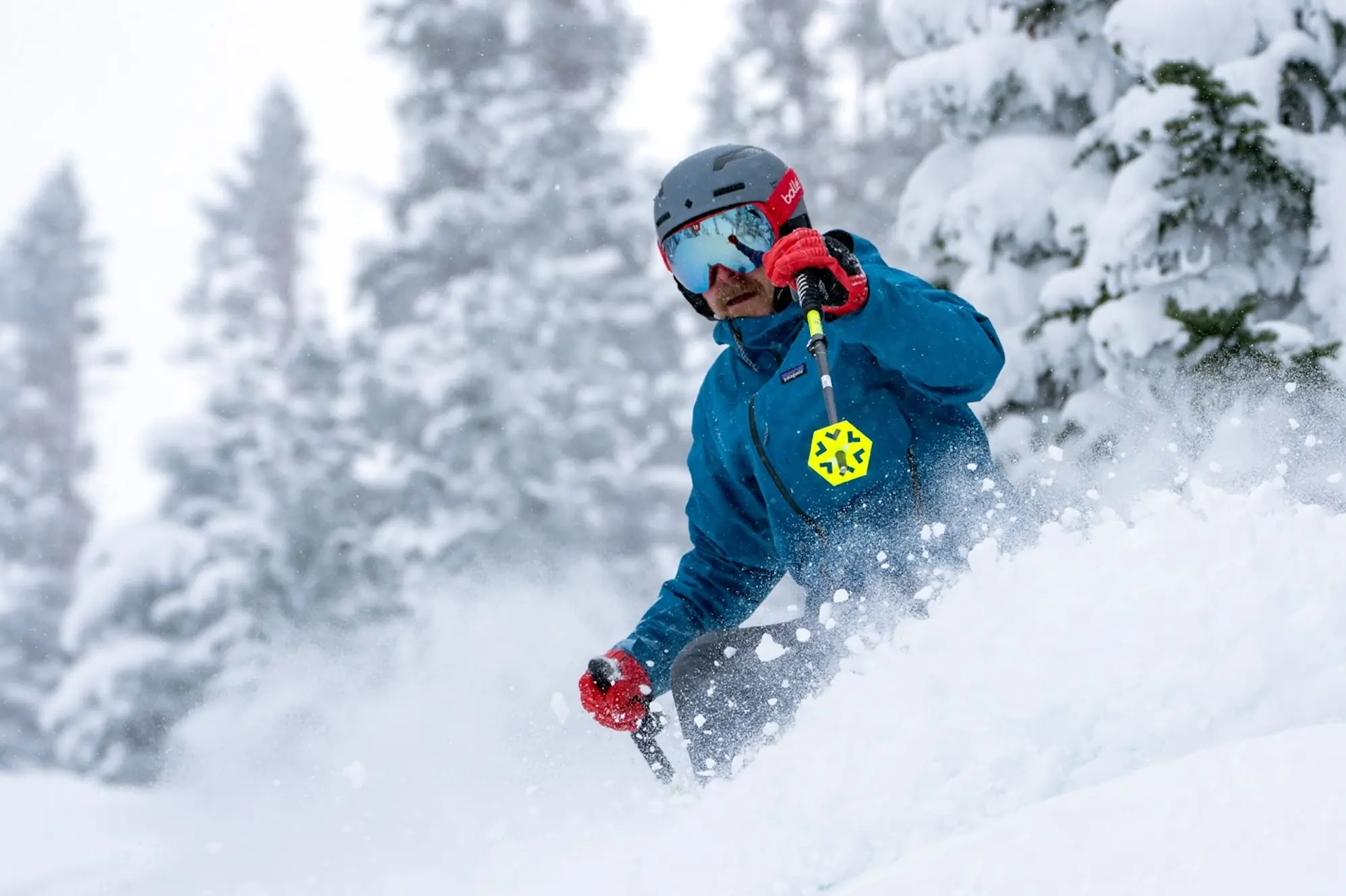
How We Tested Ski Poles
Our GearJunkie testing team is full of passionate skiers with a range of skills exploring mountains in the Rocky Mountains and around the world. We spend as much time as we can putting gear to the test, both uphill and downhill, in the backcountry and inbounds.
Our Expert Testers
Our team of testers has included Kaylee Walden, a lifelong skier, and an American Mountain Guides Association (AMGA) Aspirant Ski Guide. Walden holds her AAA Level 2 Avalanche Certification (the capstone of avalanche education in the U.S.), teaches avalanche courses for Silverton Avalanche School, and guides backcountry skiing.
GearJunkie’s assistant ski editor Will Brendza has been on skis since he was two, taught skiing at Beaver Creek for several years, and has broken more pairs of poles than he cares to admit. That’s why it takes a special pair of sticks to knock his socks off. He spends equal time in the resort and in the backcountry, getting around 75 days a year, and always has a pair of poles with him in testing.
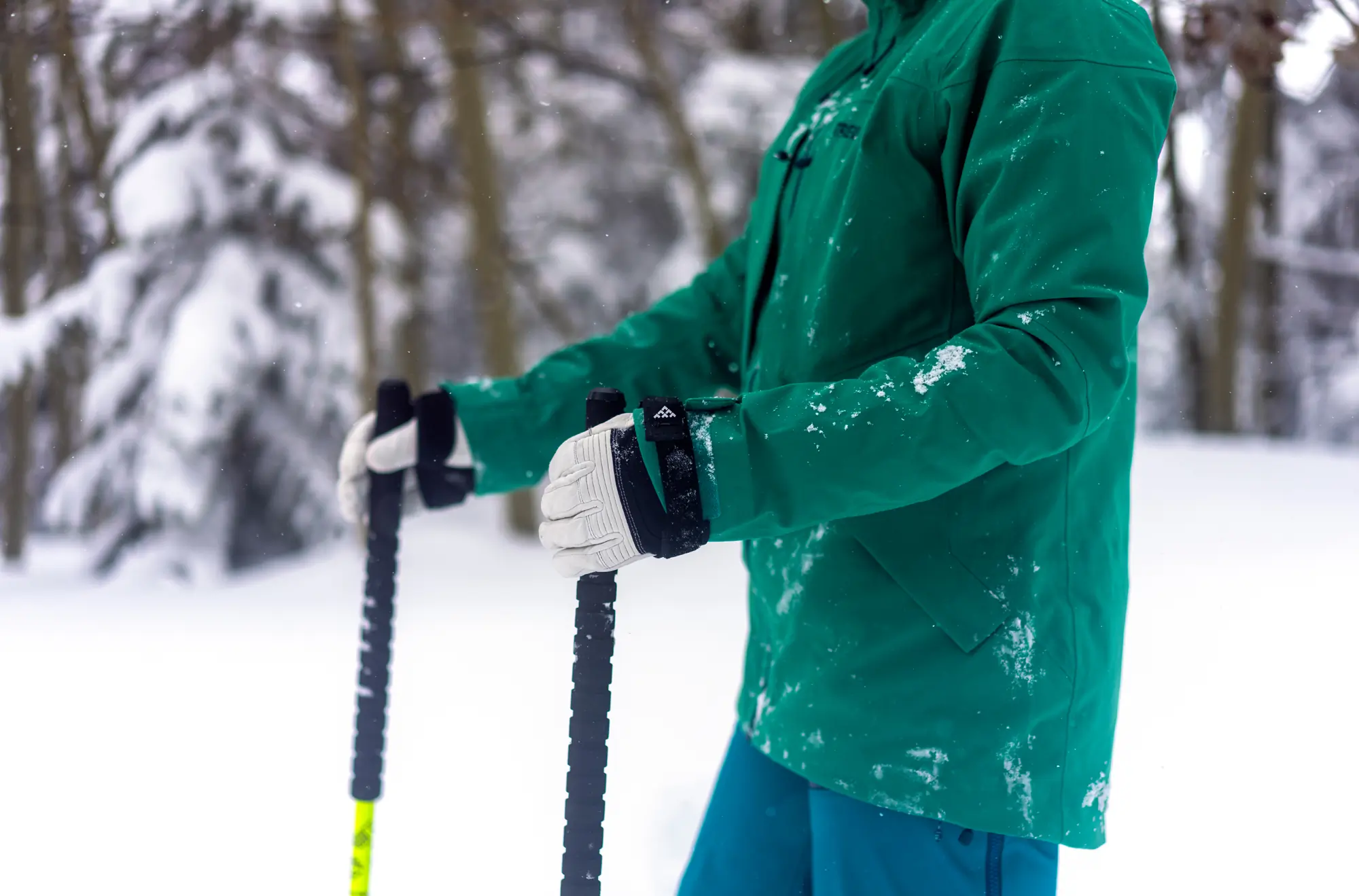



Senior Editor Morgan Tilton specializes in snowsports. She splitboards, alpine skis, and dabbles in skimo and nordic. While she coordinates gear testing for the squad, she puts gear to the grindstone. In 2023, she put ski poles to the test for 84 hours. In the first half of 2024, she’s tested ski poles for 75 hours.
GearJunkie Editorial Director Sean McCoy has contributed testing for this guide. An aggressive skier with 40 years of experience, McCoy started skiing at four years old, slogging across snow-covered golf courses with his parents on ancient wooden cross-country skis. That was in the 1970s.
Contributor Sarah Stubbe also contributed to testing for this guide.
Our Testing Process
Coupled with field tests and our personal experiences, we determined the best ski poles based on a variety of metrics including performance, ergonomics, functionality, quality, durability, and value.
These ski poles serve a range of athletes, applications, and budgets. We’ve also sought out innovative technologies.
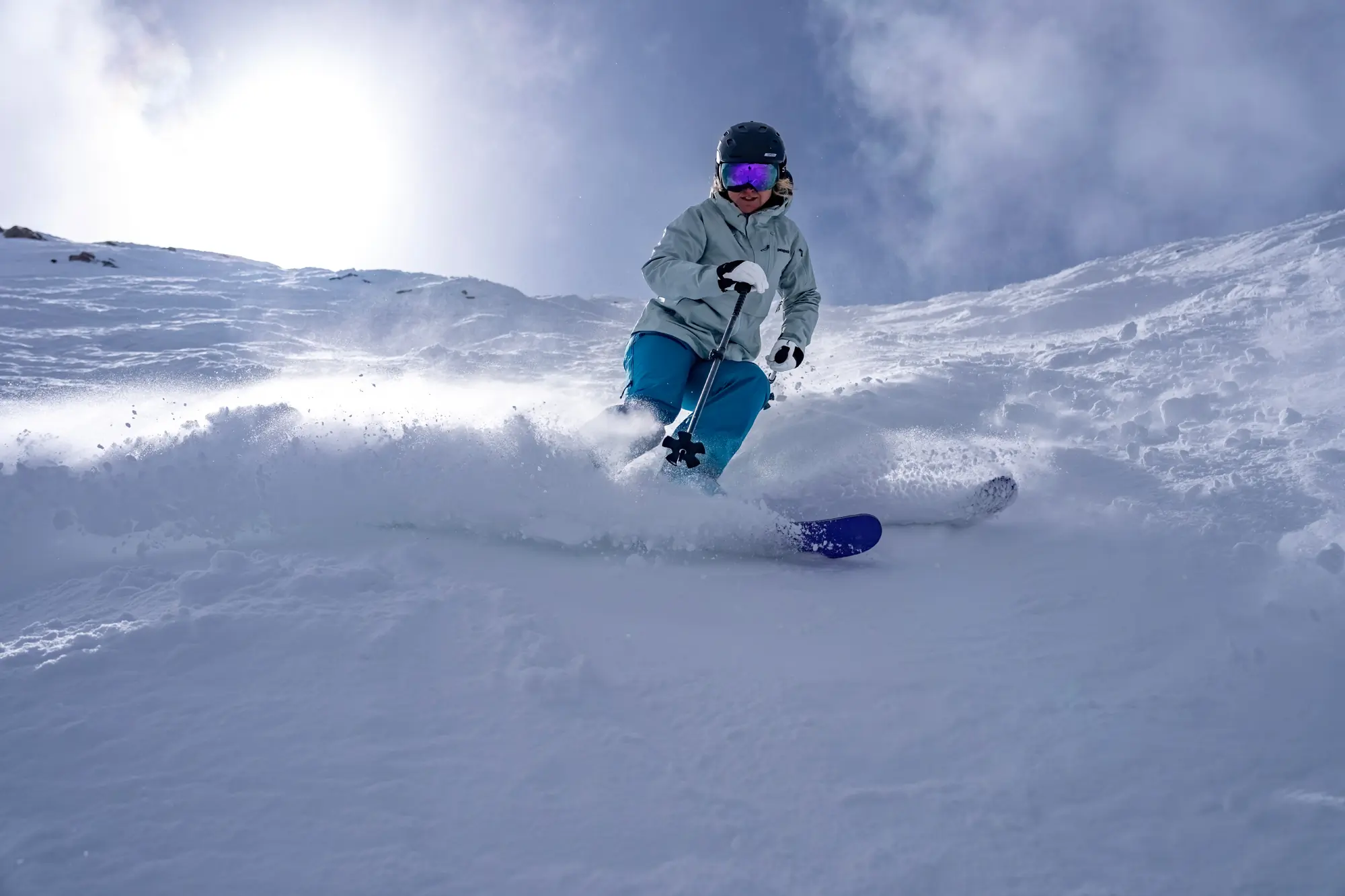



Our Testing Grounds
Today, Brendza spends most of his time skiing in the Gore Range of the Rocky Mountains but often ventures to Colorado’s San Juans, the Park Range, the Elk Range, and even, sometimes, the Front Range. Most winters, he’ll also test gear skiing in other states like Utah and Wyoming, and other countries like Canada and Japan.
Tilton has lived in the high-altitude Rockies of Colorado for more than three decades, where she was born and raised on skis and snowboards and still lives today.
Walden leads expeditions such as Denali for Mountain Trip International. Based in Southwest Colorado, she puts gear to the test everywhere, from her backyard to the Alps to Alaska.
McCoy tends to favor wider skis in his home mountains in Colorado.
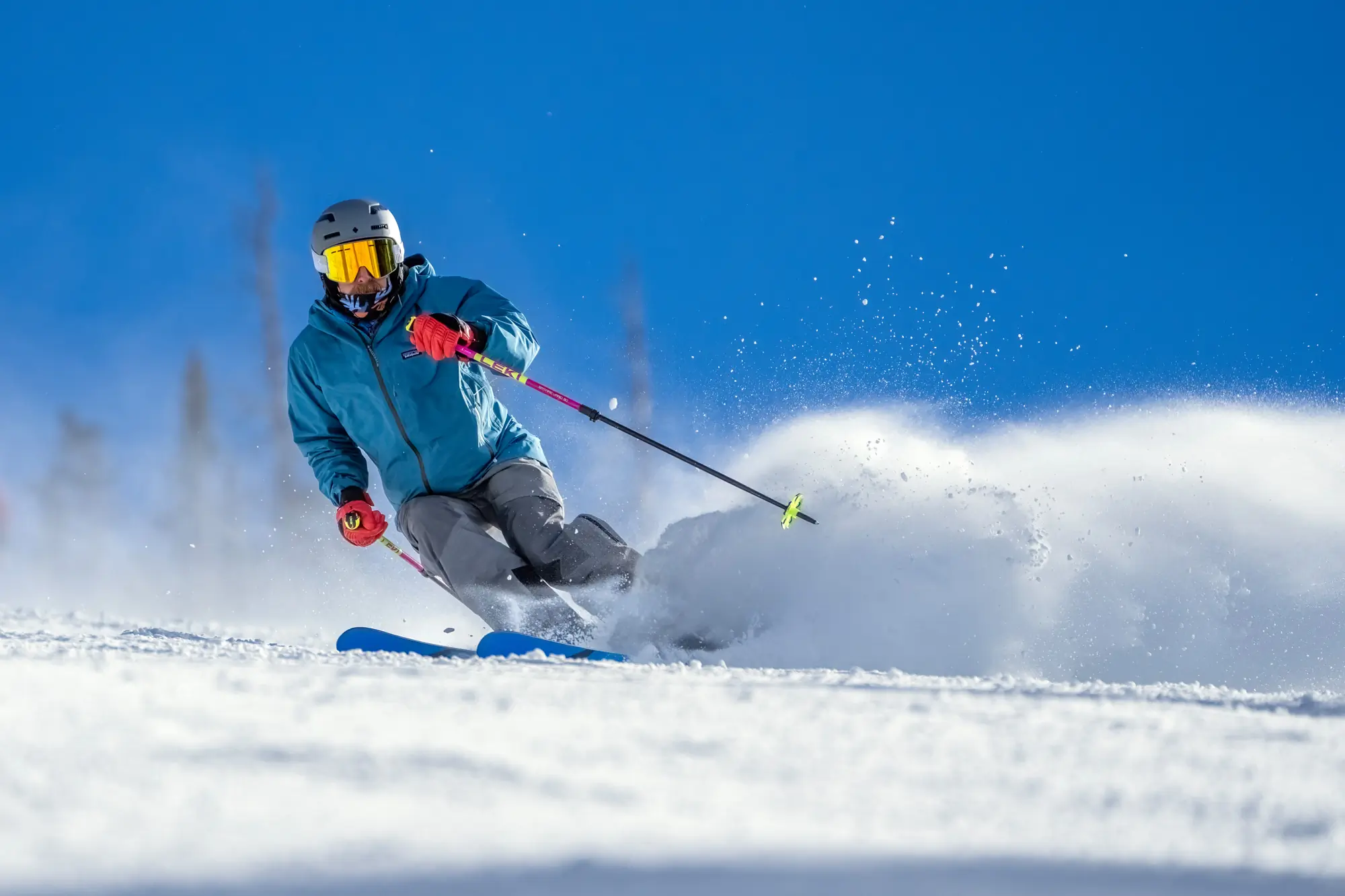



Our Ski Poles Rating System
When choosing ski poles, we assess the Grip and Strap, Basket Size and Shape, Adjustability, and Material and Weight. We score each set of poles on a 1–10 scale.
- We look for lightweight yet durable materials, such as aluminum or carbon fiber, which affect swing weight, stiffness, durability, and overall performance.
- The grip and strap design influences hand comfort, safety, and control. The grips range between ergonomic rubber or foam, and the straps can be adjustable or removable. Higher-end designs have a safety release mechanism versus being fixed.
- The basket size and shape influence how well ski poles perform in different snow conditions. Larger baskets aid powder, and smaller designs are better for groomed runs — baskets with higher-quality materials and construction last longer and in more technical terrain.
- Adjustable or fixed-length poles let skiers fine-tune pole height for various terrain types, touring use, ski pack compatibility, and height. Other adjustable features include removable straps, tips, and baskets.
The Overall Rating is based on contextual, editorial judgment, and the complex user experience across various scenarios and conditions.
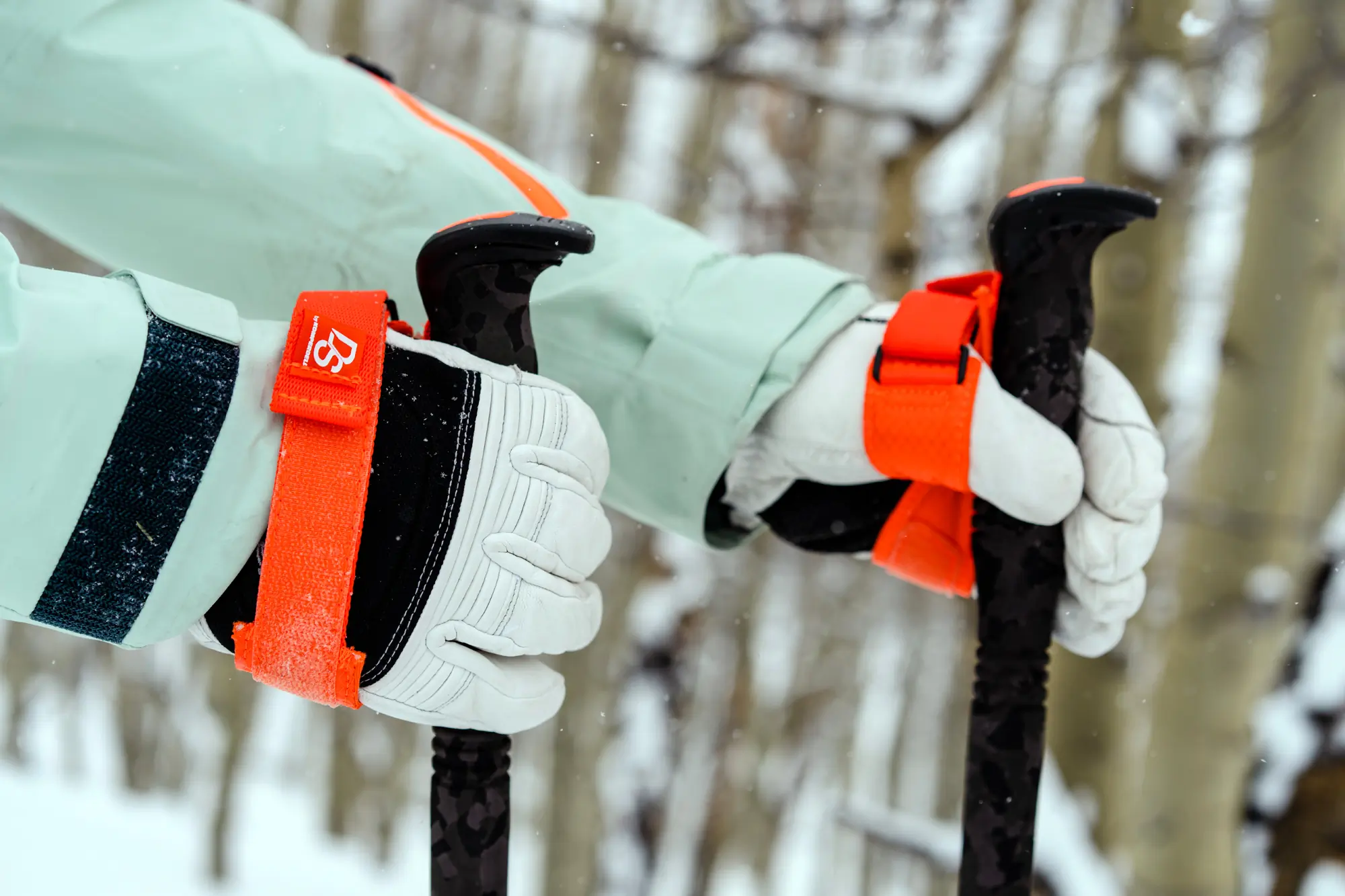



Buyer’s Guide: How to Choose Ski Poles
Most skiers — especially beginners — don’t put a whole lot of thought into their pole selection process. When it comes to choosing ski gear, poles are often an afterthought.
While your poles may not be quite as important as dialing in your skis or ski boots, they’re an essential part of your kit that can truly make or break your time on the mountain. Fortunately, picking out the right pair of poles is a fairly simple and straightforward process.
You’ll want to consider a handful of factors — primarily the price, material, length, and intended use. Once you’ve determined all of these components, you should be able to zero in on a pair of poles that will best fit your needs.
Like everything else involved with hitting the slopes, ski poles can be a bit of an investment, but a good, durable pair should last for many seasons. Consider your goals as a skier to find a pair that will fit your needs for years to come.
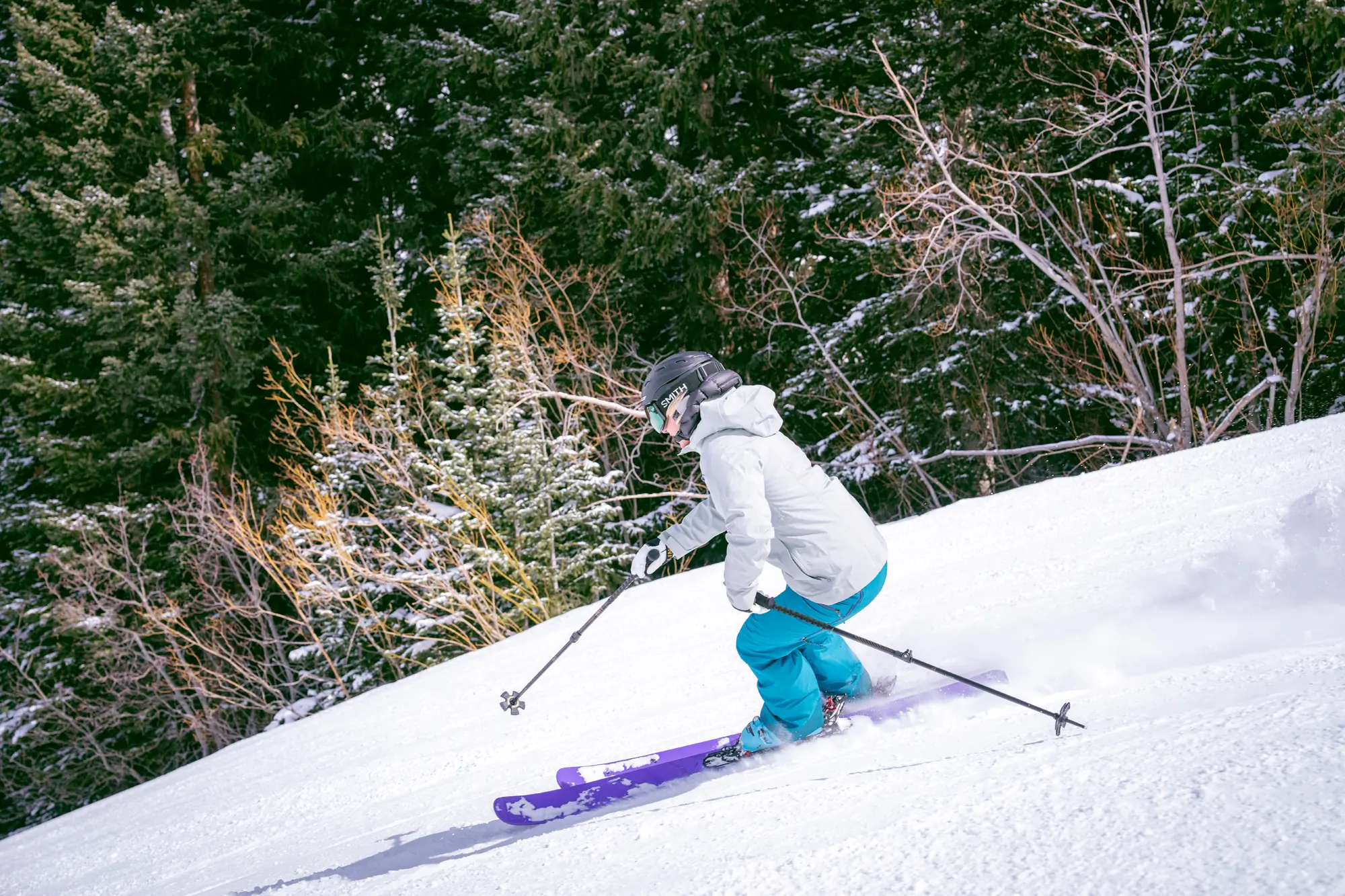



How to Use Ski Poles
While they may seem like an afterthought, ski poles are an important part of downhill skiing and are non-negotiable for backcountry skiing. Poles are an integral factor in perfecting your downhill technique, turn timing, rhythm, and good balance. They help you move through flatter sections of the mountain.
To use poles properly, it’s generally encouraged to loop your hands through the wrist straps at the top of the pole when skiing at the ski resort. Otherwise, use whatever integrated attachment system your poles have, like the unique clip-in system on the Leki Spitfire Vario, to keep a hold of your poles.
When initiating each turn, you’ll gently “flick” the pole out with your palm, lightly plant it into the snow, and initiate your turn around that point while keeping your upper body framed downhill. This movement should be subtle and should help keep you forward and engaged on your skis rather than forcing you to lean back.
The best way to quickly master the proper use of your poles is to take a day with a professional ski instructor to dial in your technique. What may seem to be just a minor detail will quickly help improve your confidence and technique overall.
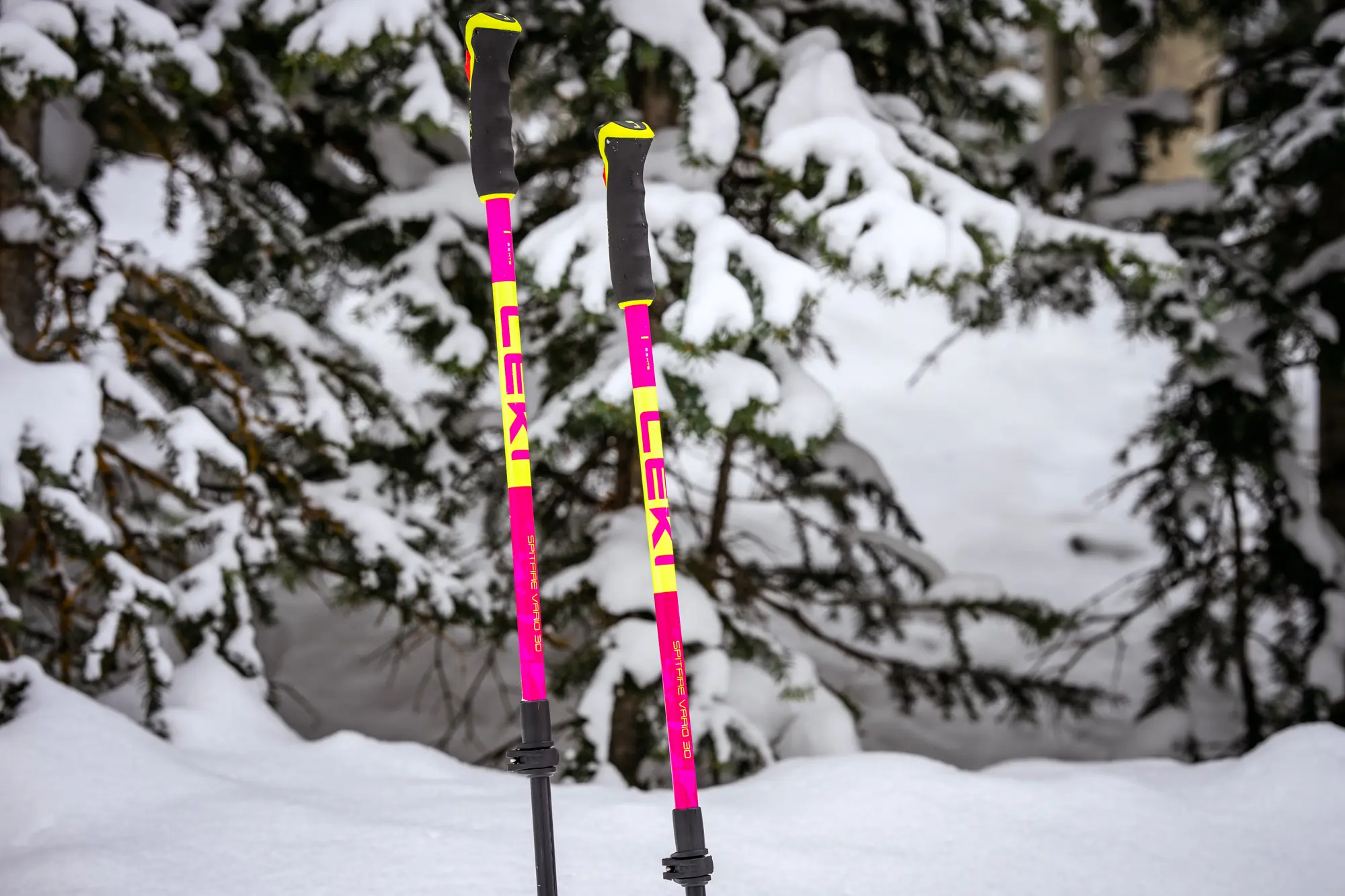



Parts of a Ski Pole
From the top down, the parts of a ski pole are the strap, grip, shaft, basket, and tip. All of those pieces fit and work together to offer a unique ski pole intended for certain skiing styles.
Strap
Those straps have the simple job of keeping your poles wrapped around your wrists throughout the day. Most straps are made from a loop of sewn nylon webbing. Some athletes and coaches also find performance benefits by using the straps, such as with uphill or skimo races or for Nordic skiers. Across splitboarding, alpine skiing, and backcountry skiing, straps can help with efficiency on the ascent and across flat sections.
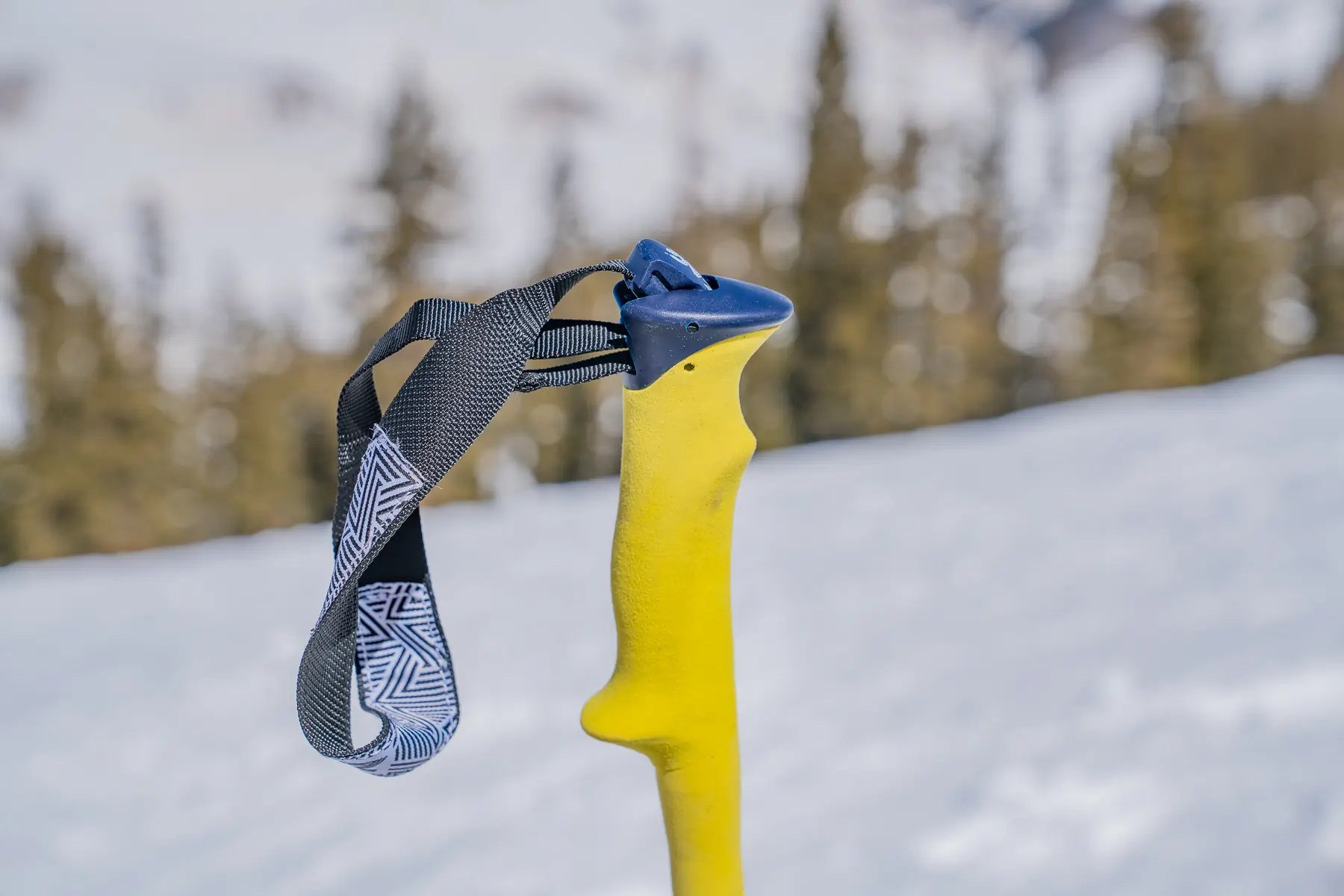



Certain manufacturers attach their straps to the grips with a spring that will separate the pole from the strap in case of a snag or major impact, like on the Leki Neolite Airfoil. These spring-loaded designs may offer helpful safety when skiing through the trees or during a fall.
The Leki Spitfire Vario takes this a step further and has releasable “straps,” which are simply a small, discrete loop system that integrates directly into Leki gloves — no pole straps required. Known as Leki’s signature Trigger 3D system, the setup works best when paired directly with the brand’s gloves for a handy no-strap solution that our team raved about.
The Komperdell D’Scent Vario also has innovative straps that are quickly adjustable with Velcro and detachable with the press of a button. If possible, try to test out ski pole straps with your thick gloves before you buy. Sometimes, straps are not adjustable and may limit dexterity if you wear a thicker glove or mitten while skiing.
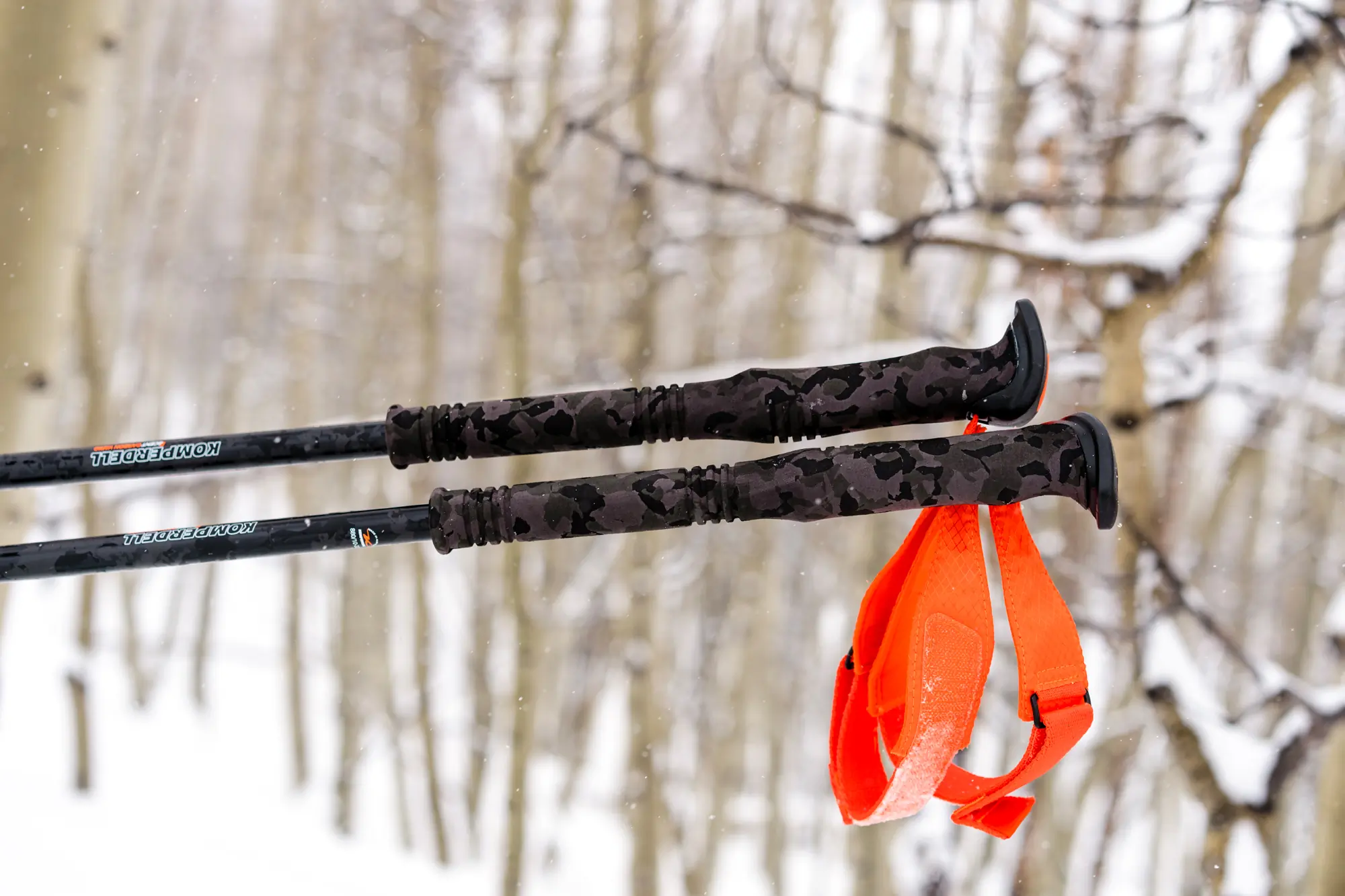



Grip
Ski pole grips are made from plastic, cork, or rubber that’s been molded to fit comfortably into the palm of the hand.
Grips should fit your hand size and feel generally comfortable enough to hold on to all day long. When trying out different grips, we recommend you wear ski gloves to get an accurate sense of how they will feel on the mountain.
Some backcountry ski poles come with secondary grips located partway down the shaft, like in the Komperdell D’Scent Vario. Extended grip poles, like the Black Crows Duos Freebird, are all the rage, especially for backcountry skiing. When uphill touring in the backcountry or traversing along steep terrain, these longer grips can be quite handy.
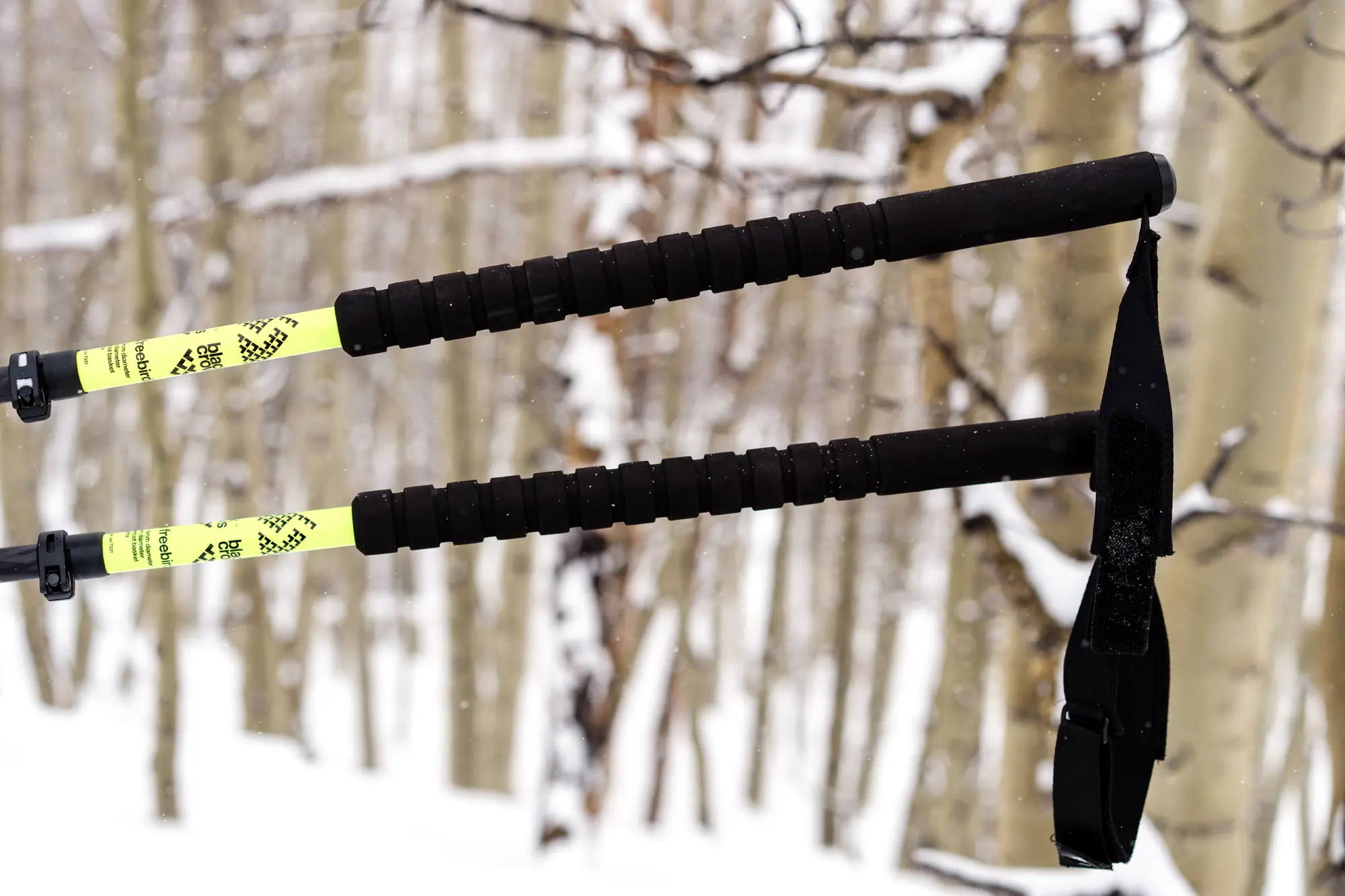



Shaft
The shaft is the main part of the pole, which is typically one continuous piece or two or more separate pieces that slide into one another.
Almost all ski pole shafts are made from aluminum, carbon fiber, or bamboo. Each of these materials has its own pros and cons. Thanks to its convenient balance of durability and relatively low weight, aluminum alloy is by far the most common ski pole shaft material.
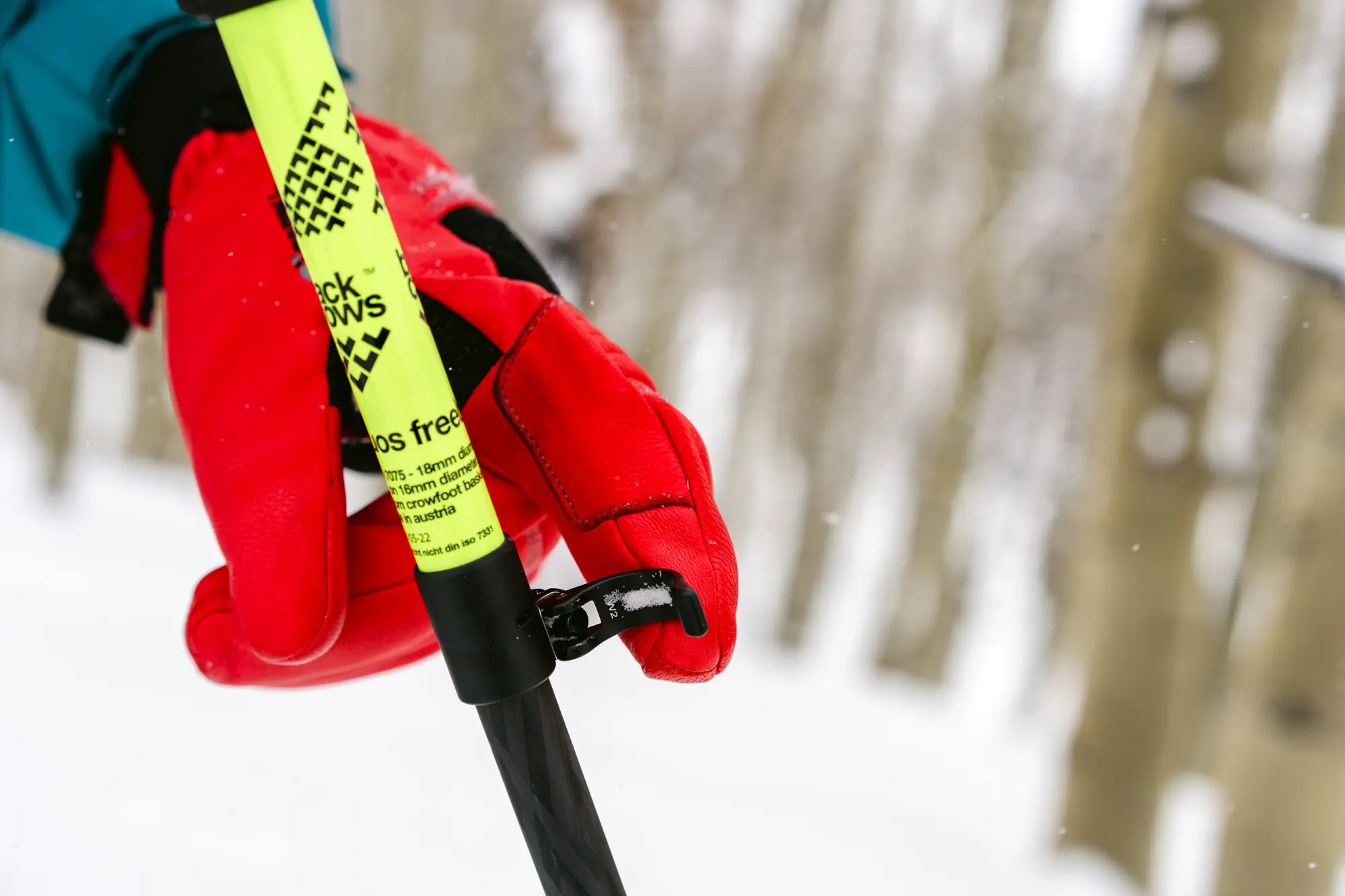



Basket
Baskets are circular pieces of plastic that wrap around the lower part of the shaft, near and above the pole’s tip, to prevent the pole from fully sinking into deep, fluffy snow.
There are two primary types of ski pole baskets: standard and powder.
Powder baskets have a greater circumference than standard baskets because they’re designed to be used in light and soft snow conditions, where standard baskets may not have enough flotation.
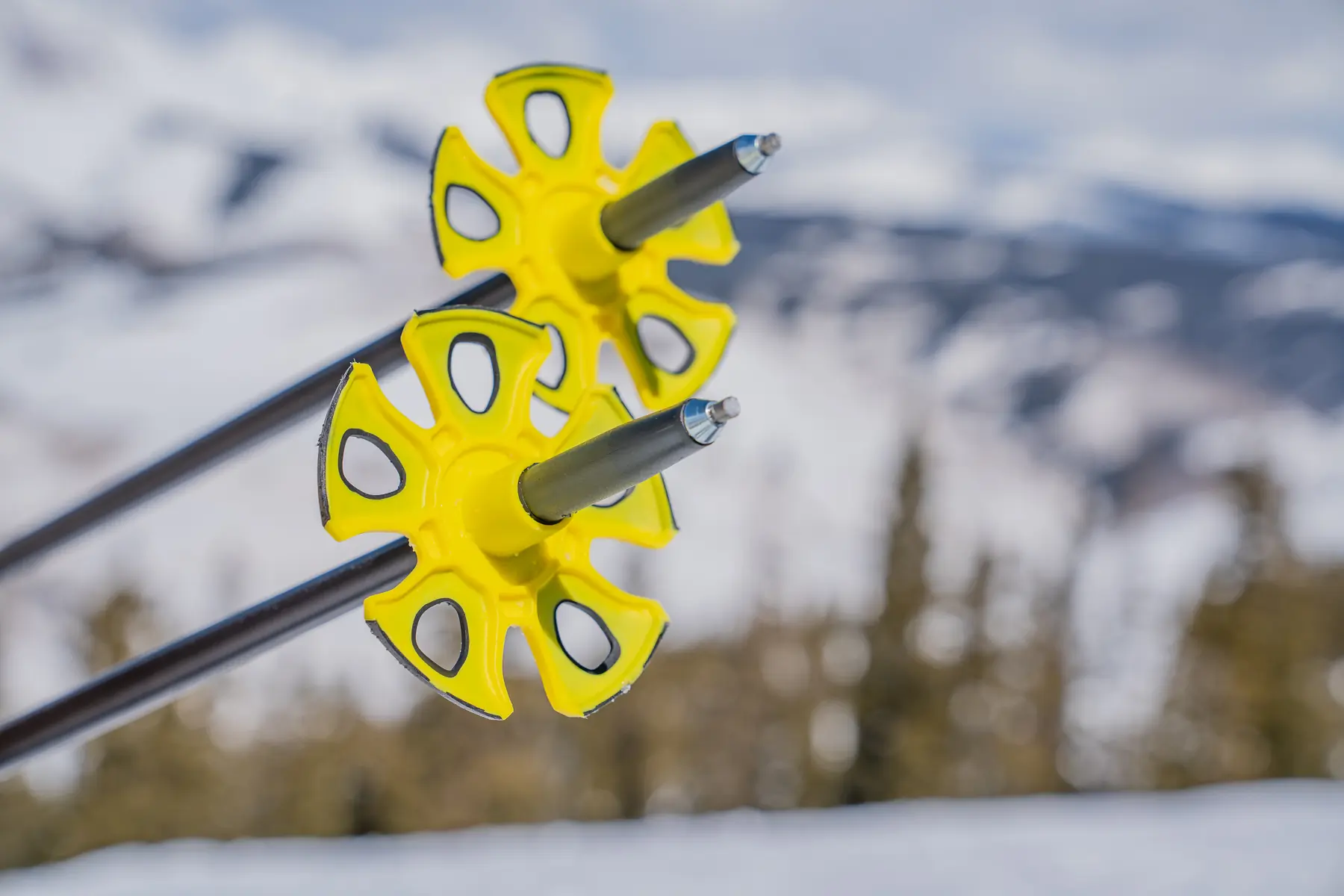



Standard baskets are better for groomed trails and hardpack, whereas skiers want something more streamlined for quick pole plants, like the sleek, trimmed-down basket of the Leki Artena 3D Airfoil. While some poles allow you to swap out the baskets depending on the snow conditions, others are fixed.
We don’t suggest skiing without pole baskets: The tip of the pole will plunge deep into the snow. Additionally, it goes without saying that it’s a bit dangerous to go skiing with essentially two spears in your hands.
Tip
At the end of your pole, beneath the basket, you’ll find a sharp metal implement that’s designed to give the pole purchase on the snow.
Without tips, you wouldn’t be able to propel yourself forward in firm conditions. These tips are usually constructed from steel, carbide, or tungsten.
If you keep your poles for a long period of time, these tips can become dull. Most higher-end poles allow you to simply screw off and replace the tip. Having a sharper tip is more important for Nordic skiing and racing, styles that rely on firmer snow conditions.
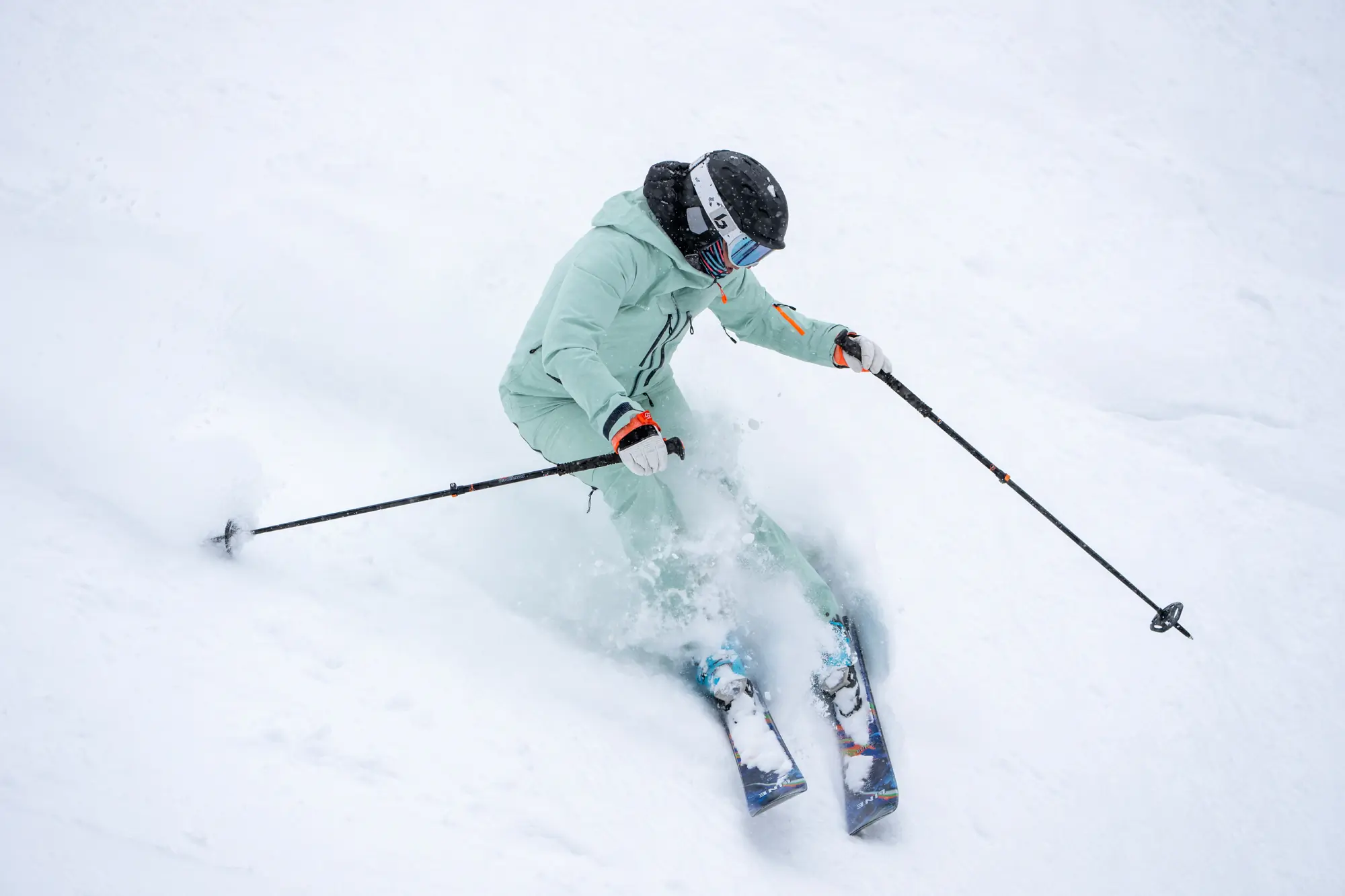



Ski Pole Materials
The bulk of a ski pole is the shaft, which is generally made of aluminum, carbon, a hybrid of the two, or bamboo.
Aluminum
In general, aluminum bends before it breaks, and aluminum poles can often be repaired after skiing-related damage. Not all aluminum poles are created equal, and some are much less durable than others.
The strength and weight of aluminum poles depend on the grade and thickness of the material. High-quality aluminum offers a better strength-to-weight ratio than cheap, fragile, and heavy stuff.
Perhaps the biggest benefit of aluminum is its low cost. For $50-100, skiers of all levels can purchase a high-quality pair of aluminum poles.
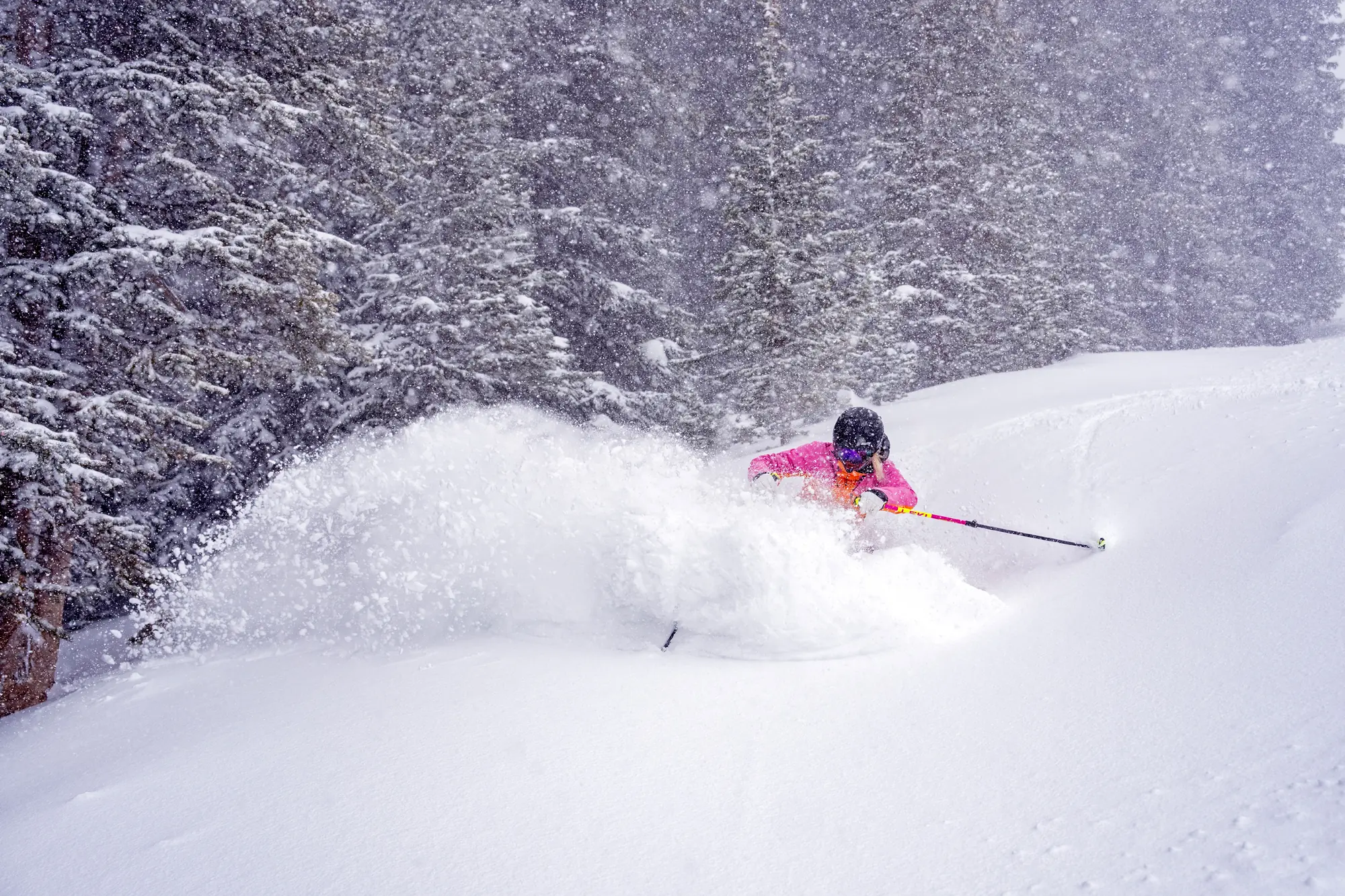



Carbon Fiber
Carbon fiber ski poles are becoming increasingly popular — especially among backcountry skiers. Of course, carbon fiber is extremely lightweight, which makes it ideal for long, arduous days in the mountains.
Even though many of the best ski poles on the market are made from carbon fiber, the material does have some unfortunate downsides. Unlike aluminum, carbon fiber is prone to splintering and shattering under high impact. If you like to ride on rough terrain filled with obstacles such as rocks and trees, carbon fiber poles may be too fragile.
Additionally, carbon poles are far more expensive than aluminum poles. Some backcountry-specific poles combine aluminum and carbon fiber in their design to create the perfect balance of weight and durability. Among our favorite choices for carbon poles are the Black Diamond Razor Carbon Pro and the Komperdell D’Scent Vario, both of which blend both carbon and aluminum in their construction.
For a high-end pair of fully carbon fiber poles, expect to pay $100-200.
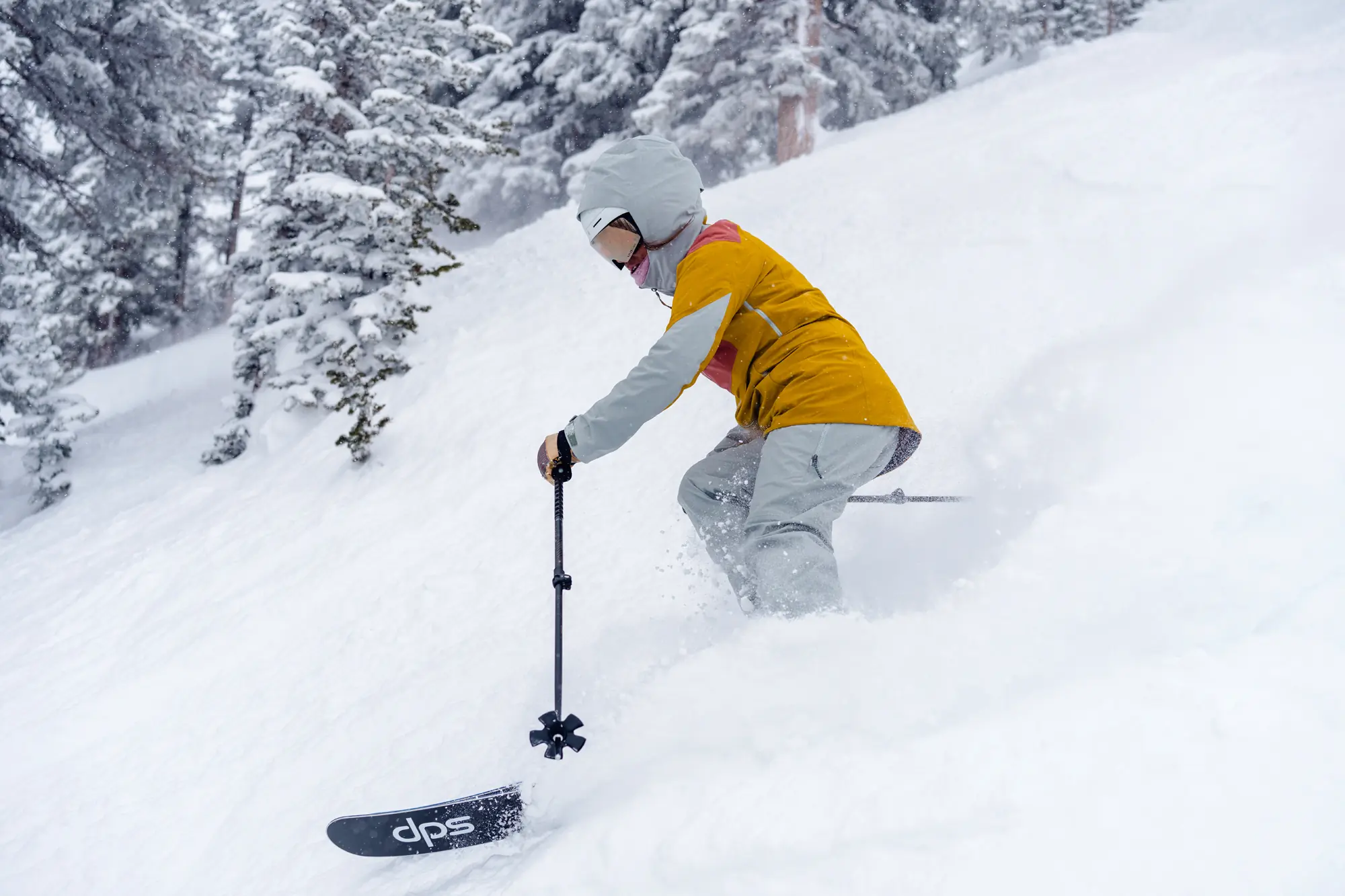



Bamboo
Skiers have been using bamboo ski poles since long before the advent of the chairlift. Still, only recently have bamboo poles enjoyed a resurgence among downhill skiers.
There are numerous benefits to bamboo. First, it just looks really cool. Case in point: The Custom Meier Handmade Bamboo Ski Poles. More importantly, bamboo poles are strong, light, and relatively low-impact to manufacture.
Though bamboo poles don’t offer the precise performance characteristics of carbon fiber, they do possess a nice balance of flexibility and rigidity. Bamboo poles typically cost $50-150.
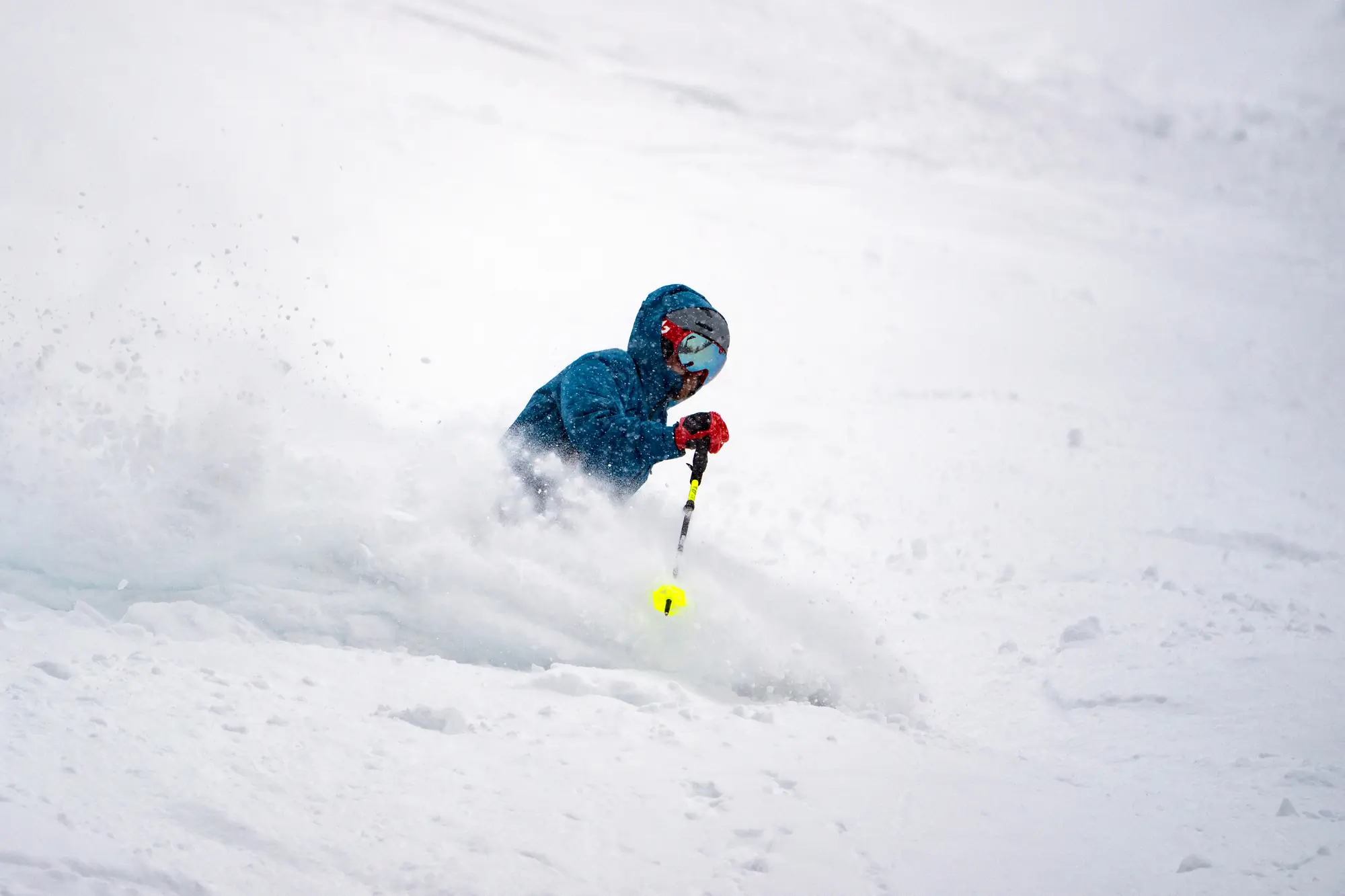



Ski Pole Length
It’s essential to select a ski pole that fits your height and preferred skiing style. If you end up with poles that are too long or too short, your skiing posture and experience will be compromised.
Properly fitted ski poles are essential for feeling balanced and smooth while moving down the mountain and transitioning between turns. Most manufacturers provide charts that will recommend a ski pole length based on your height. While these charts are helpful guidelines, they lack a bit of nuance.
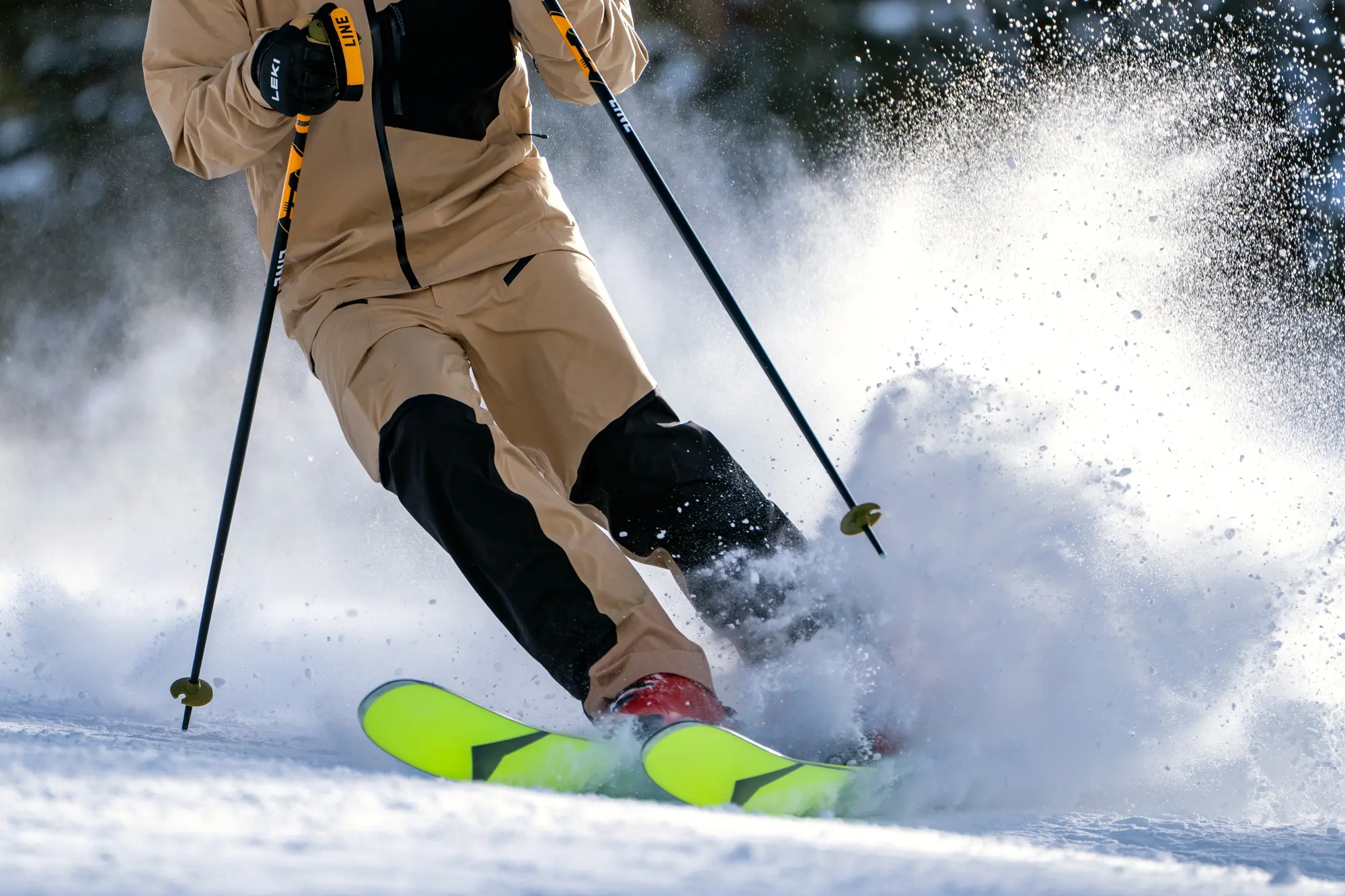



Groomers
If you plan to primarily ski groomers, your elbows should be bent at a 90-degree angle when the poles are straight up and down and the grips are in your hand. If you need to determine your ideal pole length without using an actual pole, assume the position and use a measuring tape to find the distance between your hand and the ground. We recommend wearing ski boots while you measure for maximum accuracy.
Terrain Park
In the terrain park, most skiers prefer poles that are shorter than the standard downhill length. When setting up to hit a rail or huck a backflip, long poles simply get in the way. If shredding the park is your thing, we recommend poles about 10 centimeters shorter than your normal preferred length. The Line GripStick or Black Crows Meta would make perfect park skiing poles.
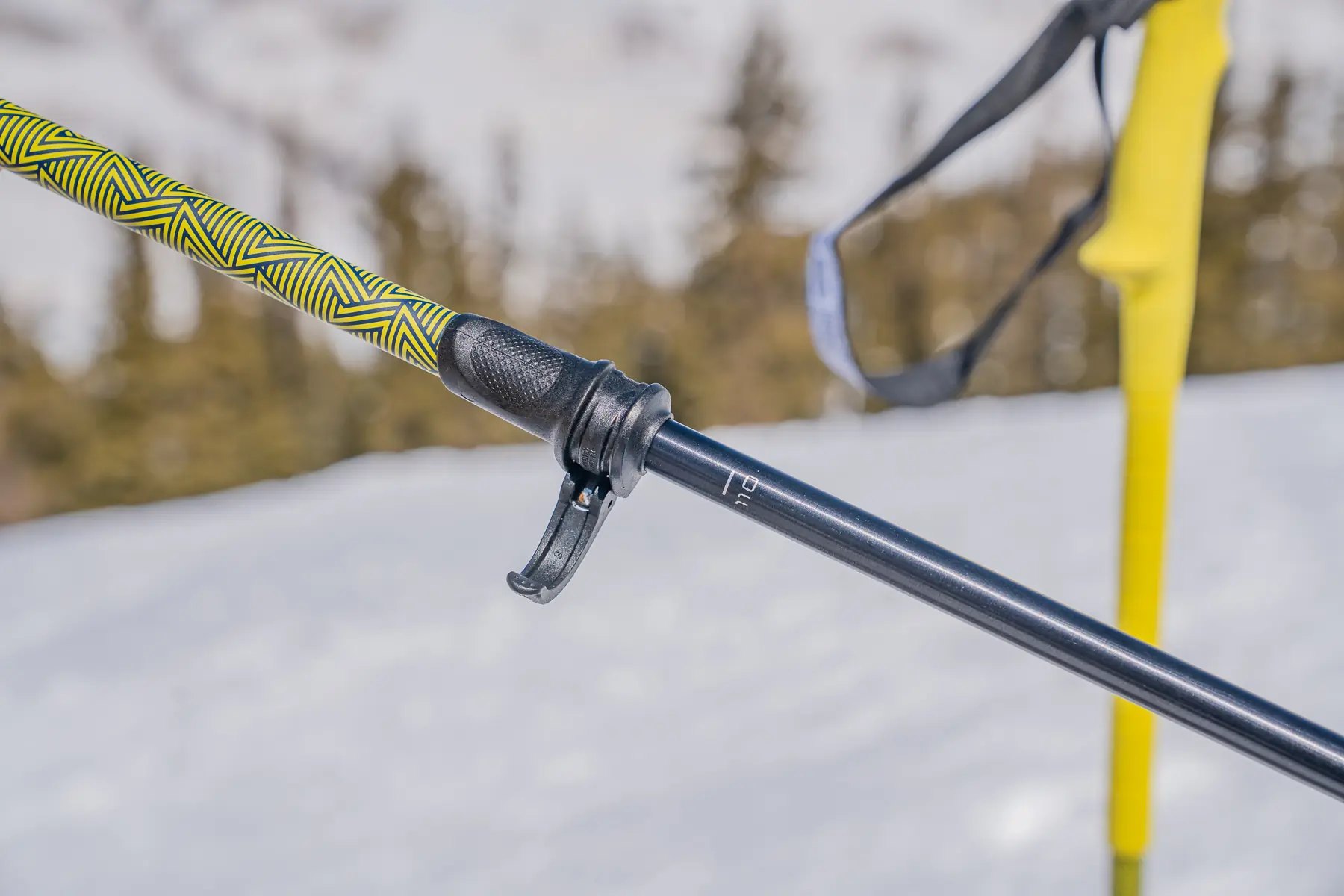



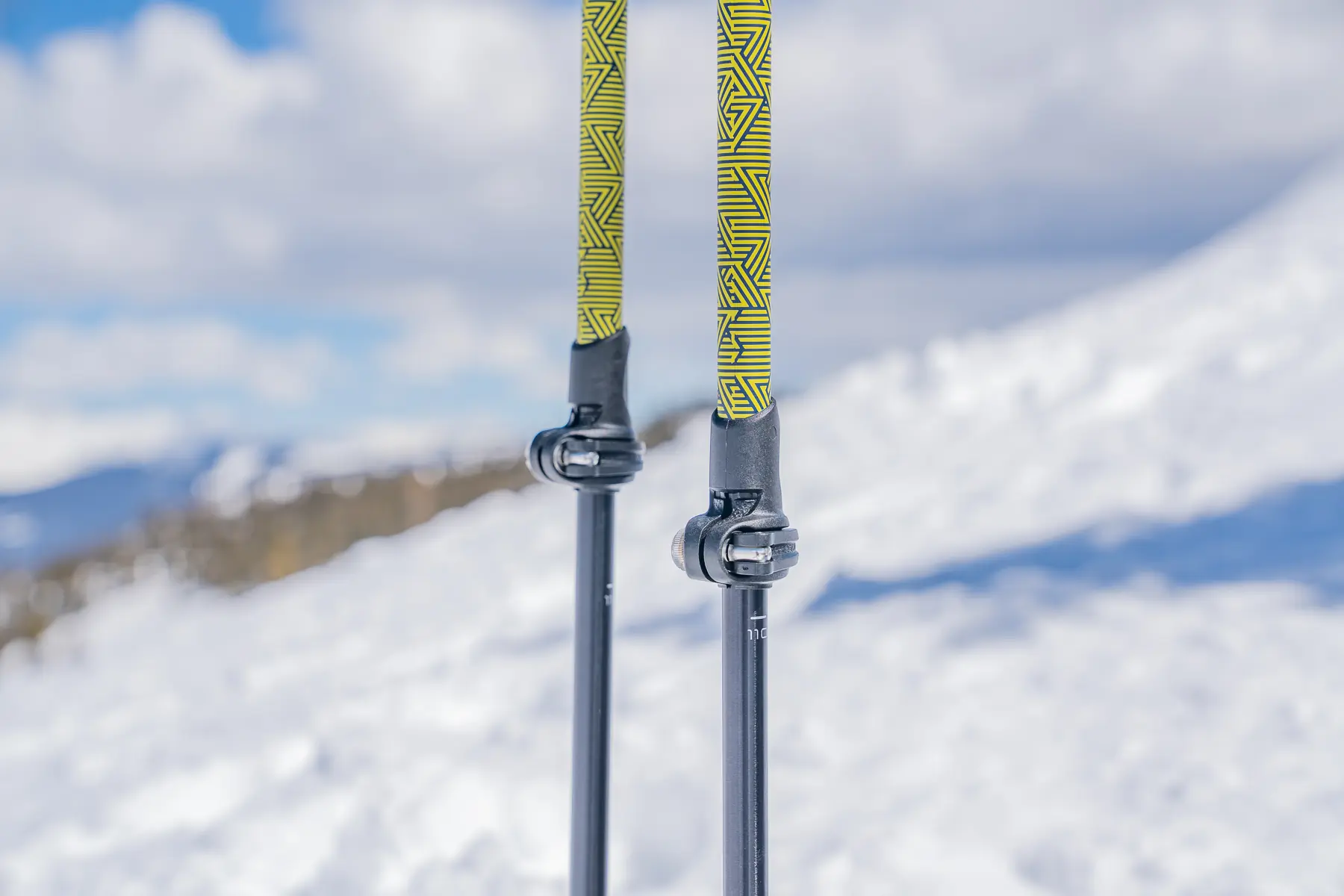



Adjustable Length
Adjustable telescoping ski poles may take some of the guesswork out of the process of selecting a particular size and add more versatility for different styles of skiing.
Telescoping ski poles have two or more shafts that slide together to lengthen or shorten.
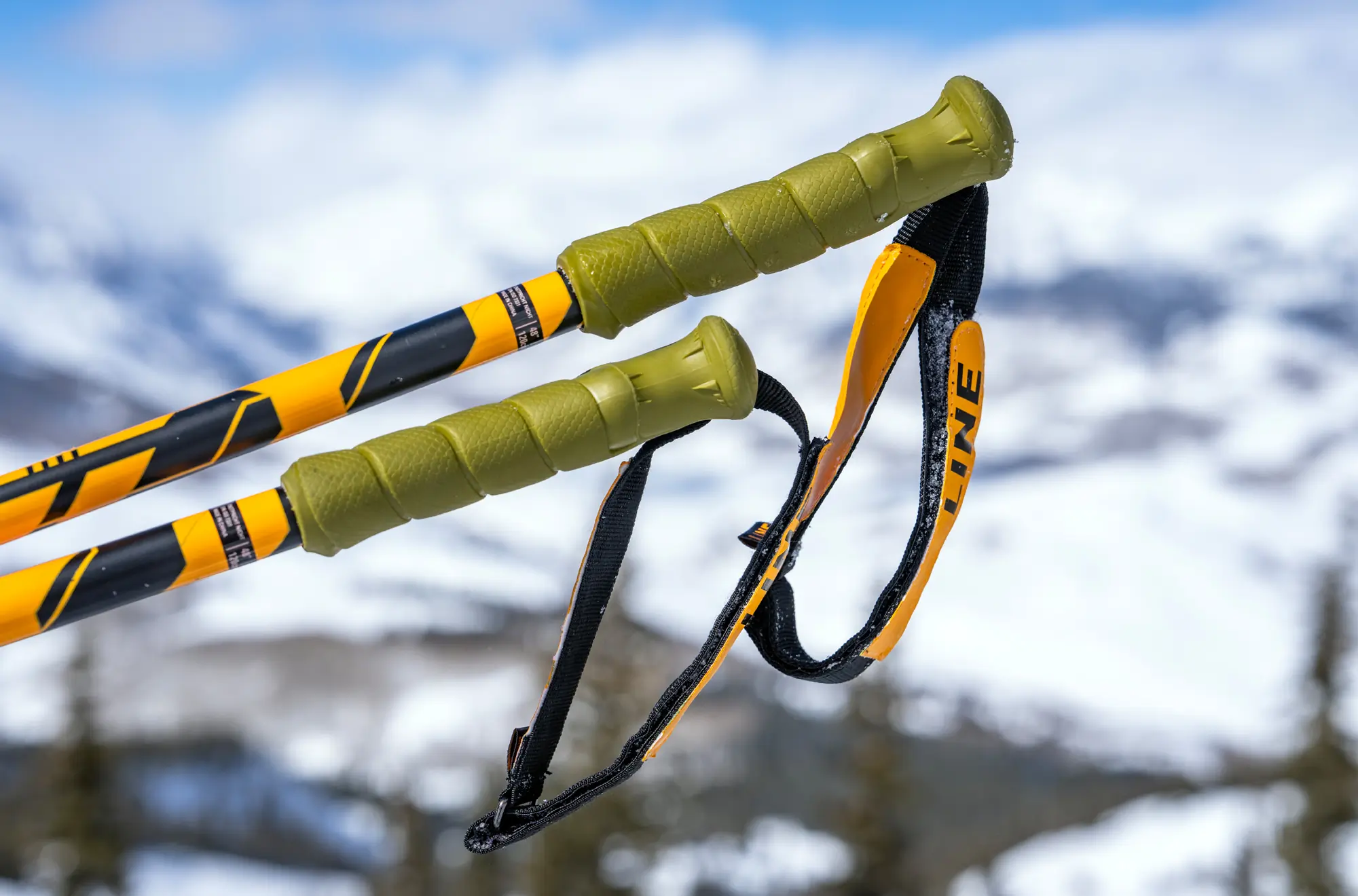



Adjustable vs. Fixed-Length Ski Poles
It’s good to know that not all adjustable poles are collapsible. Here are the nuances of pole options for the backcountry versus the resort.
Backcountry Skiing
For backcountry skiing, many skiers prefer the versatility of collapsible and telescoping poles, which are available in two-section or three-section designs. The three-part poles are most popular among splitboarders, due to the compact length that’s needed for safe and neat pack carry. Two-part poles tend to be too long and can jab a rider while hanging on the side of the pack.
While hiking uphill, the slope of the terrain occasionally demands a shortened pole length. Adjustable poles have a simple mechanism that allows you to change the total length in an instant like on the G3 Pivot Aluminum Ski Poles.
Additionally, new longer grip poles like on the Black Crows Duos Freebird allow you to shift your hand much further down the extended grip area, which can be handy in the backcountry while ascending a route and an alternative to changing the pole length.
Sometimes extending poles for long flat sections can give you better propulsion. When it comes time to enjoy the thrill of gravity, poles can then be extended back to their optimal downhill length. Just as with skis, it’s ideal that your backcountry gear is as light as possible, so poles made from carbon are often the ideal choice like in the Komperdell D’Scent Vario or Black Diamond Razor Carbon Pro.
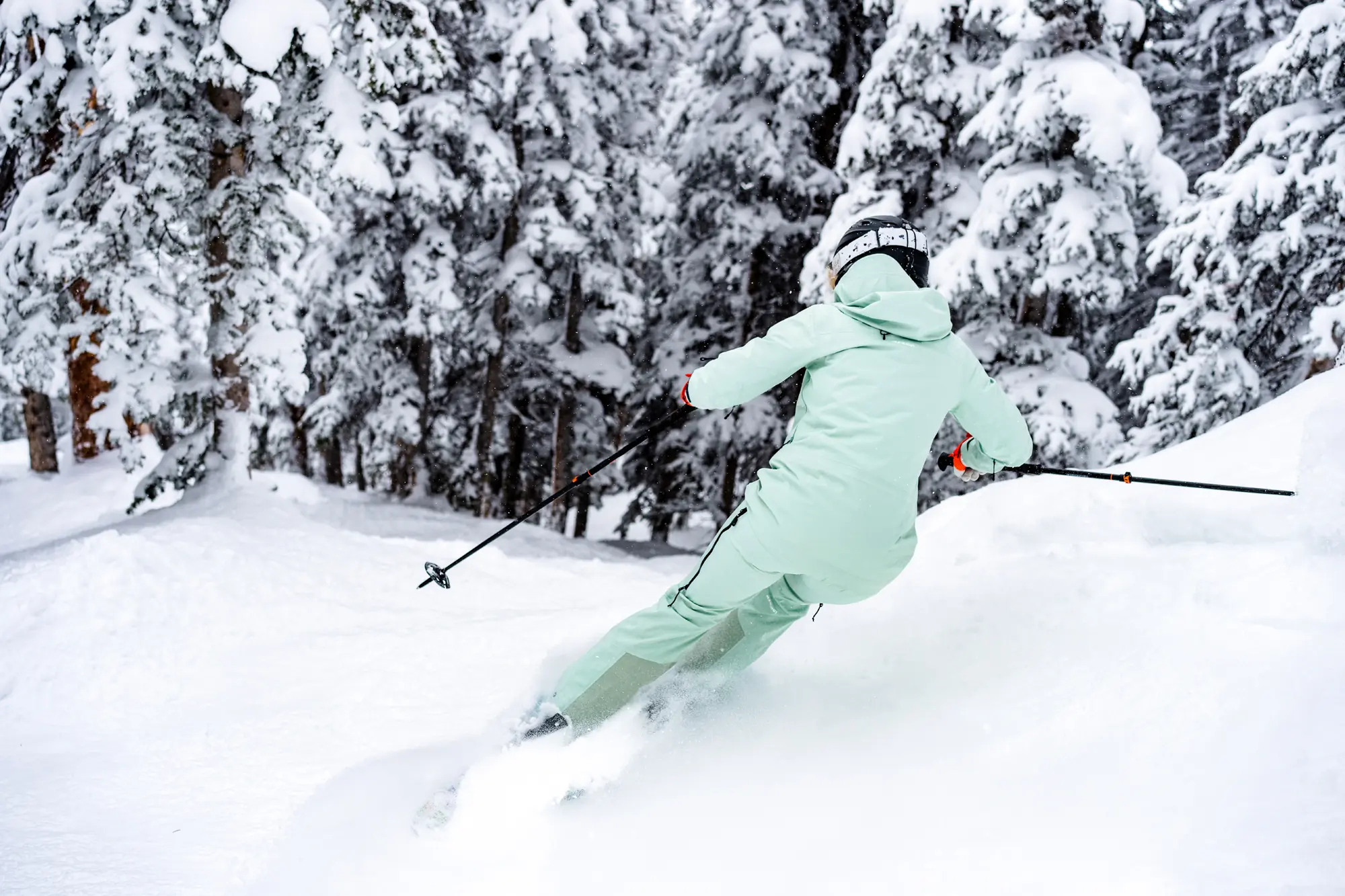



Downhill Skiing
For classic downhill skiing at the resort, fixed-length ski poles are the way to go.
Standard fixed-length poles are often much cheaper, lighter, and more durable than their adjustable counterparts without the fuss of choosing a length. For most skiers, especially those just getting started in the sport, fixed-length poles are simply the most sensible and cost-effective option. We particularly love the especially sleek Leki Artena Airfoil 3D and Neolite Airfoil as a fixed-length, resort-oriented set.
If you plan to use your poles for ski mountaineering or other activities that may call for you to stash your poles on your pack from time to time, be sure to select a pair that can fit into or onto a backpack for easy storage.
Most adjustable ski poles have relatively fragile carbon fiber components, so remember to avoid major impacts.


Ski Pole Weight
All of the ski poles on this list are pretty similar in total weight. With that said, even an ounce can make a difference in an object you’ll be carrying in your hand all day long. In general, we recommend the lightest poles that fit your needs and budget.
The total pole weight depends on the diameter and material of the shaft. Thin carbon fiber poles will be the lightest but also the most fragile. Thicker aluminum poles represent the heavier, more durable end of the spectrum. Ultimately, the right balance between durability and weight depends on your personal skiing preferences and objectives.
Although it’s made from aluminum, the Line Grip Stick, our favorite pole for the upcoming season, comes in at the lowest weight of all poles tested at a feather-light 7 ounces.
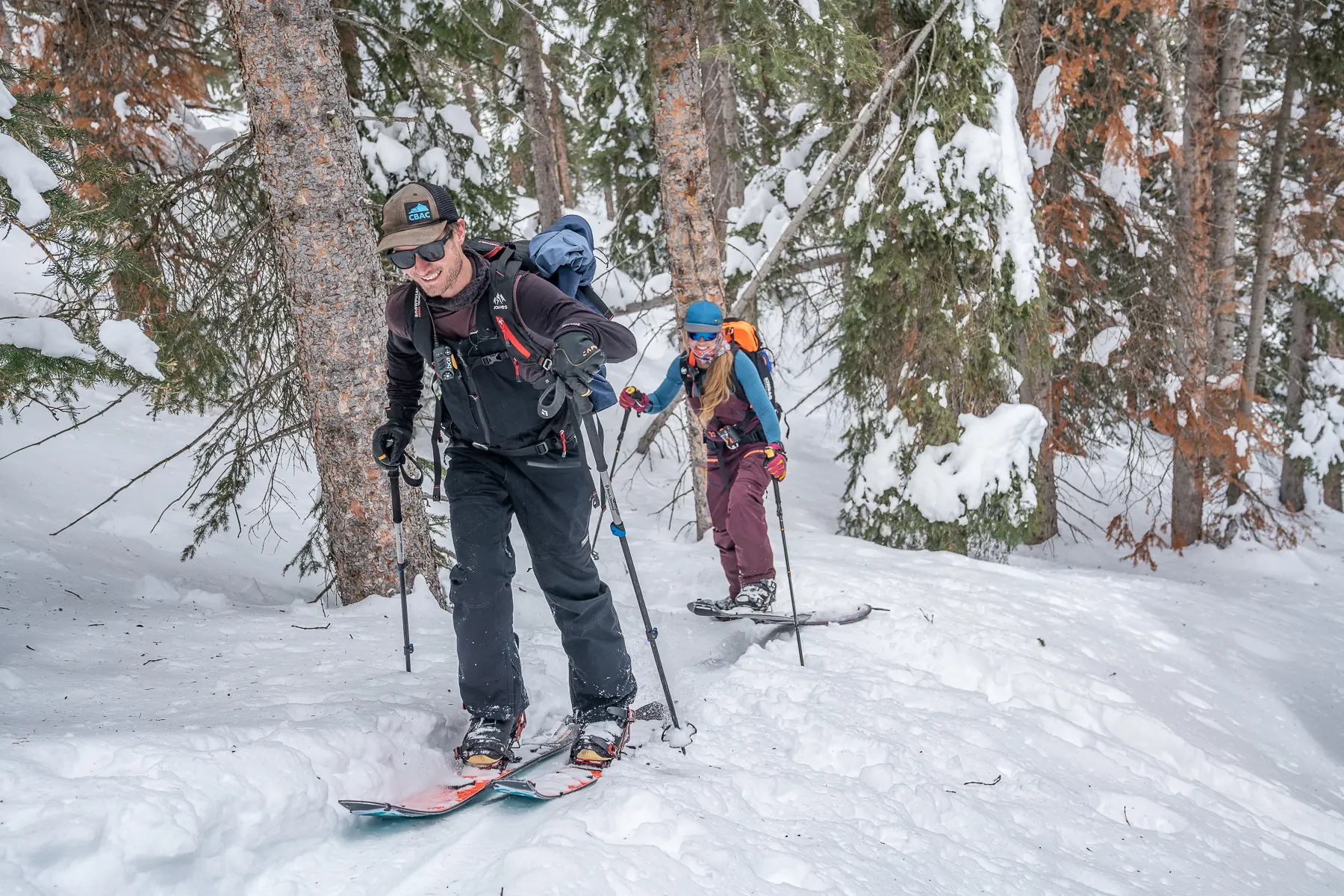



Backcountry Splitboarding
In addition to a splitboard, splitboarders need unique features in their poles for safety, efficiency, and ease of movement in backcountry terrain.
Three-piece pole designs are ideal, so the poles can be broken down and buckled or strapped to the outside of your backcountry pack while boot packing or on descents when poles are not needed.
If poles are helpful for a portion of a descent, it’s easier to ride with a folded-up three-piece pole in one or both hands, which can quickly extend if you get stuck or lose speed.
Utilizing articulated features on the handles or baskets, like on the G3 Pivot Aluminum, to help adjust splitboard bindings on the skin track is a key gear-assisted technique for splitboarders.
Other features, like the integrated scraper on the Voile Camlock 3 Touring Poles, can scrape and clear the ice and snow off the pucks, bindings, and bottom of the split skis before putting on skins.
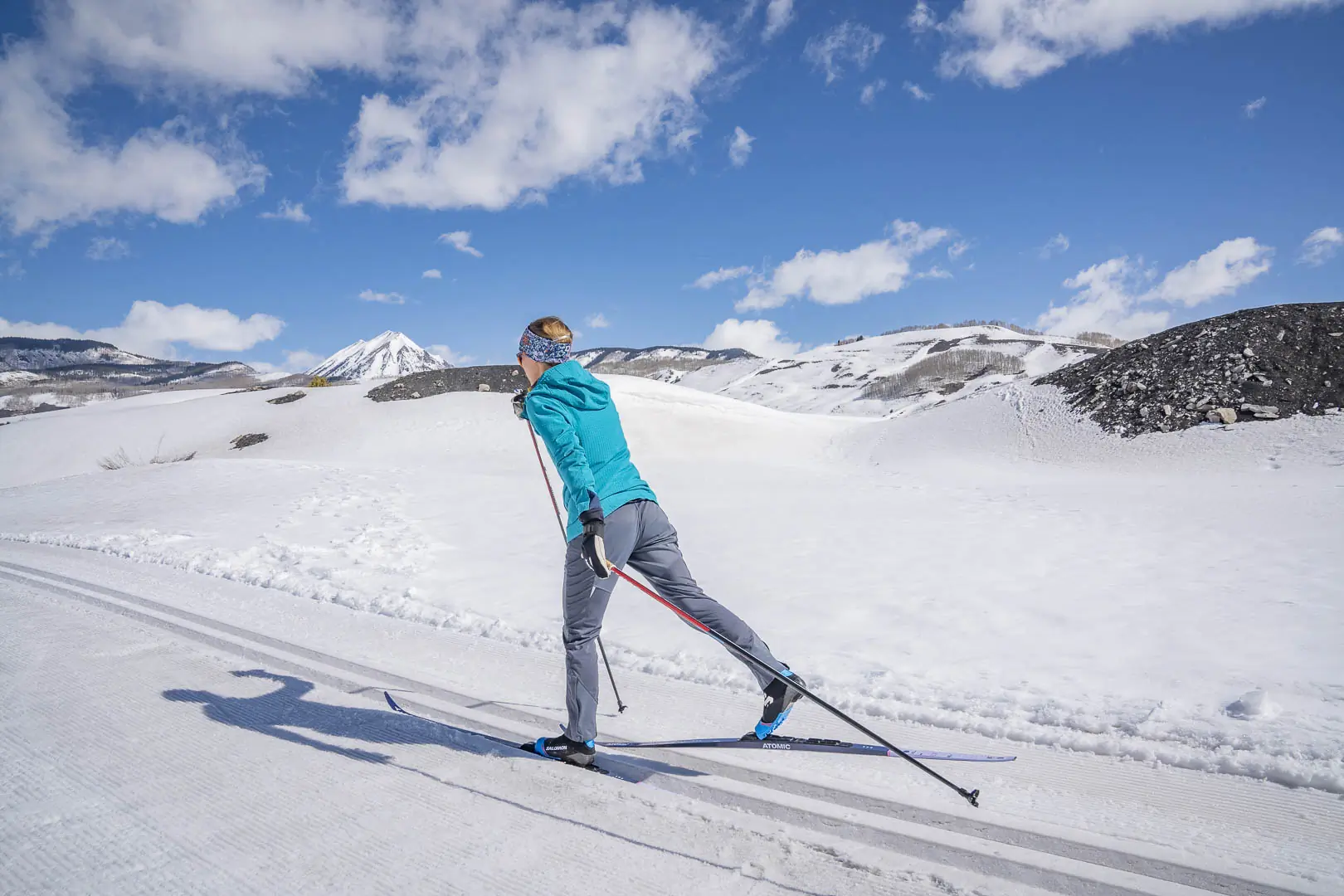



Nordic Skiing
When cross-country skiing, it’s important to use the right kind of poles. Cross-country terrain requires skiers to use their poles to actively propel them along the trail. Cross-country poles are also important for timing, power, rhythm, and balance. Like downhill poles, cross-country poles can be made from a variety of materials, including aluminum, carbon, and bamboo.
The main difference between cross-country poles and downhill poles is length. Cross-country poles tend to be a bit longer than downhill poles. This added length provides propulsion as you’re skating across flat surfaces.


Sustainability
While the ski poles listed in this guide are built using traditional construction methods and materials, it likely won’t be long until the sustainability revolution hits the ski pole space.
While aluminum is among the world’s most easily and sustainably recyclable materials, unfortunately, recycled aluminum is not typically the norm in the ski pole industry. MountainFLOW, a company known for its eco-friendly ski wax, is changing the game with the recent launch of 100% recycled aluminum ski poles. MountainFLOW didn’t miss any details: Even the grips are made from recycled wine bottle corks.
Leki, a pole manufacturer leading the game in consistently reimagining all elements of the ski pole, recently released a trekking pole made from hemp fibers that were harvested mere miles away from their manufacturing headquarters in Germany. We imagine that in the coming years, ski poles will reflect the innovation in recycled, sustainable materials.
If you’re looking to make your kit all around more environmentally friendly, we’ve compiled a list of the most sustainable ski gear.
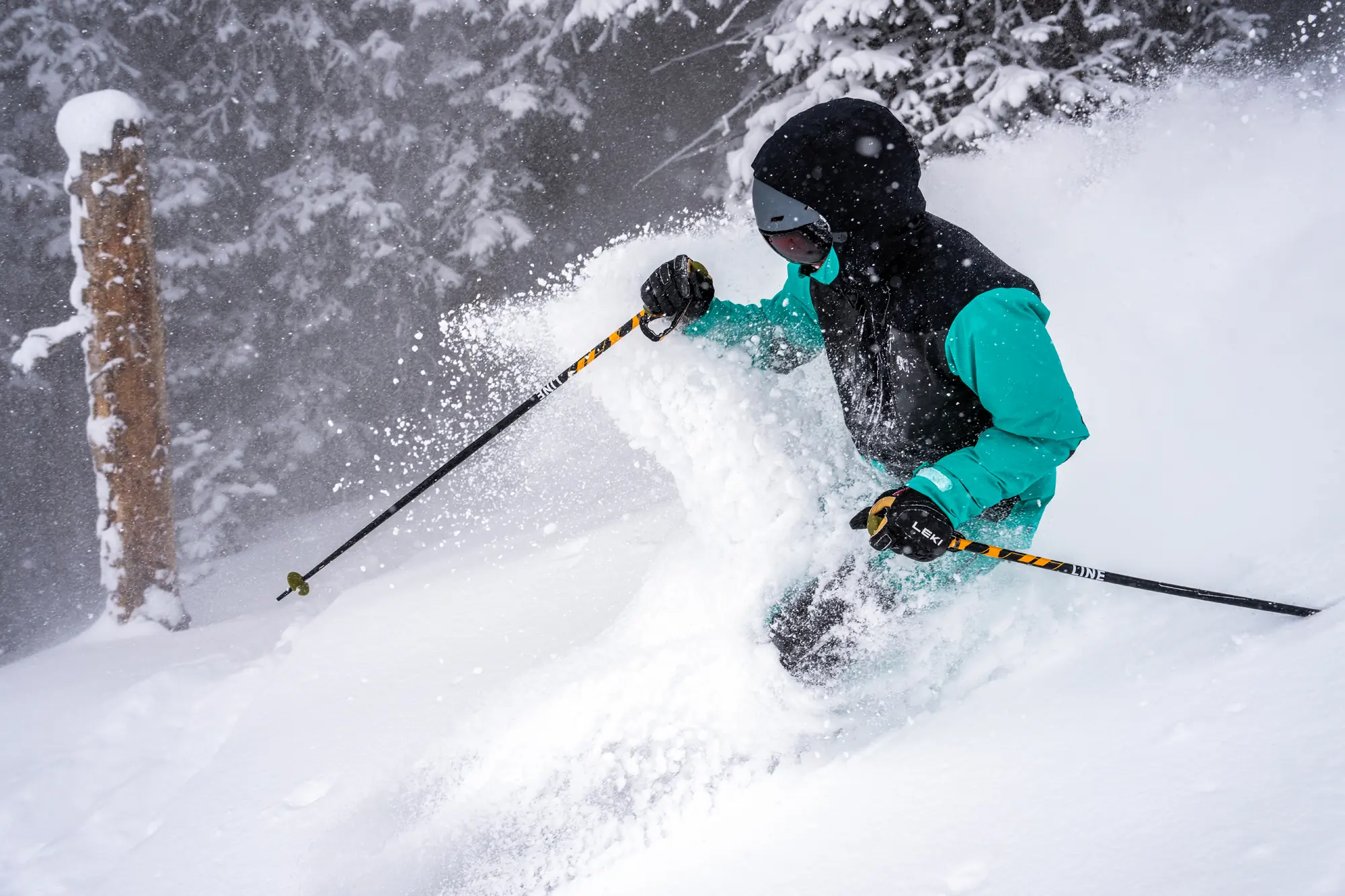



Price & Value
As with every piece of gear, ski poles come in at a wide range of pcies. Don’t feel like you need the fanciest or lightest option just to get started on the slopes. Not breaking the bank is a major consideration for most when trying to decide on the right ski pole.
Budget
The Black Crows Meta ($69) is a solid option that is the most affordable ski pole in our test. The Leki NeoLite Airfoil ($95) is a perfect set of poles for on-piste skiers and rings up at a budget-friendly price. Among our favorite poles, the Line Grip Stick ($90) comes in at a reasonable price. If you’re looking to try out a bamboo ski pole, the Custom Meier Handmade Ski Poles ($120) is likewise a fair cost.
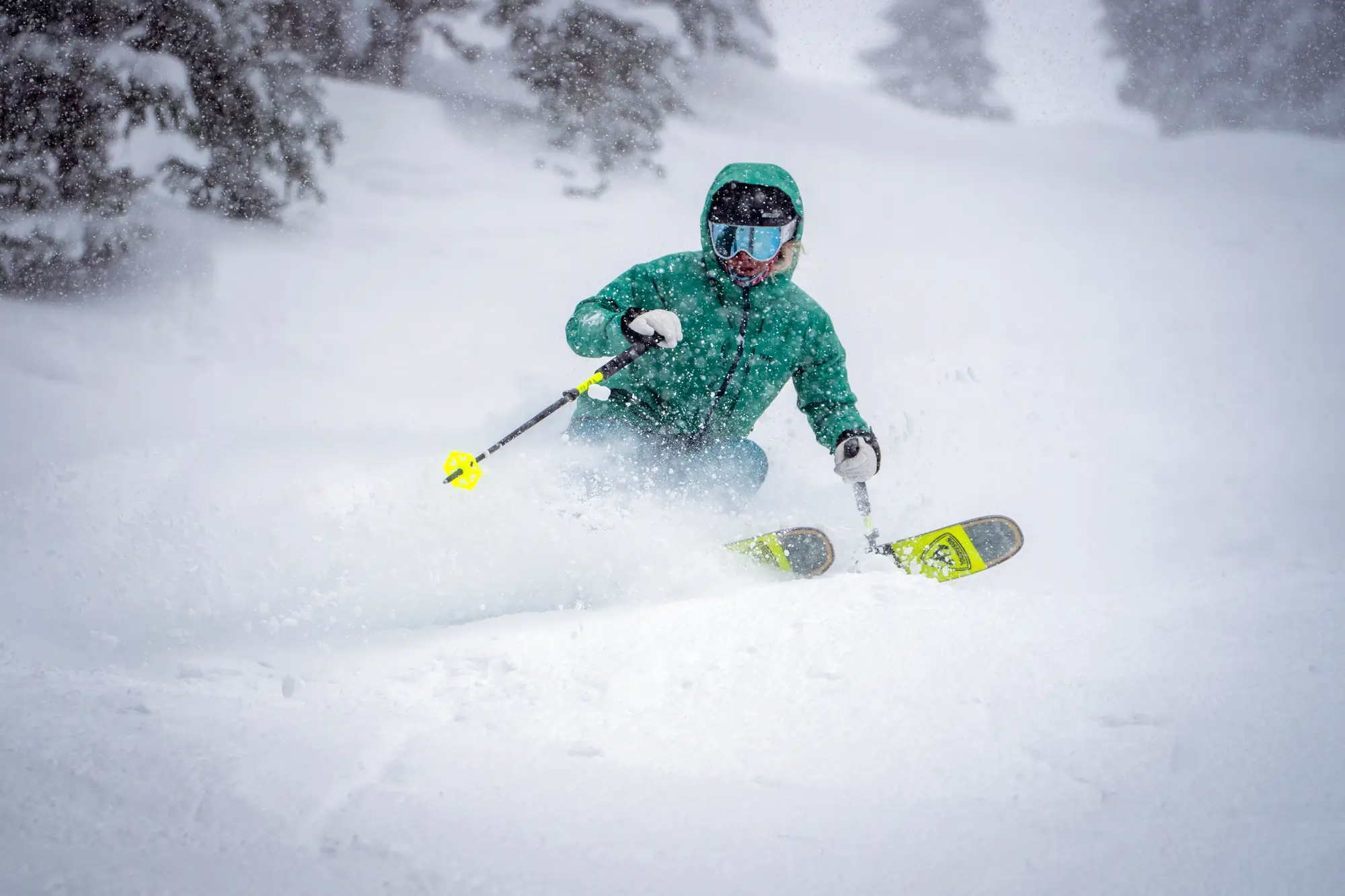



Mid-Tier
If you spend more than 50 days on the slopes each season, including in the backcountry and sidecountry, you may want to consider a more versatile, higher-end option. The bulk of ski poles on the market, especially adjustable models, cost somewhere between $115 and $165. The Voile Camlock 3 Touring Poles ($115), Leki Artena Airfoil 3D ($145), and Line Vision Poles ($150) are a few of our favorites.
Premium
You can expect to pay a premium for lighter materials like carbon, extra features, and collapsible adjustability. While more expensive, the G3 Pivot Aluminum Ski Poles ($166), Leki Spitfire Vario ($165), and Black Diamond Razor Carbon Pro ($200) all deliver a lightweight, high-quality product for advanced skiers and backcountry riders.
Also on the high end of the spectrum, the Komperdell D’Scent Vario ($190) and Black Crows Duos Freebird ($189) — two of our favorite ski poles for the backcountry — are quite pricey but worth it for those who dedicate many days a season to skiing.
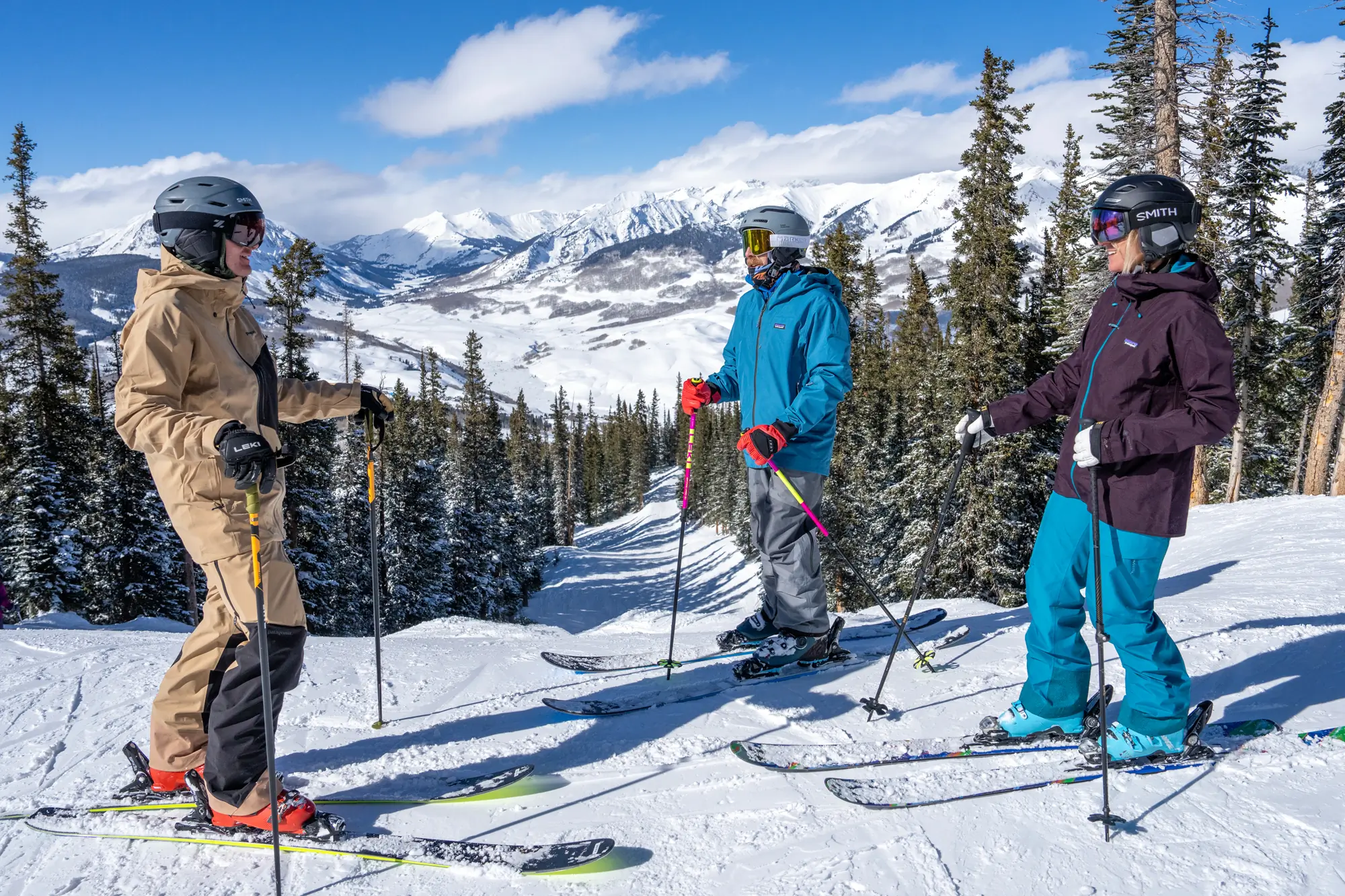



Frequently Asked Questions
It’s possible to downhill ski without poles. However, there are a number of fundamental reasons why poles are the norm for almost every style of skiing.
Perhaps the most important benefit of ski poles is improved balance. For beginner skiers, the downhill pole can be used as a “pole plant,” providing a fixed point to turn around when executing tight turns. As skiers progress from beginner to intermediate, poles are crucial for developing refined technique and parallel turns.
On flat and uphill terrain, ski poles can be used to push off of and generate momentum. Skiers typically use their poles to push themselves along on low-angle cat tracks and in the lift line. In short, ski poles are pretty darn useful, and it’s ideal to have them rather than not.
Beginner skiers should have properly fitted poles that are both durable and comfortable. Generally, it’s not necessary for beginner skiers to own expensive carbon fiber poles. A simple pair of fixed-length aluminum poles will do the trick — just make sure they’re the correct size.


Ideally, backcountry ski poles are generally more lightweight and adjustable. When hiking uphill on a skin track, it’s nice to be able to shorten your poles to the length the terrain calls for. Once it’s time to ski downhill, adjustable poles can extend to the optimal length.
Because backcountry skiers spend a significant amount of time traveling uphill, minimal weight is a plus. As a result, most high-end backcountry ski poles are made from carbon fiber components.
Additionally, some backcountry poles have a secondary grip that can be used to choke up on the pole when hiking uphill or traversing across a steep slope. Resort ski poles tend to have a fixed length and are usually made from robust aluminum or bamboo.
Carbon fiber ski poles are generally more fragile than aluminum poles. While aluminum poles will bend before they break, carbon fiber is prone to splintering and shattering upon significant impact.
Modern carbon fiber ski poles are plenty strong for most people’s needs. However, if you plan to huck huge cliffs and ski fast between trees and boulders, you should be cautious with carbon poles.


A ski pole basket keeps the pole from sinking deep into the snow. For this reason, baskets are very important, and we don’t recommend skiing without them. If you plan to ski powder, be sure to use baskets with a large diameter that will keep your poles from penetrating too deep into the snowpack.
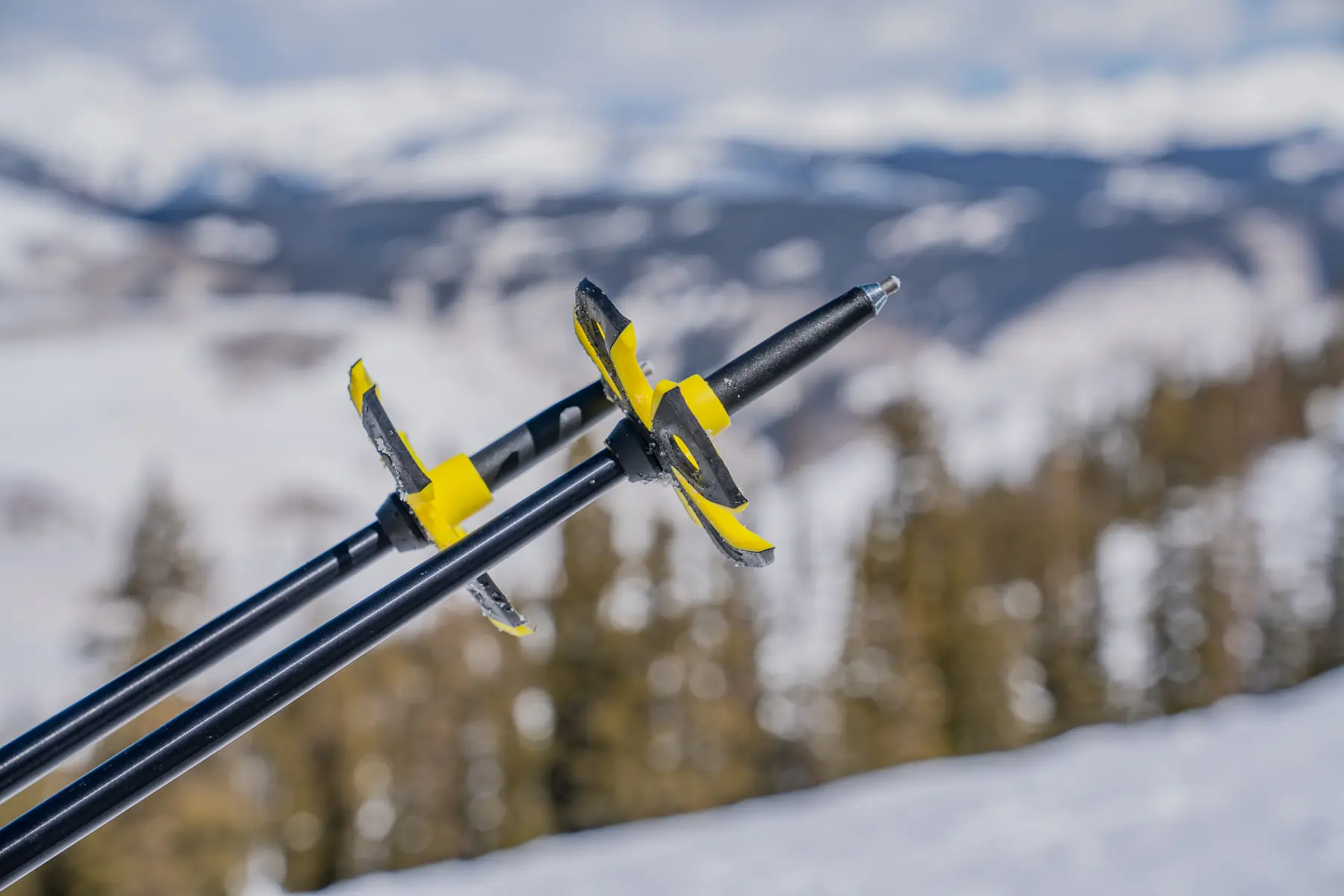



While pole straps can be handy on the resort for ease of pole planting and not dropping your poles, or loosing them if you fall on a deep powder day. However, there are also some cons of pole straps, especially when skiing in the backcountry. Poles can be a hazard when skiing in avalanche terrain or through tight trees, where they might get caught and cause a shoulder injury.
When trying on poles, it’s best if you’re able to try on the straps with the gloves or mittens you’ll use while skiing to make sure that they fit. Innovative new systems, like Leki’s Trigger 3D system, integrate directly with your glove via a releasable loop mechanism, allowing for the best of both worlds.
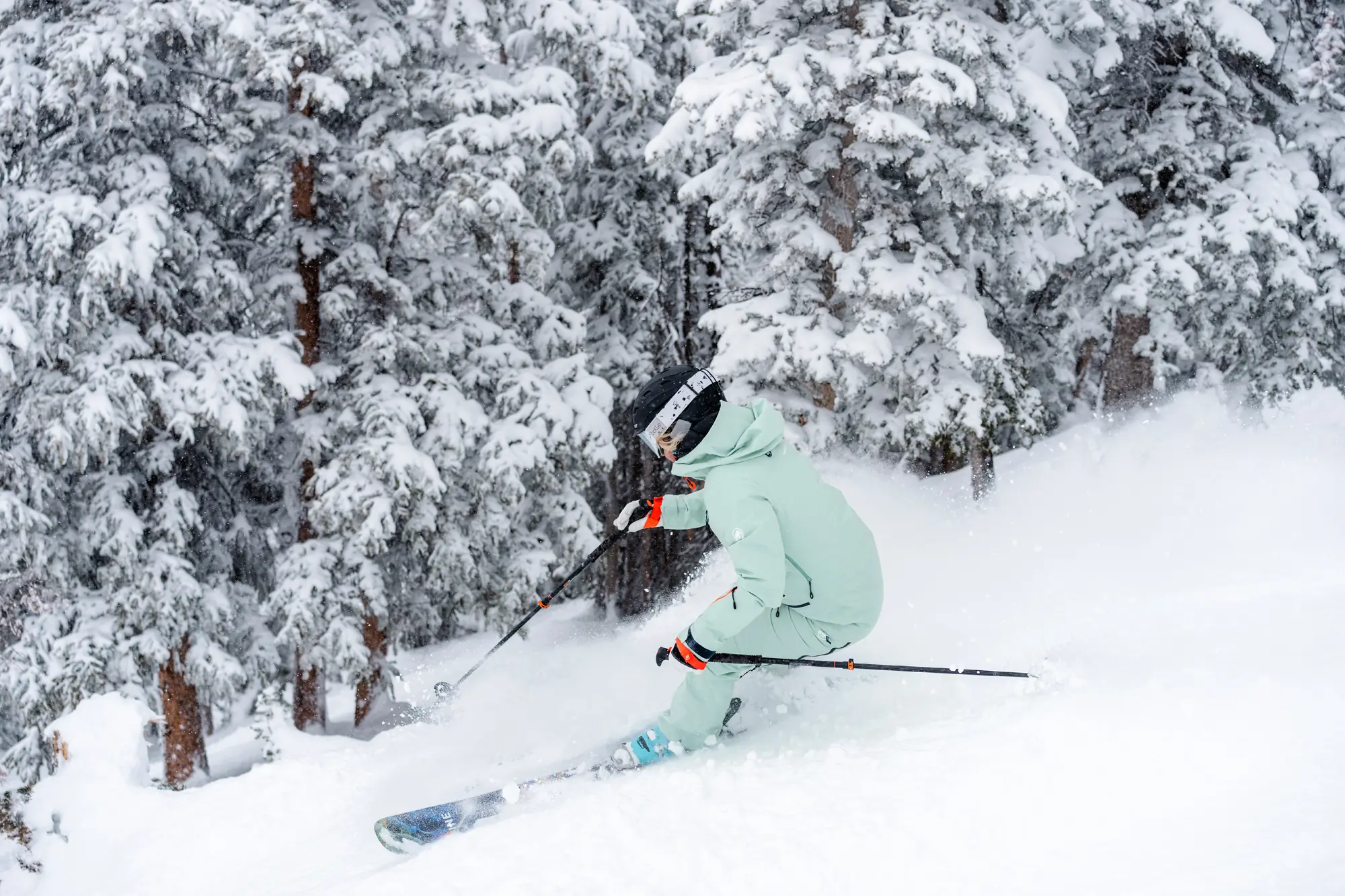



For terrain outside of where the lifts are spinning, snowboarders will benefit massively from riding with poles and will save themselves from lots of time spent bootpacking and shuffling.
In the side country, having a pair of three-piece collapsible poles stowed away in a pack can help you quickly pole through flat sections where you might otherwise be stuck.
Otherwise, split boarders will need poles just like backcountry skiers to help them to hike uphill. Finding a pair that breaks down to fit neatly inside your pack while riding makes poles stowable and convenient, like the Voile Camlock 3 Touring Poles.


The Best Ski Boots of 2025-2026
Our experts tested the best ski boots including downhill, hybrid, and backcountry pairs from Tecnica, Salomon, Nordica, and more.
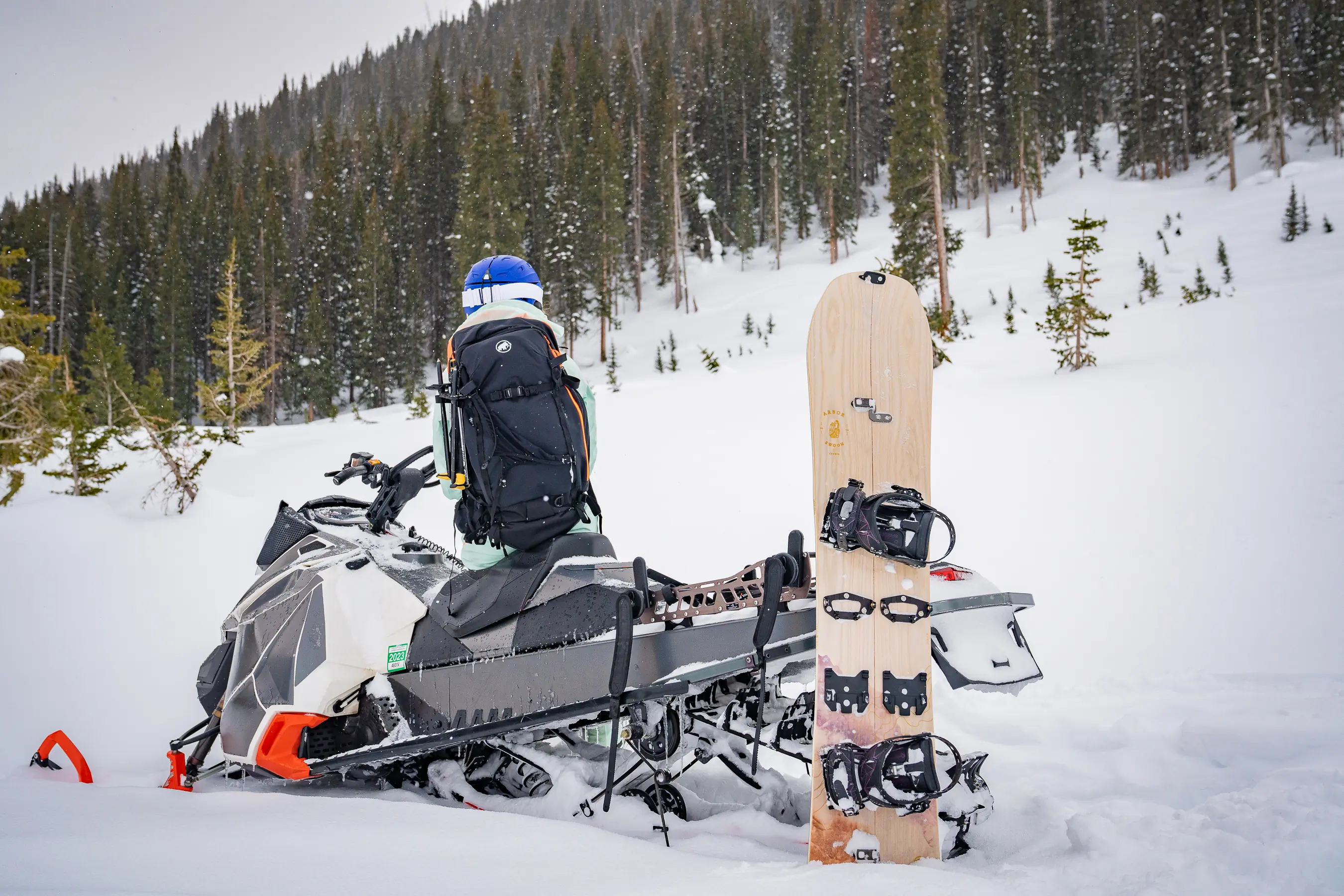

The Best Ski Backpacks of 2025-2026
From small ski packs for lift-access to behemoths built for serious backcountry use, we found the best ski backpacks for every budget.
